-
Posts
2,101 -
Joined
-
Last visited
-
Days Won
2
Content Type
Profiles
Forums
Blogs
Gallery
Events
Store
Posts posted by Rusty Greaves
-
-
As part of my documentation of the use of the original 1917 U.S. Dept. of State Special Agents' Division badges' design, here is another use of the iconography adapted by the current U.S. Dept. of State Diplomatic Security Service. Although not a badge (as there are still only 2 currently know original authentic examples of the 1917-design badge), this contributes to examples I have illustrated here of the continued importance of this original design to the modern DSS.
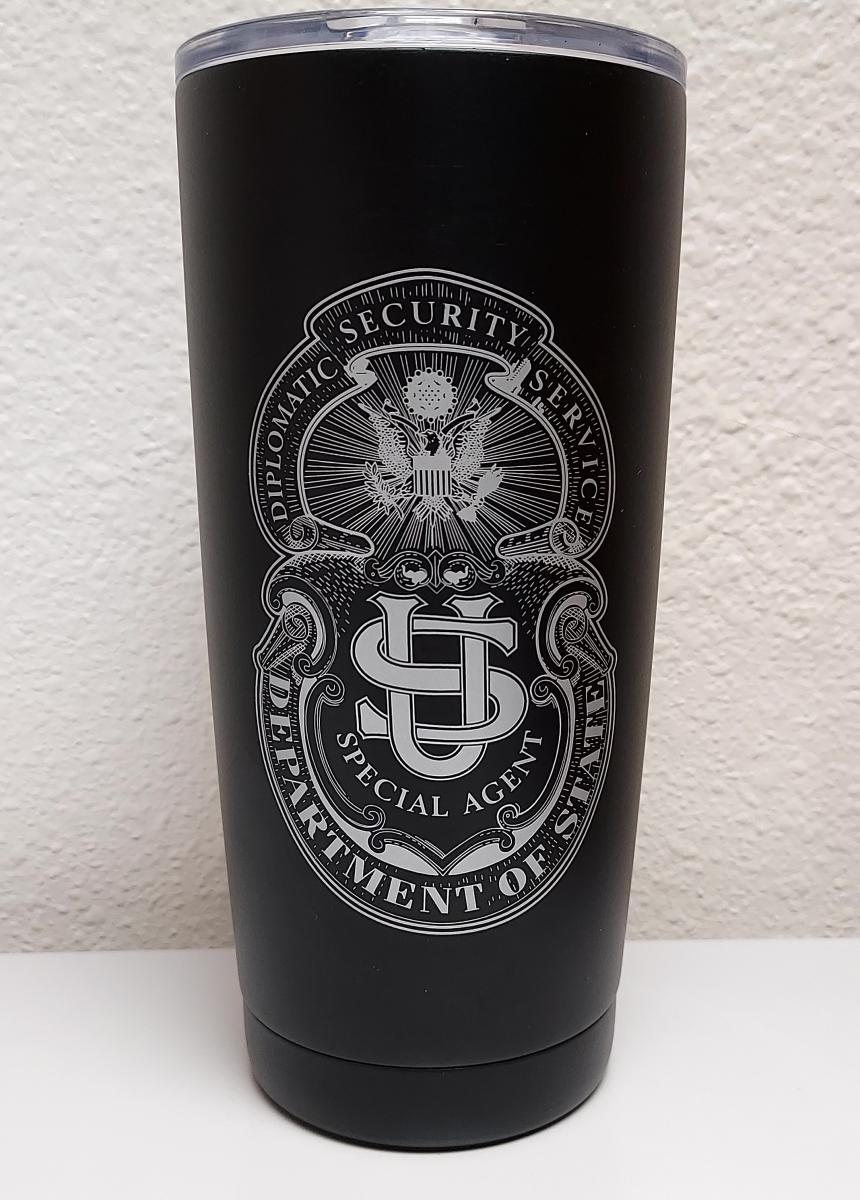
This is an image of the 20 oz. tumbler available from the DSSAA online shop (https://dssaa.org/store-back-end/ols/products/new-stainless-steal-tumbler). This uses a very good adaptation of the original 1917 badge design for this Diplomatic Security Service Special Agent logo. The emblem is based on the form of the design used on the restrikes of the original badge (compare with the 1st photo in my post of 25 March, 2017 and the 1st image in my post of 10 May, 2022), modified for the DSS. Cheers!
0 -
The small "badge" I showed is not any form of official or commemorative DSS badge. A couple of DSS Agents told me that it is a lapel pin that was, at least formerly, available at the Diplomatic Security Special Agents Association (DSSAA) online store (https://dssaa.org/store-back-end/ols/products). The lapel pin is no longer identified as available online, but similar cufflinks that use a modified design of the original 1916/17 design as a DSS emblem are listed.
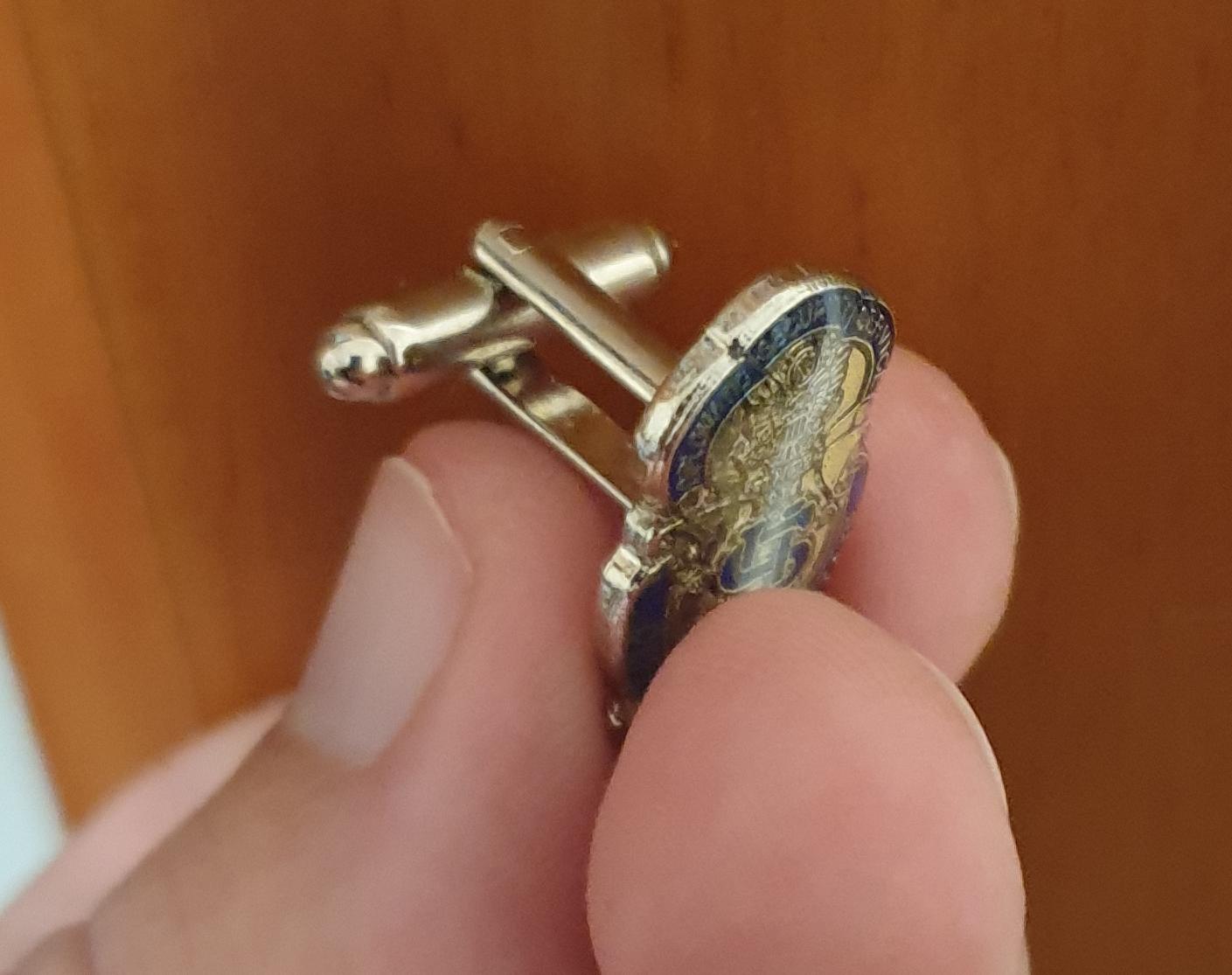
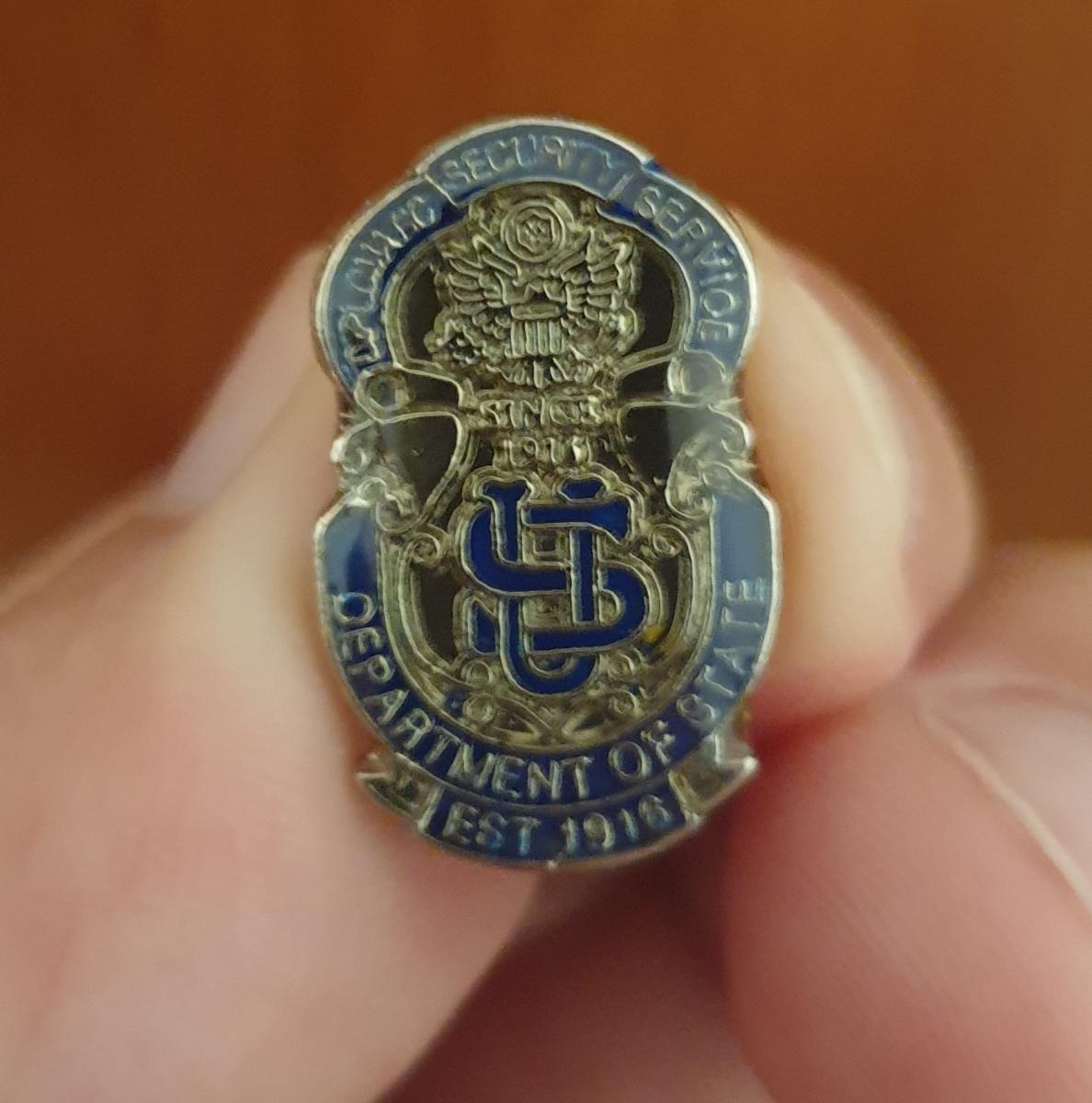
The above 2 images are from a DSS Agent, showing the form of these cufflinks using elements of the original 1917 badge design. Some of the cufflinks are coated in a clear epoxy (as is the above example), others are not.
In addition to the cufflinks (https://dssaa.org/store-back-end/ols/products/cufflinks-silver-badge), the DSSAA online store offers an insulated tumbler emblazoned with a version of the original badge design (updated as a DSS badge: https://dssaa.org/store-back-end/ols/products/new-stainless-steal-tumbler) and a coin with a similar DSS badge logo (not currently available) based on the original badge design (https://dssaa.org/online-store).
0 -
The owner of the restrike from U.S. Militaria Forum, Cobra 6 Actual, just sent me a couple low-resolution images of the reverse of that restrike. It is marked: "V.H.B. STERL". "V.H.B." is Blackinton's hallmark, and "STERL" of course indicates it is sterling silver. After some of the ambiguous information from my enquiry with V. H. Blackinton & Co. out of Attleboro Falls, MA it is nice to have this clear confirmation that Blackinton did create some of the restrikes, probably in the 1980s-1990s. I made an enquiry with Blackinton about whether they had manufactured any of the restrikes as a way to also find out whether they knew anything about the original dies for the 1917 badge. I mentioned what I found out from Blackinton in the 5th paragraph (the 2nd paragraph under the third illustration) of my post of 24 March, 2021 on this thread.
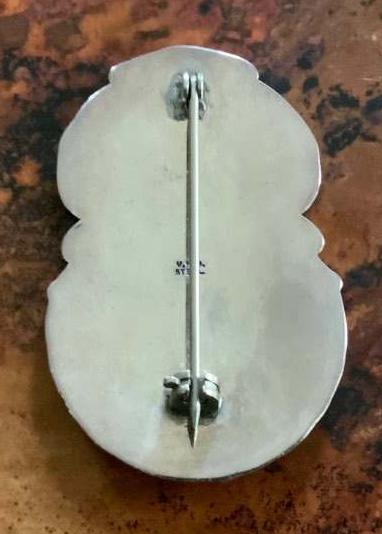
Illustration of the reverse of the restrike whose obverse is shown as the 2nd-to-last photo in my post here of 10 May, 2022. This shows the use of a similar pin to the original badge.
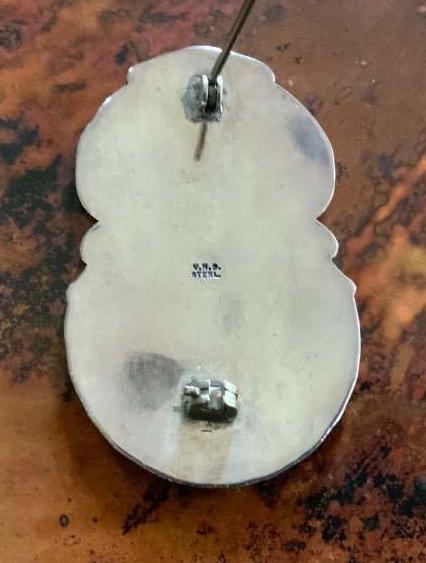
Image of the reverse of the same restrike with the tunic pin opened. It shows the hallmarks in low-resolution, reading "V.H.B." the hall mark for V.H. Blackinton & Co., Inc. of Attleboro, MA who cast at least some of the restrikes (probably from the late 1980s-1990s). The "STERL" indicates this restrike was made in silver, unlike the original badge that is probably either nickel or nickel-plated.
0 -
If the 61 mm "silver medal" refers to the item on the right of the 2nd photo in the post by chechaco1 of 1 April, 2021 - the design is adaptated from a coin. The design was employed on coins of several denominations (5 [18 mm], 10 [24 mm], 25 [30 mm], 50 [40-44 mm] platers) and those coins were first minted in 1964 (same date as on the item in chechaco1's photo). The less-detailed image on the item in chechaco1's photo compared with these coins also is inside of a frame and the arrangement of the inscription is different on the images coins (i.e., with the 1964 date in the lower inscription). The rays of the sun are more abbreviated than on the 4 different denominations of the coin, the rocks supporting the power lines (right side) are not as detailed as on the coin, the water flow from the base of the dam and the left back also are less-detailed than on the coin. The height of the background Nile is greater on chechaco1's photo than on the coin as wel and parts of the overall image are cut off to fit the adaptation of the coin's image of the Aswan High Dam into the smaller central frame. As there is no suspension device this is unlikely a medal, might it a souvenir piece employing a less-skilled replica of the design on the 1964 coins?
Images are from a post of 28 July, 2017 by yellow88 on the coincommunity.com website (https://www.coincommunity.com/forum/topic.asp?TOPIC_ID=293336).
0 -
I recently came across 2 images of replica badges (both probably issued by the Dept. of State) based on the design of the original design of the 1917 US Dept. of State Special Agents' Division barge. The first is another example of one of the commemorative restrikes. The second is an alleged miniature badge based on the original Special Agents badge design that may have been a commemorative item issued by the US Dept of State Diplomatic Security Service.

Above is a moderate-resolution image of a restrike of the original badge design with blue enamel. Compare this example with the other restrikes illustrated here in my posts of 25 March, 2017 and 20 March, 2021. This image comes from a posting of 10 July, 2021 by Cobra 6 Actual on the U.S. Militaria Forum (https://www.usmilitariaforum.com/forums/index.php?/topic/336271-badge-collection-military-government-police-fire-some-help-needed-too/page/2/). The person posting felt this was an original badge, and notes that the reverse is marked "Sterling", although no photo is provided of the reverse. The original badges were not silver, and as seen on this thread the reverse should also have the badge # and the inscription: "THIS BADGE CONVEYS NO AUTHORITY UNLESS ACCOMPANIED WITH COMMISSION OF SAME NUMBER SIGNED BY THE SECRETARY OF STATE". No date is available for the issuance of this badge. The person posting this wrote me that her thought the reverse also is marked "1917". This would be of interest to me, as the DSS normally refers to this as the 1916-design, although my best indication for the initial manufacture and distribution of this badge is 1917.
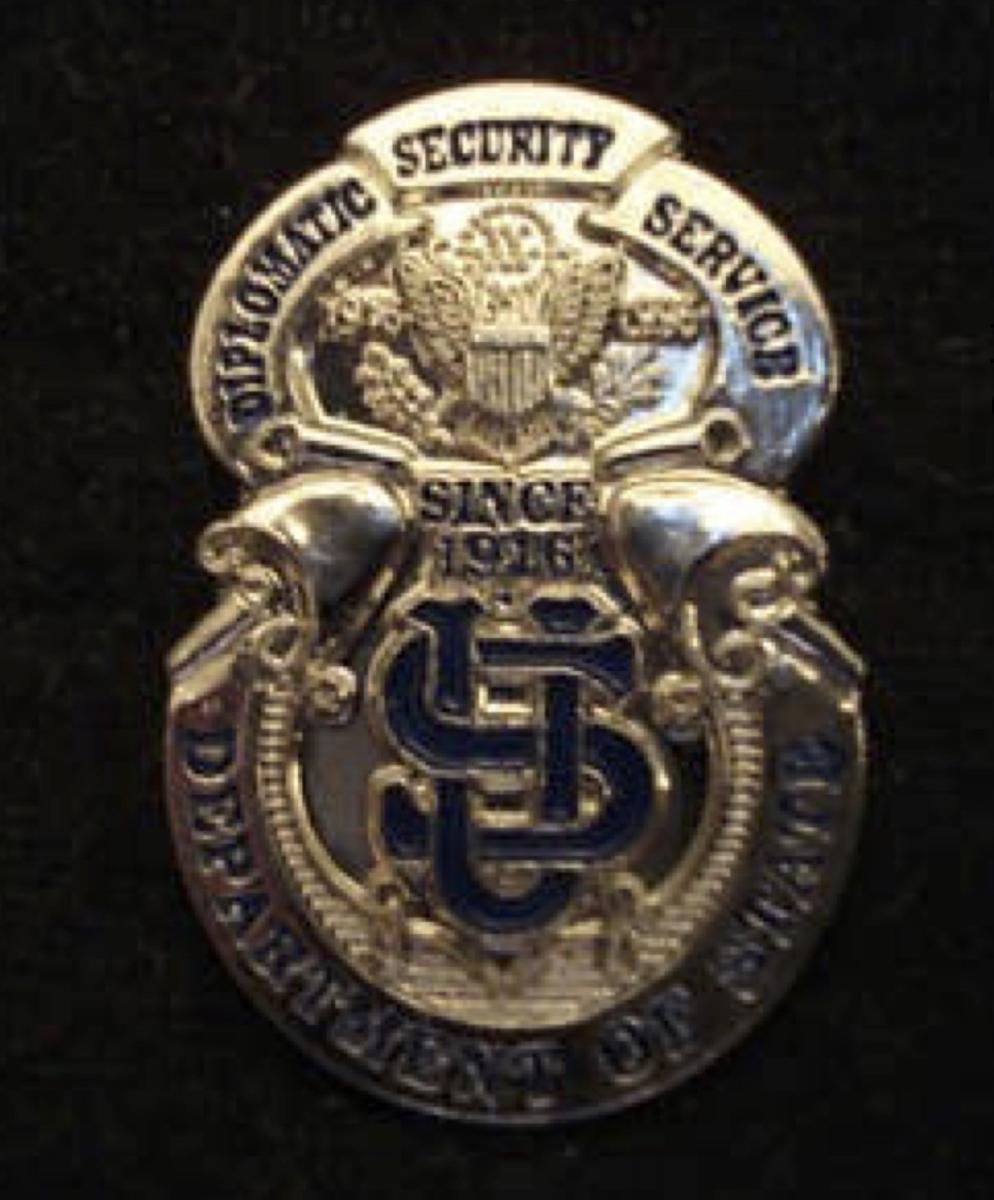
Low-resolution image of a miniature badge or pin that was supposedly issued by the US Dept of State Diplomatic Security Service. This image comes from an eBay auction of 5 December, 2010 archived on the WorthPoint.com website (https://www.worthpoint.com/worthopedia/diplomatic-security-1916-145729249). The description states that it may be silver plated ("polished silver") with blue enamel. The auction description gives a measurement of the width as 1 inch, but does not provide the height dimension. The date when this commemorative badge was issued is not provided, but I am pursuing some leads to try and get some additional information.
0 -
Below are 2 images of a breast star of the Order of Ismail made by Worth/DaCosta for a monarchy-in-exile award by Fuad II. I have seen photos of one other set of the Worth/DaCosta Order of Ismail (probably a 2nd Class set with miniature). The breast star in that set has the same design execution as that shown below, the probable neck badge also is made similarly (but is a star without the rayed embellishment as seen in Lattes and Bichay-made examples prior to the dissolution of the monarchy), and the miniature has a much abbreviated form. There is no need to comment on the jarringly cartoonish adaptation of the original design for this monarchy-in-exile award. The ELM monarchy-in-exile award (see the illustration in my post of 22 April, 2018 and the comments by 922F in his follow-up post of the same date on this thread, as well as his mention of ELM and Worth in his post of February 22, 2019, also on this thread ) is more true to the original design, although it's wreath is unsatisfyingly lacking in any relief. The other photos I saw of Worth/DaCosta-made Order of Ismail monarchy-in-exile-insignia were shared with me confidentially, so I am unable to illustrate that set here. Those other photos also included an image of the exterior upper lid, identifying Worth as a Paris supplier of Egyptian Orders to Fuad II (922F mentions that Worth has an office in Lisbon, as does DaCosta). The name " WORTH" with the "O" decorated with something resembling a flower and the inscription ".925" identifying the silver purity is shown in those photos shared with me on the reverse boss of the central medallion of a piece that is probably not an Order of Ismail nor probably any Egyptian medal (see the photo of a slightly different form of the "WORTH" name contributed by 922F in his post of 22 February, 2019 on this thread). Those shared photos also showed the mark for DaCosta on the hinge of the breast star's tunic pin: "FREDERICO COSTA, LDA, CONDECORAÇÔES, R.S. JULIÃO, 110·30, LISBOA".
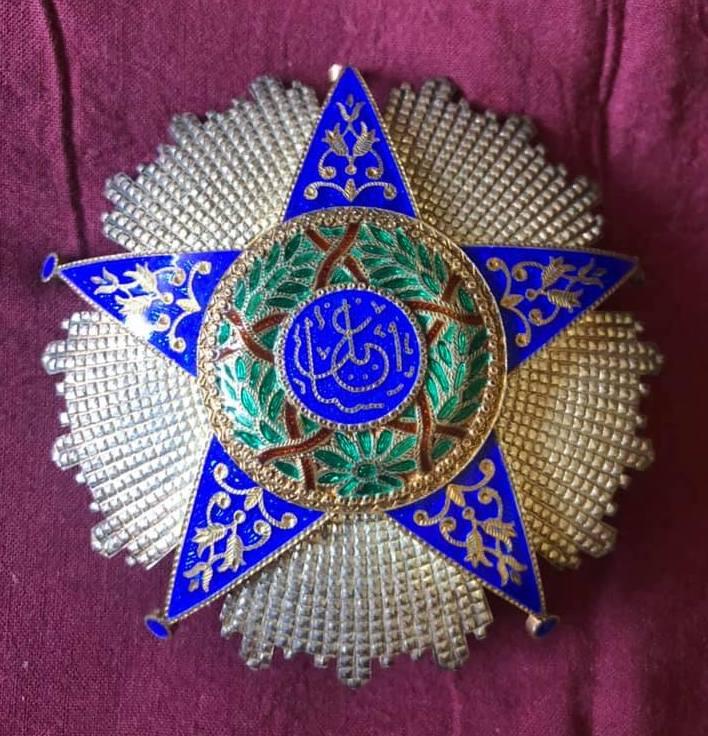
Photo of the obverse of a Worth/DaCosta made Order of Ismail breast star made as an award-in-exile for distribution by Fuad II. This photo can be zoomed for a bit of additional detail. This image was posted on a Facebook public group page: "ARABIC MEDALS & MILITARIA اوسمة ونياشين عربية عسكرية" (https://www.facebook.com/groups/434957140007223/), it was contributed by Vitor Escudero on 26 June, 2021 (https://www.facebook.com/photo/?fbid=4415014665189917&set=pcb.1862455247257398). Escudero also posted several images from a 1947 French language edition of the Protocole: Royaume d'Egypte. The finials of the superior arm, the lateral arm on the viewer's right, and the lower right arm appear to have been bent somewhat backward. The other photo I have seen of a Worth/DaCosta breast star also shows the curvature of the arms and the orientation of the finials toward the reverse as seen on the undamaged lower left and central left arms of the above example.
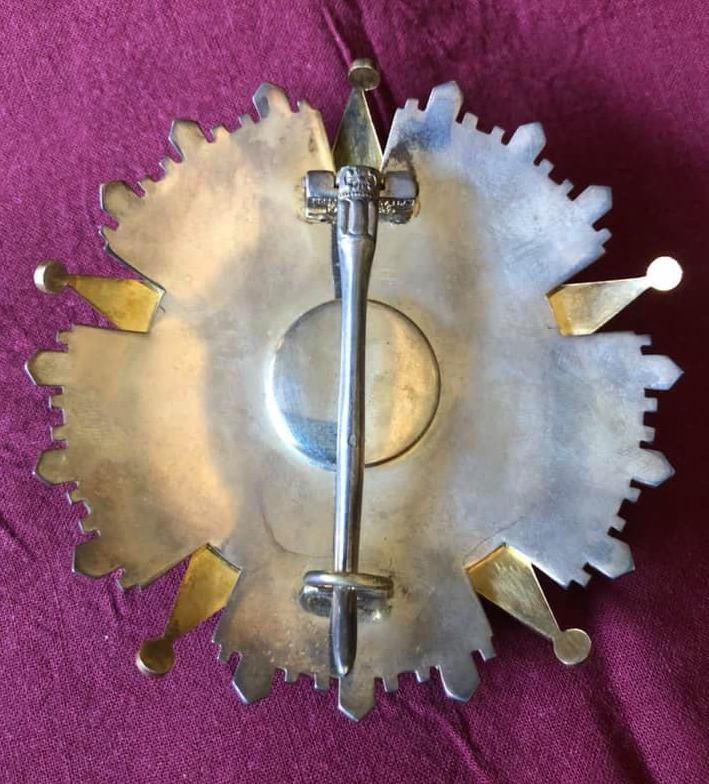
Image of the reverse of the same breast star of a monarchy-in-exile version of the Order of Ismail made by Worth/DaCosta. Although not legible in this photo, the DaCosta name can be partially seen on the hinge of the tunic pin. The mark at the proximal end of the tunic pin near the hinge is difficult to distinguish in this image. The bent condition of the finials of the superior, central left, and lower left arms (in this view) is more apparent in this image of the reverse of the star. There are slight differences in the treatment of the reverse between this example and the other photo I have seen (where the reverse is rugose not smooth as in the above example; the decoration of the proximal end of the tunic pin is somewhat different; and the other example has deeper triangular cutouts in the rayed embellishment for the gold arms of the central star).
0 -
Welcome to GMIC thomastheone! All of us hope you enjoy browsing & contributing to the Forums.
NumIs, I believe that you are correct that there are calligraphic flourishes on the Girt Roots name seen on the "G" of "GIRT", the "R" of "GIRT", the "R" of "ROOTS", and the "S" of "ROOTS". The reverse of the Roots medal is easy to examine in enlargement. It is harder to be certain whether there is some kind of embellishment to the final "G" of "KEIBERG". My current feeling is that there is no comparable flourish on the Keiberg "G" as seen on the Girt Roots name, and the mark appears to be related to discoloration associated with the word "FIELD".

High-resolution image of the reverse of the Sir Harry Smith Medal for Gallantry 1851 to Girt Roots. From the 20 July, 2017 auction (Lot 862) archived on the Dix Noonan Webb website: https://www.dnw.co.uk/auction-archive/past-catalogues/lot.php?auction_id=455&lot_uid=295314). This image can be enlarged to further examine the calligraphic flourishes that Numis noted in his 27 March, 2021 post here.

Lower-resolution cropped image of the reverse of the Sir Harry Smith Medal named to "JOHN KEIBERG", from a 24 July, 2018 auction (18002, Lot 236) by Spink: https://www.spink.com/lot/18002000236 (also archived on the salesroom website: https://www.the-saleroom.com/en-gb/auction-catalogues/spink/catalogue-id-srspi10178/lot-65be9677-5c0a-4733-836e-a914011ee946). This image can be enlarged slightly, but it does not fully resolve whether there is a comparable calligraphic flourish on the "G" of "KEIBERG". My inference is that the mark is not an engraved embellishment but is part of the staining associated with the relief inscription "FIELD". The Keiberg medal shows the smaller lettering of "...IN THE..." (die #!?, as discussed by Mitchell 1955 pg. 239) compared with the larger inscription of these same letters on the Girt Roots reverse above (is the Roots medal reverse die 3, the potential existence of a full stop at the end of "FIELD" is obscured by the soldered attachment remnants; or may it be die 4?, but it is not cracked die 2).
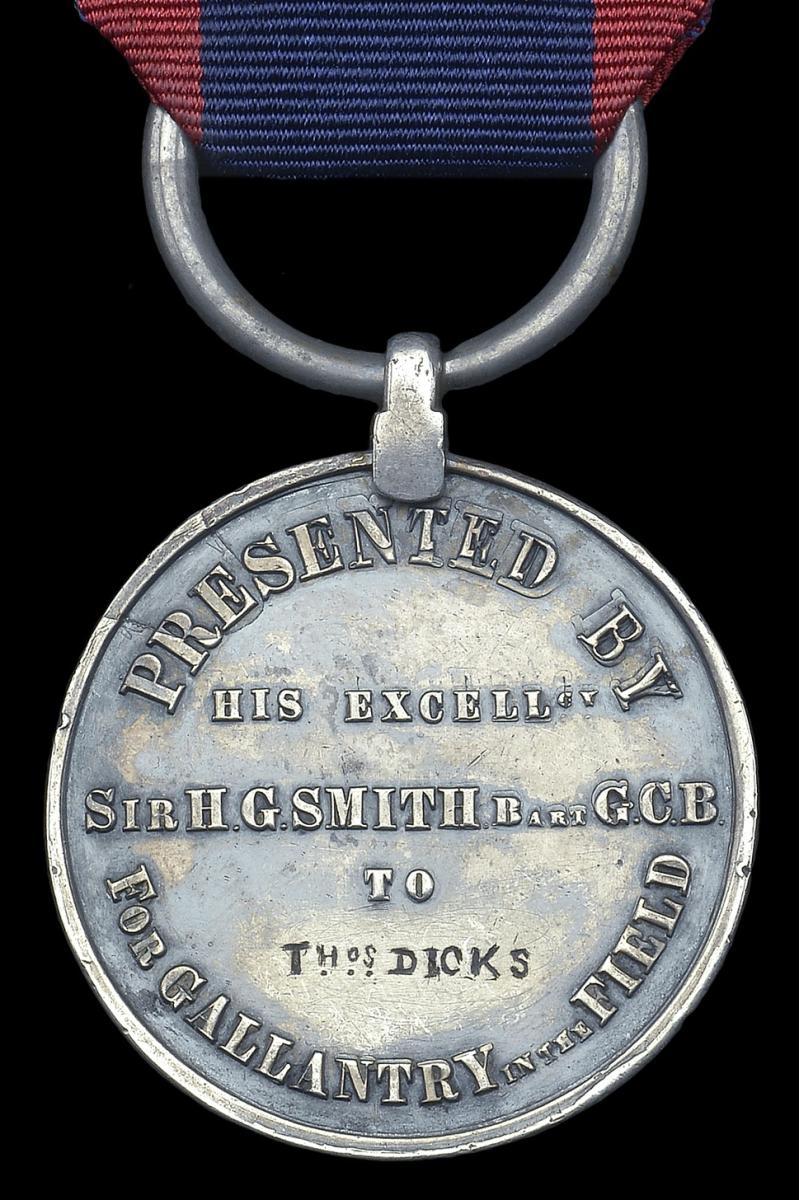
High-resolution cropped image of the reverse of the Sir Harry Smith Medal to Thos. Dicks (from Dix Noonan Webb auction (Lot: 617) of 10 December, 2014: https://www.dnw.co.uk/auction-archive/lot-archive/lot.php?lot_uid=258353). This shows the crack in the upper left, affecting the "R' and "E" in "PRESENTED..." It also shows a partial double strike visible especially in the superior portion of "...ENTE..." of "PRESENTED", both the superior and lateral portions of the "...D BY" of "PRESENTED BY"; the superior portions of the "...ELLCY: of EXCELLCY"; and the "...BART G.C.B" at the end of "SIR H.G. SMITH". Is this the cracked die #2? Also note that the size of the "...IN THE..." is slightly larger than on the John Keiberg medal shown above, but is smaller than the same lettering of the Girt Roots medal. This same crack around the "R" and "E" in "PRESENTED..." also is visible on the lower-resolution online photos of the reverse of the Sir Harry Smith Medal named to Paul Arendt (shown as the 2nd and 3rd image in my post of 30 January, 2021) and the reverse of the medal named to Lt. Edward Lister-Green (shown in the 5th photo of my 30 January, 2021 post).
1 -
Attached is a photo of the Victoria and Albert Museum's example of the Napoleonic medal cabinet graphically showing its size. Although I have previously given its dimensions (88.2 cm high x 52.3 cm wide x 31.8 cm deep, all measurements excluding the non-original plinth), this image very clearly presents the large size of this cabinet.
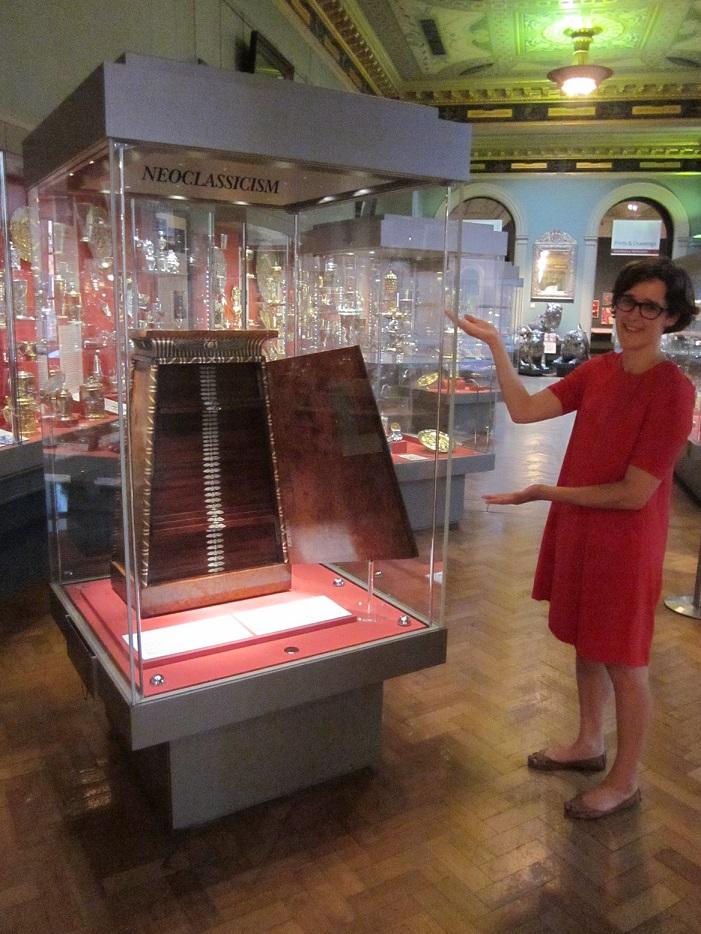
This image comes from the V&A Blog of 17 July, 2014. By Brodie Lyon (https://www.vam.ac.uk/blog/news/medal-cabinet-appeal-elizabeth-bisley-assistant-curator). The photo shows Elizabeth (Lizzie) Bisley, Assistant Curator in Furniture, Textiles, and Fashion at the time. She had been working on the appeals to save the medal cabinet from export and keep it in Britain, here seen shortly after the cabinet was put in its initial case in the Victoria and Albert Museum. Ms. Bisley also was involved in research on the cabinet's design, construction, history, and as an example of the influence of the Napoleonic Egyptian campaign on popularizing Egyptian art elements in the Egyptian revival throughout Europe. The cabinet is currently on display in the recently renovated Europe 1600-1815 Galleries that opened in 2015 (Level 1, Room 1). Ms. Bisley is now the Curator of Modern Art at The Museum of New Zealand, Te Papa Tongarewa.
1 -
Here is an illustration of only the obverse of an example of the Sir Harry Smith medal for gallantry 1851 that is in the South African Cultural History Museum. This image is printed in the book: Simons, Phillida Brooke, 1998. The Life and Works of Charles Bell, Fernwod Press, Vlaeberg, on page 5 (Contents) and in a lower-resolution image on page 90 at the beginning of Chapter 6. This book discusses and illustrates the career of Charles Davidson Bell who was commissioned to design the Sir Harry Smith medal for gallantry 1851 (see my post here of 21 March, 2021). The book does not provide any description of whether the reverse has a name engraved on it, nor does it provide a catalogue number for this museum holding. Unfortunately, the Simons volume also does not illustrate any sketch of the design, and I do not know whether such a drawn design by Bell still exists.
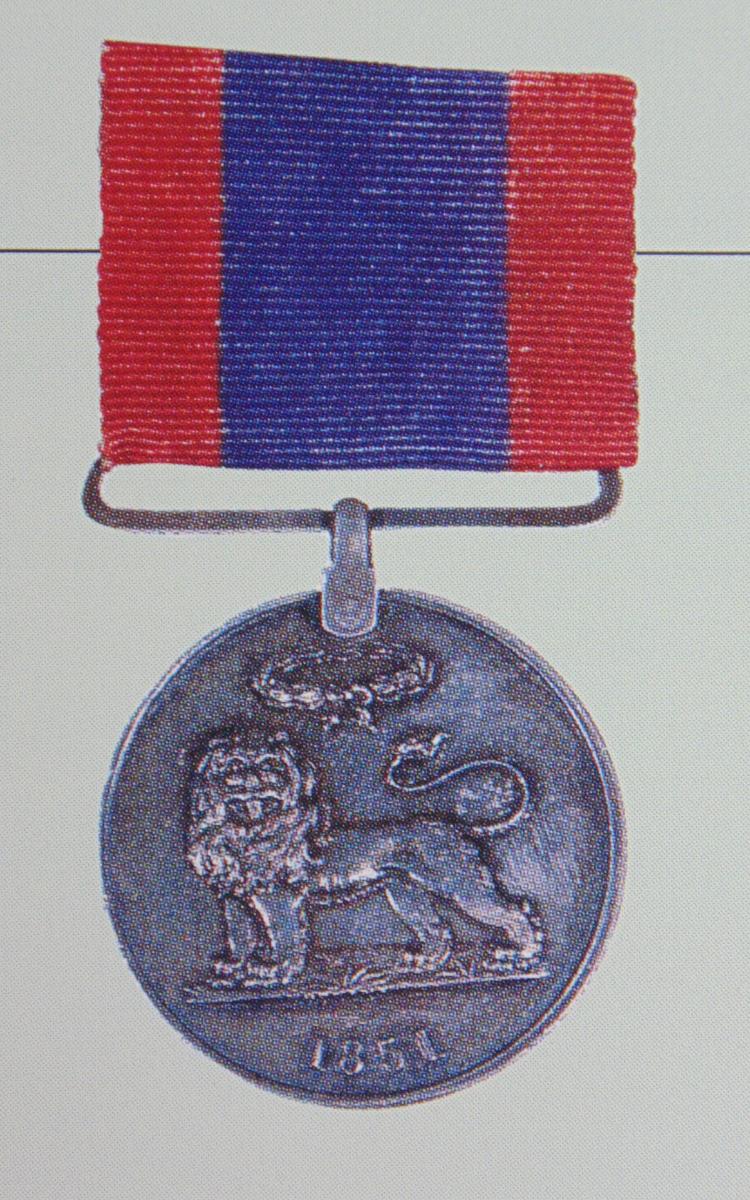
Low-resolution book illustration of the obverse of the Sir Harry Smith medal from the Phillida Brooke Simons book, 1998. The Life and Works of Charles Bell, pg 5. This example is identified as from the collection of the South African Cultural History Museum (one of the Iziko museums?).
Below are two cropped images from full-sized illustrations of both the obverse and reverse of these two medals that I have previously included here (in the 1st and 3rd photos in my post of 13 March, 2021) that show well the engraved name "HOPKINS", on the obverse design of the Sir Harry Smith medal. F. K. Mitchell in his 1955 article in Africana Notes and News (vol XI, No 7) identifies Hopkins as probably the die sinker for this medal on page 237 (see the article reproduced in full in my post of 23 March, 2021 on this thread). At least two other pieces are known to have been engraved by T. B. Hopkins. One piece in the South African Library is a commemorative trowel used by the Governor Sir George Grey to lay the foundation stone of the South African Library (illustrated as Figure 17 of Chapter 8 on page 118 of the Simons 1998 The Life and Works of Charles Bell volume). The other is a silver trigger (illustrated as Figures 1 and 2 of Chapter 9 [pg. 120] of the Simons book) used by Prince Alfred to tip stones into the sea as the foundation for Cape Town's harbor's breakwater on September 17, 1860. This trigger is shown as a watercolor by Charles Bell, from the Bell Heritage Trust Collection and in a photograph by Frederick York from the collection of the Museum Africa. F. K. Mitchell concluded (1955: pp. 239-240) that Thomas B. Hopkins was probably a medallist in Cape Town, and was the engraver of Bell's design for this medal.
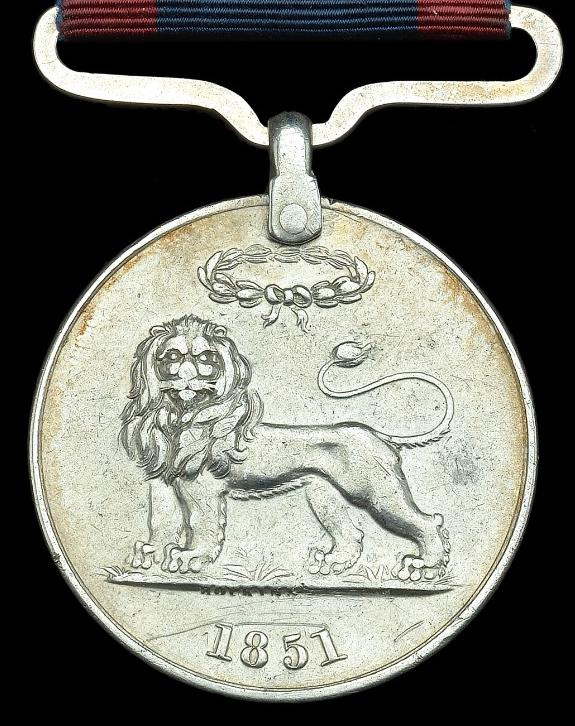
Obverse of the unnamed Dix Noonan Webb example from a 10 December, 2014 auction (Lot: 618) of the Sir Harry Smith medal for gallantry 1851 showing the "HOPKINS" name engraved underneath the strip of veld below the lion (from: https://www.dnw.co.uk/auction-archive/lot-archive/lot.php?lot_uid=258354).
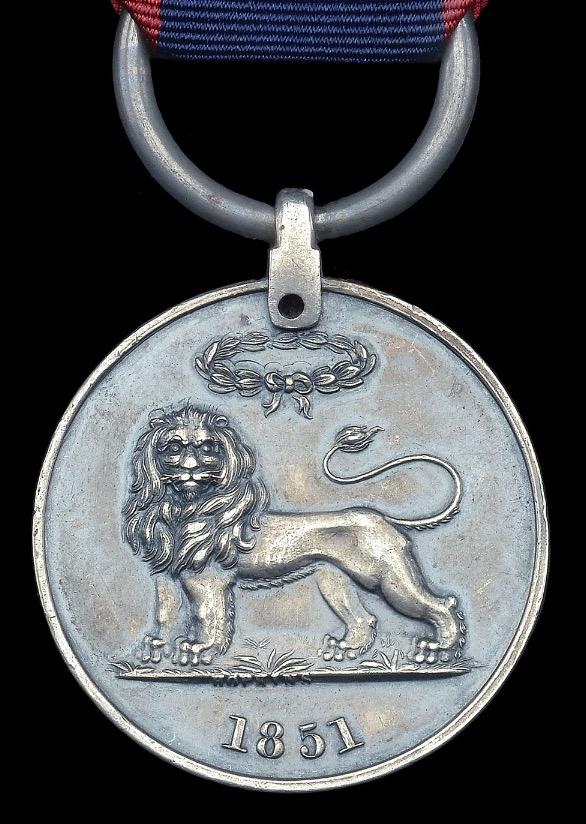
Obverse of the Dix Noonan Webb example named to Thomas (Thos.) Dicks from the same 10 December, 2014 DNW auction as noted above for the unnamed example (Lot: 617) of the Sir Harry Smith medal for gallantry 1851 also showing the "HOPKINS" name engraved underneath the veld on which the lion stands (from: https://www.dnw.co.uk/auction-archive/lot-archive/lot.php?lot_uid=258353). Note the evidence of a partial double strike visible in the interior of the laurel wreath above the lion (as well as some portions of the left superior portion of the wreath) and just above the top portion of the lion's head. The frequency of slight double strikes on the Sir Harry Smith medals is one of the workmanship flaws that Dr. F. Mitchell used to infer manufacture in Cape Town rather than by more skilled London medallists (1955: pg 239).
1 -
Below is a Napoleonic medal case that is slightly later than the two above examples but is still roughly contemporaneous with those Egyptian style cabinets. The images and description come from a current auction (Item Reference: LU981416623322; SKU Reference: f_16623322S) on 1st Dibs (https://www.1stdibs.com/furniture/more-furniture-collectibles/collectibles-curiosities/historical-memorabilia/rare-french-early-19th-century-napoleonic-medal-cabinet/id-f_16623322/). This is probably an auction through Viebahn Fine Arts (reference no. 2010; https://www.viebahnfinearts.com/en/objekte/details/2010_Napoleonic-Medal-Cabinet.html). The Victoria and Albert medal cabinet probably dates to c. 1810 and the Metropolitan Museum of Art example was probably made in 1814. The cabinet being offered by 1st Dibs is identified as dating to c. 1828, based on the association with the publication date of the associated booklet describing the different medal examples in this case that is titled: Collection de Médailles des Campagnes, et du Régne de L’Empereur Napoleon: Depuis sa Premiére Campagne d’Italie, en 1796 Jusqu’a son Abdication en 1815. La Notice est rédigée d’apres le manuscrits de M, Denon par R. de B. Chez Ch. Bigi, Éditeur de Cette Collection, rue Vivienne, No 2., Paris. This booklet is based on one or more documents written by Dominique Vivant-Denon. As noted in my post of 30 October, 2021, Dominique Vivant-Denon (1747-1825) was a French artist who was one of the 167 savants who accompanied Napoleon’s Egyptian Campaign and recorded Egyptian architecture and antiquities in 1798-1799. The engraving of Denon's field drawing of the temple pylon of the Apollonopolis Parva in the Coptite nome (now Qus) in Upper Egypt (shown as both Plate 36 and Plate 80 in: Denon, Dominique Vivant, Baron, 1802. Voyages dans l basses et la haute Égypte, pendant les campagnes du géneral Bonaparte par Vivant Denon 2 Vols. (Atlas Title:) Planches du Voyages dans le Basse et la Huate Égypte. De l’Imprimerie de Didot l’aîné, Paris; and shown as the final illustration in my post of 30 October on this thread) is the basis for the design of the two Napoleonic medal cabinets shown from the V&A Museum and the MMA. Following the 1802 publication of his popular book Voyage dans la Basse et la Haute Égypte, Denon was appointed by Napoleon to oversee the Monnaie des Médailles (Medals Mint), and as Director of the Musée Napoléon (later the Musée du Louvre). It is almost certainly in his capacity with the appointment to the Medals Mint that Denon created the manuscript(s) on which the publication associated with this cabinet of examples of the designs of various Napoleonic medals is based. The cabinet itself is probably wood, covered on the exterior with colored paper. The four feet of the cabinet are gold. The 184 medals in this case are bronzed plaster examples of those medals issued during the reign of Napoleon (from the first Italian campaign in 1796 though his abdication in 1815). The illustrations show that the margins of each bronzed plaster medal are wrapped in paper (or cloth?). Each medal is described in the associated booklet. The case measures 16 cm high x 51.5 cm wide x 29.5 cm deep.
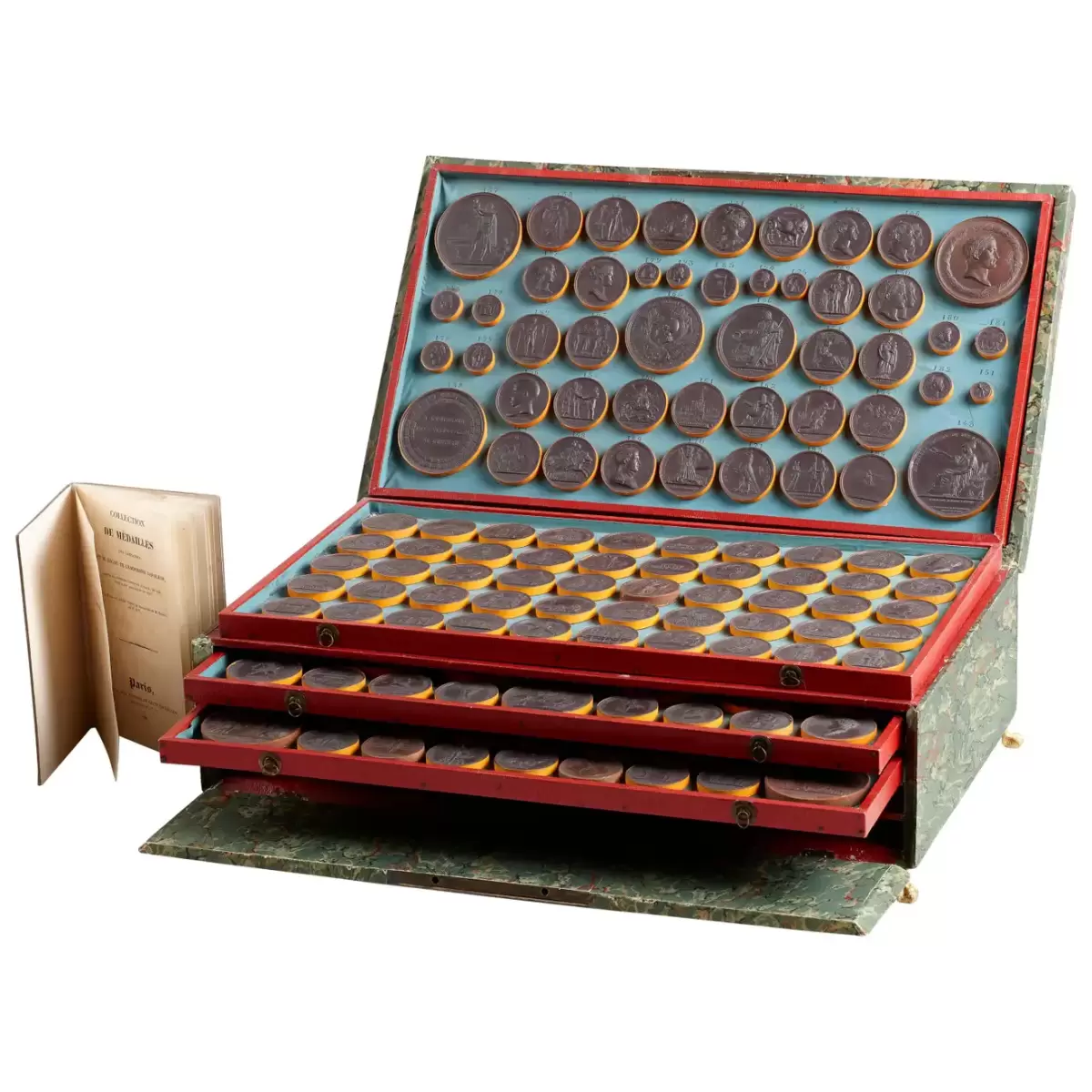
Napoleonic medal cabinet with bronzed plaster exemplars of 184 medals issued during the reign of Napoleon. The 1828 booklet describing the bronzed plaster medals is seen to the left of the cabinet. The illustrations here can be zoomed for a bit more detail, but the original images on the 1st Dibs auction listing (and the Viebahn listing) are higher resolution than what I could download.

Detailed view of the medals shown in the inside lid of this medal case. These bronzed plaster medals are shown in greater detailed on the 1st Dibs and Viebahn Fine Arts listings than what I can download here.
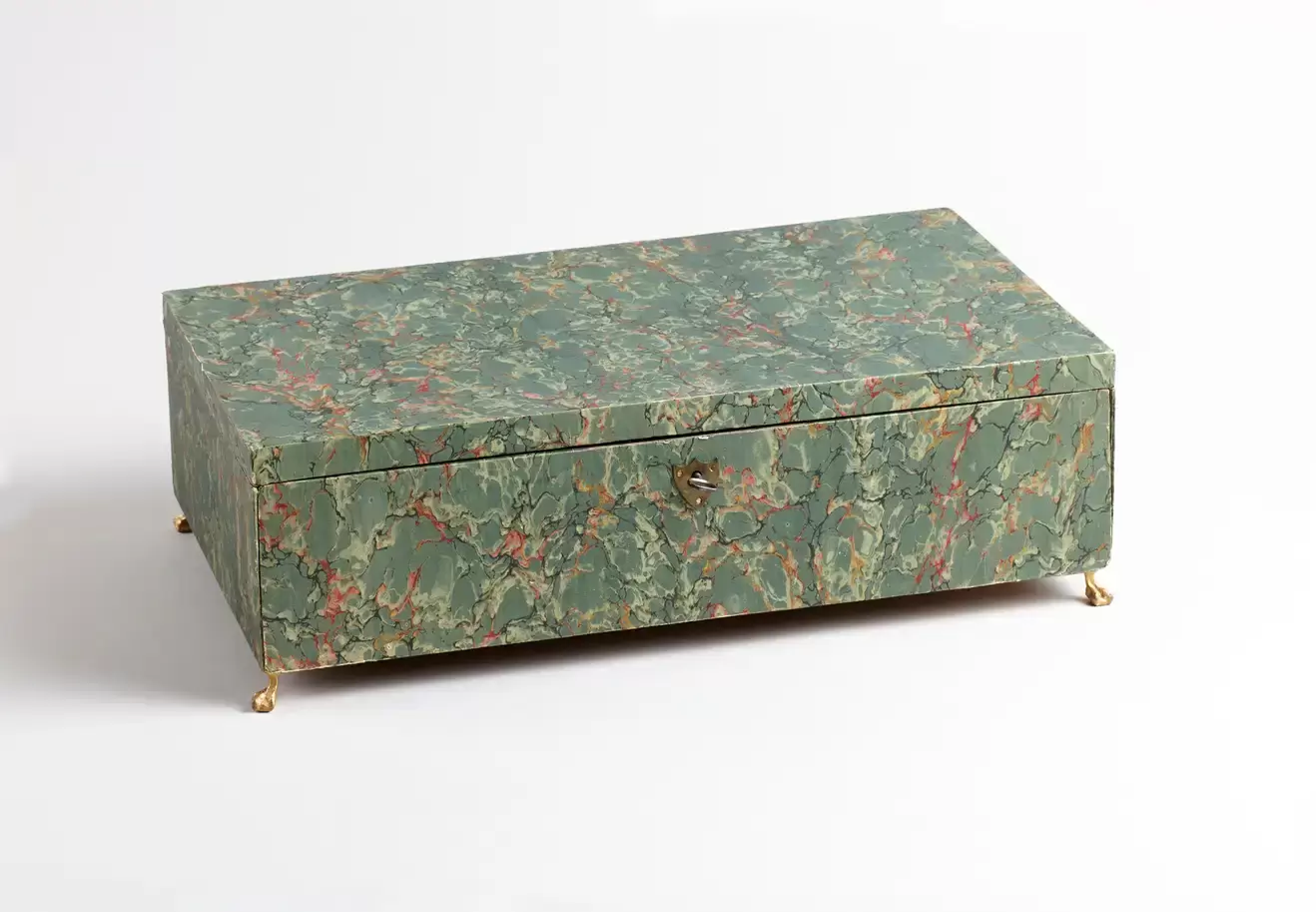
Exterior of the closed case showing the keyed opening device, the colored paper covering, and the gold feet of the cabinet

Title page of the accompanying guidebook describing each of the bronzed plaster medals, based on manuscripts written by Dominique Vivant-Denon, appointed by Napoleon to oversee the Monnaie des Médailles (Medals Mint).
1 -
Attached below is the engraved drawing of the Sir Harry Smith Medal for Gallantry 1851 named to "Frs. Meades C.M.R." (Francis Meades) that is mentioned on page 176 of the City of Johannesburg Africana Museum's: Military Medals of South African Interest: An Exhibition of the Collections in the Africana Museum and the South African National War Museum, Johannesburg, Augmented by Special Loans, 22 July-10 August 1957 (a typed manuscript made in Johannesburg, 1957), that has a descriptions of the Sir Harry Smith Medal for Gallantry 1851 on pp. 174-176. I posted those 3 pages of the African Museum document that describes the Sir Harry Smith medal as the last 3 attachments in my post of 30 January, 2021 on this thread. The text and illustration below come from pp. 355-356 of George Tancred, 1891. Historical Record of Medals and Honorary Distinctions Conferred on the British Navy, Army & Auxiliary Forces From the Earliest Period. Spink & Son, London. The Meades medal apparently was part of the collection of Colonel Murray, mentioned on the bottom portion of pg. 14 of The Story of the 1st Battalion Cape Corps: (1915-1919), by Captain Ivor Denis Difford, 1920, Hortors Limited, Bree Street, Cape Town (as well as on pg. 356 of the Tancred 1891 description copied here), that I posted as the first photo in my contribution of 17 March, 2021 on this thread. However, that note about Colonel Murray and Major William Jardine's collections does not note that Colonel Murray's collection had the named Francis Meades example and the medal in Major Jardine's collection was unnamed. According to Mitchell, F. K., 1955. Sir Harry Smith's Medal for Gallantry: 1955. African Notes and News (Africana Aantekeninge En Nuis), Vol XI, No. 7 (June 1955), pp. 236-242. Africana Society, Africana Museum, City of Johannesburg (printed by Cape Times Limited, Johannesburg) that I posted here on 23 March, 2021, the Francis Meades medal is curated in the Africana Museum. The 1957 City of Johannesburg Africana Museum publication: Military. Medals of South African Interest: An Exhibition of the Collections in the Africana Museum and the South African Museum and the South African National War Museum, Johannesburg, Augmented by Special Loans, 22 July-10 August 1957, identifies on pg. 176 the catalog number of the Meades medal as AM 1811.
Bottom portion of page 355 of Tancred 1891.
Top of page 356 of Tancred 1891.
Enlargement of the above engravings of the Francis Meades Sir Harry Smith Medal for Gallantry 1851, from pg. 356 of Tancred, 1891. These illustrations of the obverse and reverse of this medal appear to be the basis for the engraved illustrations on the the bottom portion of page 14 of The Story of the 1st Battalion Cape Corps: (1915-1919), by Captain Ivor Denis Difford, 1920, Hortors Limited, Bree Street, Cape Town (with the inscription "Frs Meades C.M.R" removed from that 1920 figure in the Difford publication, see my post of 17 March, 2021 on this thread showing that engraving). The embellishment on either side of the "TO" on the reverse is not seen on any of the photos of extant verified or alleged examples of this medal. In the absence of a photo of the African Museum Meades medal, I do not know whether at least one die may have carried this elaboration. Mitchell (1955) identifies the reverse die for the Meades medal as the same die as used for the J. Hassall medal he owned and illustrated in the first photographic plate of that article. This suggests the embellishment in the Tancred and Difford illustrations are not seen on any of the actual Sir Harry Smith Medals.
Title page of Tancred, 1891
1 -
Regarding note 4 in Numis' post here of 27 March, 2021 about the Francis Skead medal, I just want to include a brief description of some of the complexities about this piece that Numis mentions. All of this information comes from the following article: Stein, Glenn M., 2010. An extremely rare pair: the South Africa 1834-53 and Arctic 1818-55 Roll. OMRMS Journal. Vol. 49, No. 3. The article is a bit vaguely written in relation to identifying the specific sources of the information on each of the individuals listed, the museum (Africana Museum?) where Skead's medals are curated, and the inventory number of the Sir Harry Smith Medal for Gallantry 1851 with Skead's name engraved on it. The 2nd paragraph under the photo of Skead below outlines the controversy about the naming on this example.
"12) SKEAD, Francis
Second Master, Dee
Second Master, Enterprise (1850-55)
South Africa Roll: issued 24 January 1856
Arctic Roll: issued 10 April 1858
China 1842, South Africa and Arctic known in Africana Museum (Johannesburg Public Library).
Dr. C.J. "Jack" Skead (a grandson of Francis Skead), died 28 May 2006, aged 94 years. He wrote at length about his family's medals, and indicated that his grandfather's China 1842 'is engraved "F. Skead. Master's Assistant".', but makes no reference to a ship's name on the edge. Skead served from August-November 1841 on HMS Royalist, thereafter being posted to the surveying schooner Starling (leaving her in July 1843).
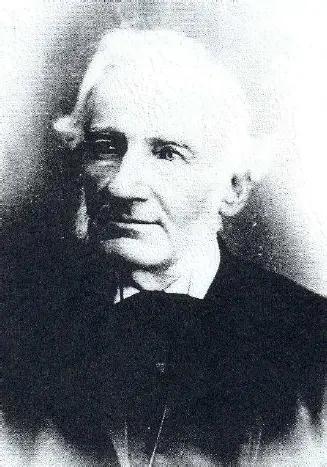
Francis Skead (1823-91) in later life. (Courtesy Margaret O’Leary)
On 18 April 1848, Skead joined HMS Dee, bound for the Cape of Good Hope. The ship's Muster Books show that he left the ship on 23 May 1849. The South Africa is impressed, 'F. SKEAD, 2nd MASTER'.
A Sir Harry Smith's Medal for Gallantry (1851/unmounted) resides with Skead's medals. Smith was Governor of the Cape and the medal was given as a personal award from him. This example is engraved in running script, 'Capt. F. Skead R.N.', and attributed to Francis Skead. He was in the Arctic in 1851, and in addition, only reached the rank of Navigating Lieutenant, was was never a Royal Navy captain, and only reached the Cape after Sir Harry Smith had departed from that place. The reasons for the naming remain a mystery, and although research has excluded Francis’ brother Frederick (below) as a possibility, it seems possible Francis acquired an unnamed example and had it engraved as a keepsake.
The museum also holds medals given to Francis' brother Navigating Lieut. Frederick Skead, RN (1829-71): Crimea/Sebastopol (loose on ribbon, with a very wide pin brooch/Master?/Caradoc)-the Caradoc was not entitled to Sebastopol; RHS (silver/1852)-for saving the life of a Naval Cadet Sheepshanks, who had fallen overboard from HMS Trafalgar in 3 February 1852. Skead was assisted by Midn. John W. Lambe, who also received a silver medal.
In June 2006, Dr. Skead's cousin, Tom Skead, emailed me a very interesting image of some family numismatic items, to include a riband bar featuring the China 1842, Arctic and South Africa ribands. Also, there were miniatures of these medals that he indicated had been made into shirts studs or cuff links. Finally, a Turkish Crimea (English version) among the items would seem to have belonged to Frederick Skead."
Much of the information on Francis Skead may come from an unpublished source acknowledged in this OMSR Journal article: Skead, Dr. C.J., Francis Skead's Medals (undated manuscript).
1 -
Just to round out some info on the Republic version of the Order of the Nile, here are a few images of the Collar for the Order of the Nile and the miniature medal.

Above are two images of the Egyptian Republic period Collar of the Order of the Nile showing some details of the links on the Collar. The uppermost is from Wikipedia (https://es.wikipedia.org/wiki/Orden_del_Nilo#/media/Archivo:Orden_Nila.jpg) and the lowermost from Wikimedia (https://commons.wikimedia.org/wiki/File:Grand_Cordon_of_the_Order_of_the_Nile_(Egypt)_-_Memorial_JK_-_Brasilia_-_DSC00434.JPG). Both photos can be zoomed for better detail of the links on the Collar. The Collar chain has repeated floral elements that combine multiple lotus flowers arranged in a circle and ornamented with rubies and a central inlay of turquoise. Above and below these floral elements are individual gold lotus flowers attached to the chain. The other links in the collar are square gold plaques bordered on the inferior and superior margins with either green, dark blue, red, and turquoise enamel, or inlayed with a green stone, lapis lazuli, carnelian and turquoise framing stylized gold water waves with central figures or symbols adapted from various Ancient Egyptian motifs.

Here is a good image of the miniature Order of the Nile breast medal from La Galerie Numismatique, silver partly gilt, and enamel 25 x 20 mm (https://www.coins-la-galerie-numismatique.com/online-shop/orders-medals/order-nile). The auction listing describes this as a "Knights Cross Miniature (5th Class)". However, as noted the Republic-era post-1953 version of this Order of the Nile was only awarded as a Collar or Grand Cordon class. This ribbon should correctly have a rosette and gold braid (galon) as shown in the miniature example second from the right in Owain's post of 8 March, 2018 on the thread "Miniatures of the Middle East & Arab World", started by Owain on 6 December, 2017.
1 -
I previously outlined the nature of the Ancient Egyptian imagery on the Republic-era Grand Cordon Order of the Nile regalia (in a post I made about the mini of this order posted on 7 March, 2018 in the thread "Miniatures of the Middle East & Arab World" started by Owain on 6 December, 2017). Given the interest in Enzo's acquisition of an example of this lovely award, I thought I would resurrect my summary of the archaeological imagery to include here.

The imagery on the Republic's version of the Order of the Nile is derived from some of the many variant Ancient Egyptian depictions symbolizing the ~5000 year-old unification of Egypt (the tied lotus and papyrus stems form a symbol of "union", sema-taui). This above drawing of a relief panel on the stone throne of Pharaoh Senwosret I shows the gods Seth & Horus uniting the two (formerly divided) kingdoms of Upper & Lower Egypt. This throne dates to the 12th Dynasty (~1956-1911 BC), long after this has become an established icon in Ancient Egyptian political decoration. In this version of the unification, Seth (on left) binds a lotus (the image of Upper Egypt-the southern portion by our geography) and his brother Horus (on right) ties papyrus (symbolic of Lower Egypt, the northern part of the country) to the central sema symbol. This central dividing image is a symbol for the lungs (each of the brother gods have their feet on one lobe) attached to the trachea, which is the hieroglyphic symbol sema representing "union". In most written versions of this glyph it looks more "jar-like" through shortening of the trachea, as in the form adopted for the Republic of Egypt's central icon on the Order of the Nile badges shown above in Enzo's 1st, 2nd, and 3rd photos of his initial post here of 4 April, 2022 (with a border decoration of 15 lotus blossoms). The suspension device connected the sash badge to the sash of the 1st Class Order of the Nile (Enzo's 2nd photo in his initial post here) further reiterates this unity theme in the symbolism: the lowermost lotus flower supports an ensemble of a central lotus flower that is flanked by a papyrus bloom on the left and a lotus flowers on the right, and each of those has an additional stem adjacent to them to further symbolize the binding together of Upper & Lower Egypt. Other images depicting the union of Upper and Lower Egypt also employ a sedge for Upper Egypt or a bee to symbolize Lower Egypt. The well-known Narmer Palette (>5000 years old) is usually thought to depict this conquest of the "Two Lands" that became the unified Egypt with militaristic imagery of King Narmer (wearing the white Crown of Upper Egypt) smiting a prisoner with a cudgel on the recto side and wearing the Red Crown of Upper Egypt on the verso side. The hieroglyphs in the cartouche at the top of the trachea portion of the sema symbol in the above drawing are the throne name of Pharaoh Senwosret I: Kheperkara (http://www.joanlansberry.com/setfind/uniting.html)
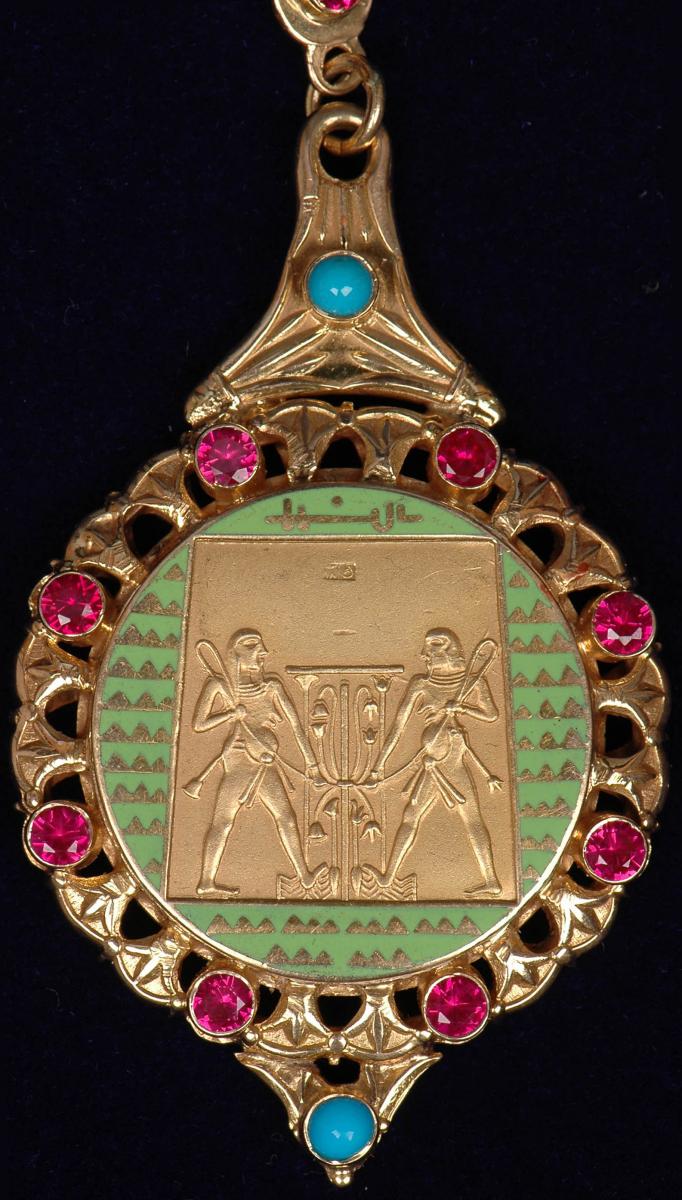
Image from Wikipedia of the post-1953 Republic of Egypt badge suspended on the Collar of the Order of the Nile showing another modern image adaptation of the Ancient Egyptian theme of the unification of (Upper & Lower) Egypt. It retains the binding of lotus (right) and papyrus (left), but has changed the sema image to a more vegetative framework and inserted stylized ancient Egyptian water symbols under the figures' feet, presumably in reference to the Nile. The two male figures with pendulous breasts ("moobs" as seen on the two figures flanking the sema union symbol on the sash badge and breast star), fat rolls, and large bellies (also seen on the figures on the sash badge and breast star) derive from common versions of this image depicting the god Hapi, frequently associated with this political art image during the 19th Dynasty (~1291-1189 BC). Hapi is a deity associated with the annual flooding of the Nile. His breasts and belly are considered to represent the fertility of the river and its renewal of the floodplain with the annual inundation that brought organic material to enrich the soils of the valley terraces. The gold design in the enamel probably depicts repeated sets of the three Great Pyramids of Giza (9 km west of the Nile), possibly reiterated to resemble ancient Egyptian imagery of water in reference the River Nile. The surrounding margin designs are stylized lotus blossoms interspersed with rubies. The suspension device depicts three lotus blossoms. The badge is made of solid gold, rubies, turquoise, and enamel (https://en.wikipedia.org/wiki/Order_of_the_Nile).
Always looking for a way to sneak in some of my archaeological pedantry!
1 -
I was surprised to find a second example of an unusual full-sized, odd piece of jewelry based on the design of the Mixed Courts badges. The appearance of this additional example puzzles me even more than the existence of a single strange adaptation of the Mixed Courts badge design. I have previously illustrated the other example I have encountered of such a "mock-badge" from a 5 December, 2018 auction by Bamfords Auctioneers & Valuers, Lot 3620A (https://auctions.bamfords-auctions.co.uk/catalogue/lot/1672cda7783734d000495e169152f06c/e4ebea155a08e205e5ea6a89010099d0/two-day-gentleman-s-library-stamps-grand-tour-curio-lot-3620a/) in my post of 2 December, 2018 on this thread. The current example I have found is identical (except for some details in the enamel execution and loss of some of that enamel) to that very odd Bamford's piece and comes from a 24 October, 2021 auction (Auction 20, Lot 16) by the Turkish firm Arthill Museology & Collecting JWL (Arthill Müzecilik Koleksiyonculuk KYM) (https://www.arthill.com.tr/en/product/4095822/hidiv-19-yuzyil-altin-vermeyli-bronz-mineli-adalet-nisani-19-yuzyil-sultan-abdu). The auction description provides only a small amount of information. This Arthill Group piece is identified as made of bronze, with enamel, and allegedly some gold inlay. I do not know if the rayed embellishment may be gilt. The Bamfords badge is identified as made of silver, and has Egyptian silver hallmarks on the reverse. The dimensions of the Arthill Group badge are given as 11.5 cm tall x 8.5 cm wide, the approximate same size as the actual court insignia. Obviously, the design of this piece is a much abbreviated interpretation of the design of the official court regalia (as discussed in my 2 December 2018 post) and is probably cast. The two examples of these odd badges are even less-detailed and incomplete in replicating the badge design elements than the two badges I illustrated in my previous post here of 3 February, 2022 made by D. Ialanos, A. de E Leo &. A. Kassandrinos, of Alexandria. Those two D. Ialanos, A. de Leo, & A Kassandrinios-made badges probably were genuine Mixed Courts' regalia, possibly more economic alternatives to struck pieces by other makers. The design elements on the Arthill and Bamford's badges are far too reduced in detail to represent badges that fulfill the dignified appearance these distinctive emblems of the court officials create as part of the judicial or other court officials' costume. However, while the appearance of the single Bamfords example initially appeared to me as a jewelry knock-off by Horovitz, the presence of this second example makes inferences about the potential use of this more complex. The fact that both such examples were made by Wolf Horovitz (a maker of more detailed Mixed Court badges), and possibly were made in both bronze (Arthill) as well as silver (Bamford's) suggests some more intricate reason Horowitz produced these unusual interpretations of the Mixed Courts badge design. This Arthill Group piece is missing some of the black enamel of the upper portion of the mantle drapery, the cords suspending the tassels at the corners, and possibly in the fringe of some of the lateral folds of the mantle. Some of the enamel in the inscription of the central tablet on this example appears to be missing. The Bamfords’ example of this jewelry version of this badge has black enamel in the upper portion of the mantle drapery, the cords of the tassels, and all of the lateral fringe in the folds of the matle portions of the badge. The Bamfords piece also has white enamel in the area of the Order of Medjidie that is not present on this piece. There appears to be a difference in the amount of enamel in the crown element. The Bamfords’ example only has black enamel in two areas between the arches of the crown, however all of the crown on the Arthill badge appears to have at least remnant enamel in all portions of the design. The Arthill example may never have had enamel in the fringes of the lateral mantle folds, no remnant fragments of enamel are visible there. As with the Bamford’s example, this piece has the name “HOROVITZ” on the reverse, also identifying the Wolf Horovitz workshop at 26 rue Chérif Pacha in Alexandria. Unlike, the Bamfords’ piece, there are no Egyptian silver hallmarks on the reverse or on the tunic pin (although the lower-resolution photo on the Arthill listing makes it unclear whether a mark is present on the tunic pin or not).
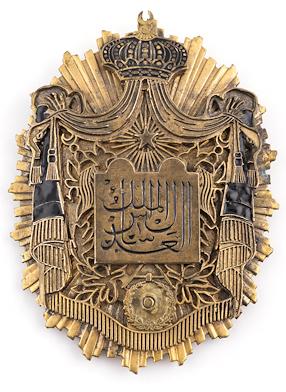
Obverse of the Arthill Group Mixed Courts badge-inspired piece made by Wolf Horovitz. This and the other 5 images from the Arthill listing can be zoomed for slightly more detailed views, and to contrast the enamel execution and damage with the Bamfords example shown in the 6th photo below.
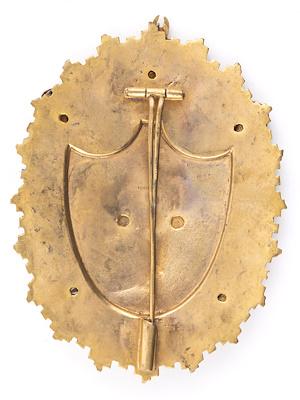
Reverse of this odd badge with the location of the “HOROVITZ” name visible in the same location as on the December 2018 Bamfords example. No hallmarks are visible on the reverse of this badge (and there are no Egyptian hallmarks for bronze).
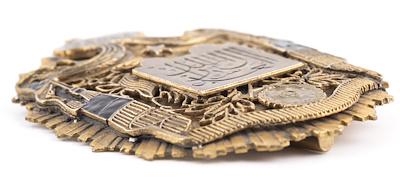
Oblique view of this Horovitz-made jewelry/badge from the Arthill auction listing
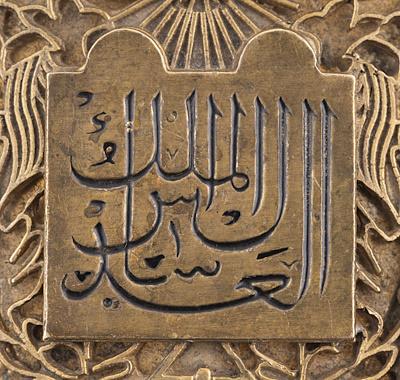
Detail of the central tablet, showing several areas where enamel is probably missing. This close-up shows well the outlined suggestion of the leaves on the laurel and oak branches, and tug elements of this part of design around the central tablet, demonstrating the minimally detailed approximation of many design components in the the workmanship of this piece.
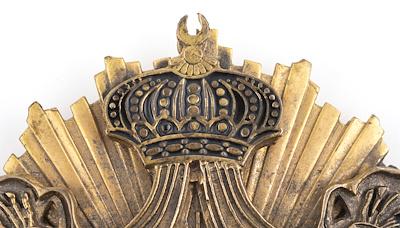
Detail of the crown element at the superior margin of this badge. There may be black enamel remnants in more portions of the crown than on the Bamford’s piece with more intact original enamel.
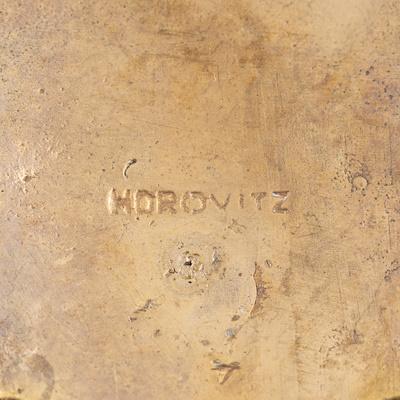
Detail of the "HOROVITZ" name (struck) on the reverse of this badge. Note the casting flaws visible in this close up of the reverse surface of the badge.
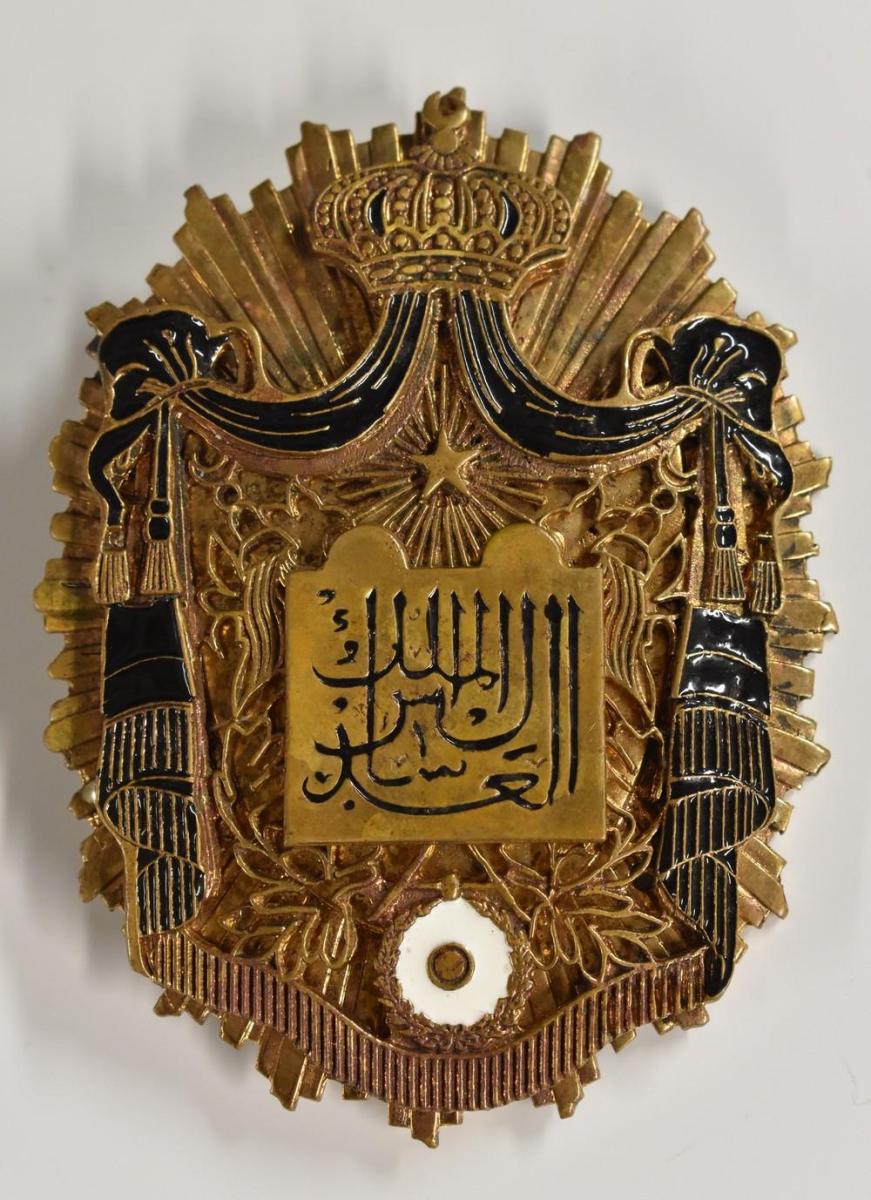
Obverse of the only other example I have seen of this form of jewelry based on the Mixed Courts badge design, from a 5 December, 2018 auction (Auction 20, Lot 3620A) by Bamfords Auctioneers & Valuers. This image can be zoomed for some additional distills in the execution of these odd Horovitz-made badges. This piece was identified as silver in the Bamford's description. The size of this unusual badge is the same as the Arthill Group example (and to all official badges). Note the black enamel only in two portions of the crown between arches, the intact black enamel of the upper portion of the mantle drapery, in the tassel suspension cords, in the fringe of all three folds of the mantle on the left and right lateral sides, the more intact enamel in the tablet inscription, and the white enamel around the Order of Medjidie element.
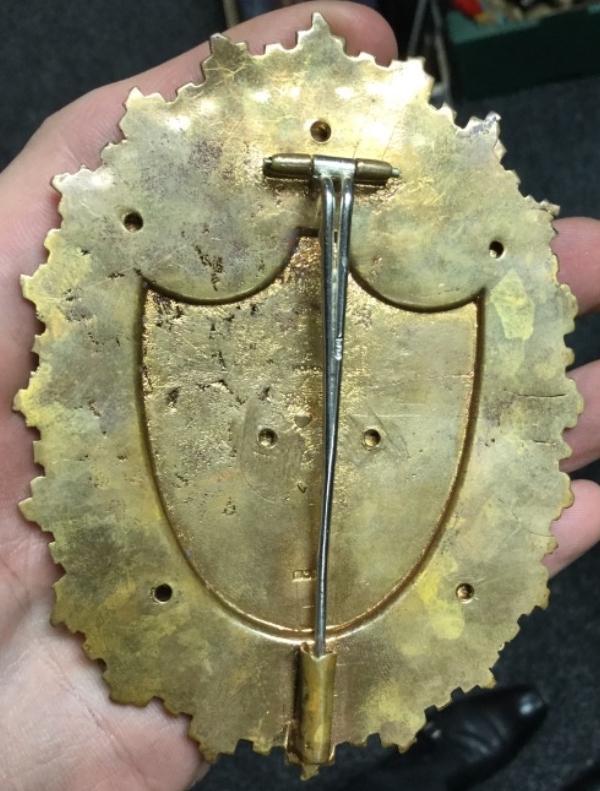
Reverse of the Bamfords example of this badge, showing the similar location of the "HOROVITZ" name, and also showing the location of 3 silver hallmarks at the inferior part of lower relief area under the pin and the presence of at least 2 Egyptian silver hallmarks on the tunic pin, just proximal of the union of the double tongue with the single pin of the distal portion this tube hinge pin. The flaws from casting also are clearly apparent in this view of the reverse of the Bamfords badge.
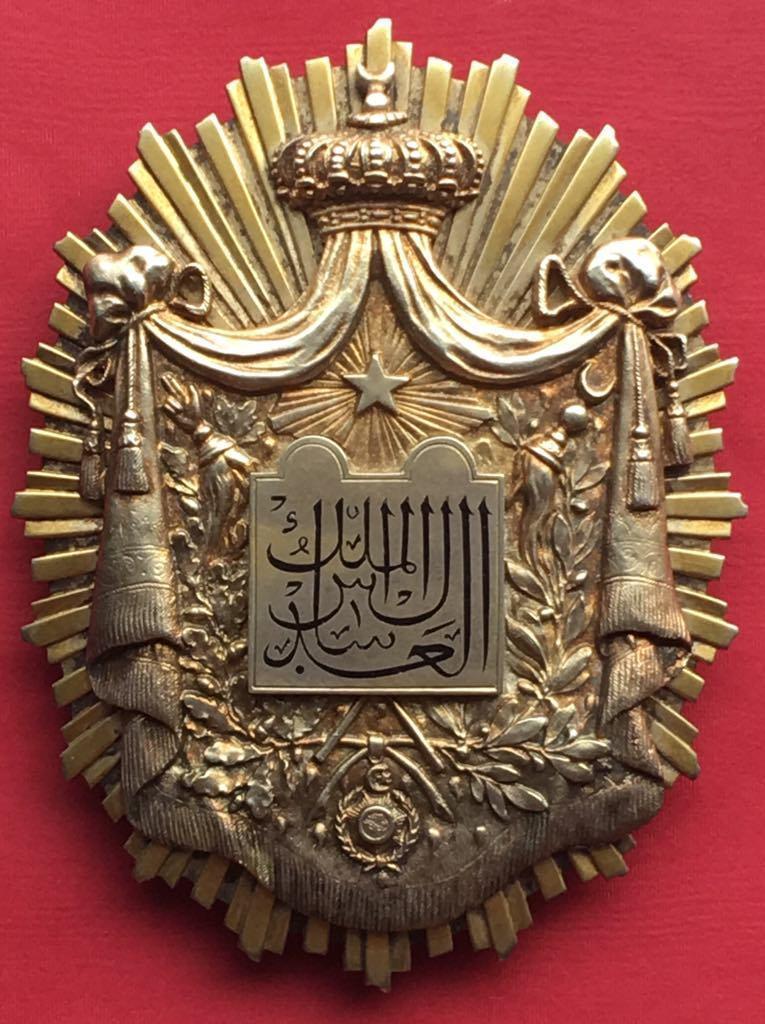
Above is the obverse of a cased example of a Wolf Horovitz-made silver Mixed Courts badge from an eBay auction in December of 2018 (https://www.ebay.com/itm/EGYPT-KING-FAROUK-SILVER-GILT-ENAMEL-JUDGE-BADGE-IN-ORIGINAL-CASE-XXX-RARE/223228334558?hash=item33f97211de:g:1o0AAOSwBURb6gap, however this link is no longer working). This demonstrates the noormal workmanship and detail in execution of a struck official badge of the Courts' regalia. The name "HOROVITZ" and the 3 Egyptian silver hallmarks are present on the reverse of this badge, including a date hallmark of "N" indicating assay in 1938-39. I previously illustrated and described this badge in my post of 1 December, 2018 on this thread.
Sold for 125.
0 -
I recently included an additional French manufacturer’s hallmark in a post about a Napoleonic medal cabinet made in the early 19th century here in the France section (“Napoleonic Medal Cabinet with Ancient Egyptian Motifs”, started on 30 October, 2021). That mark is for the French Imperial goldsmith Martin-Guillaume Biennais (1764-1843). This post also includes a few hallmarks used by one manufacturer of Mixed Courts’ badges in Egypt who was based in Paris and two jewellers established in Alexandria Egypt who distributed silver made in Paris. I am illustrating here hallmarks for Pierre Henri Émile Froment Meurice (1837-1913) a Parisian silversmith who designed and made many of the first badges for judges and other officials of the Egyptian Mixed courts (1879-1949). I also am including here hallmarks and manufacturers’ marks for Wolf Horovitz and Zivy Fréres & Cie, jewelers in Alexandria, Egypt who also made these Mixed Courts badges and at least occasionally had other silver pieces manufactured in Paris for distribution in Egypt (in addition to clocks and watches from Switzerland). I am not very knowledgeable about French hallmarks, but would like to add these maker’s marks to this interesting and useful thread.
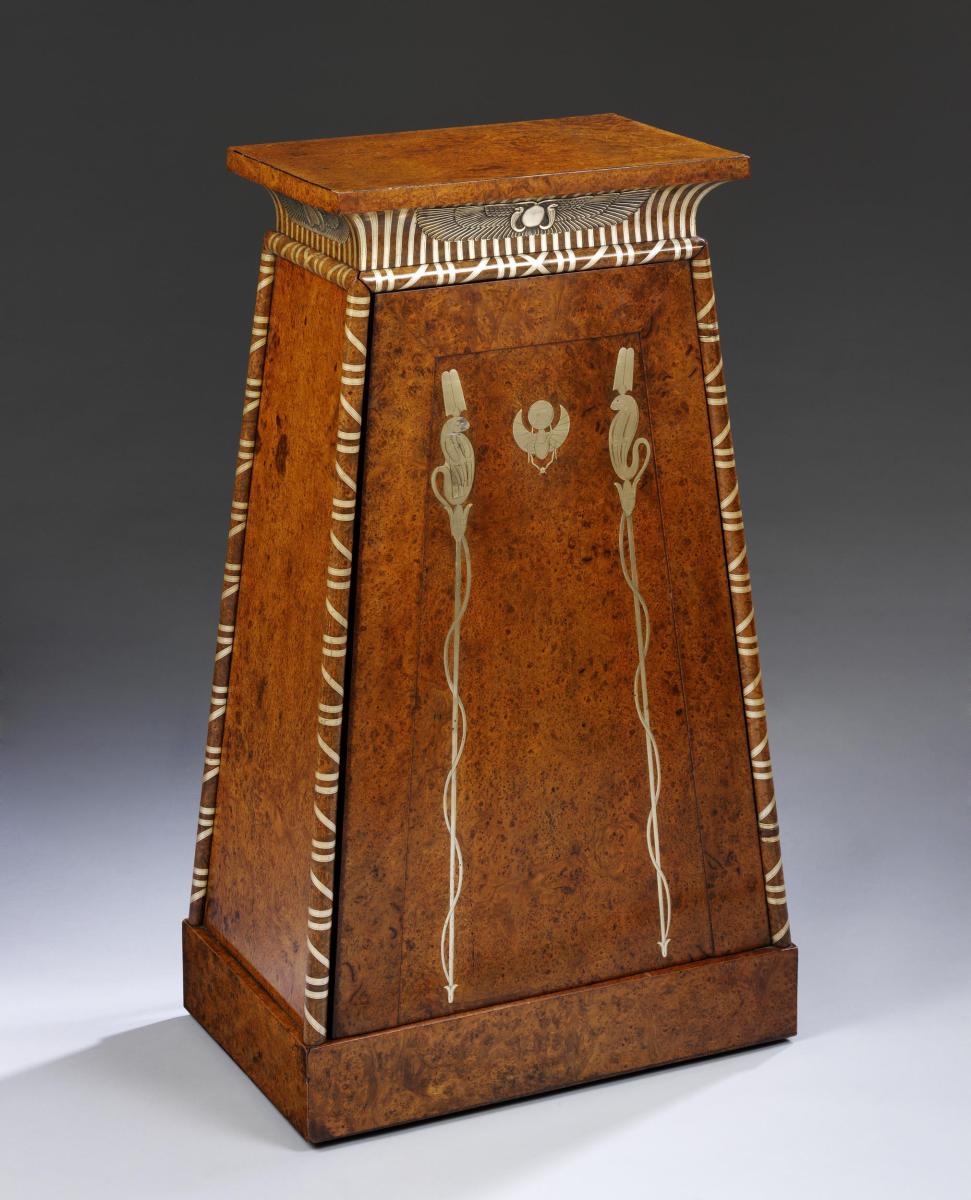
French medal cabinet c.1810, in the Furniture and Woodwork Collection, accession no: W.8:1,2-2014, Victoria and Albert Museum, London (image copyrighted by the Victoria and Albert Museum; https://collections.vam.ac.uk/item/O1284580/medal-cabinet-martin-guillaume-biennais/?carousel-image=2014GY7211).

French Medal cabinet, probably made in Februry.1814, accession no: W.8:178.77. Metropolitan Museum of Art, New York (from: https://www.metmuseum.org/art/collection/search/195473).
The manufacturer of the two medal cabinets I posted was probably the French Imperial goldsmith Martin-Guillaume Biennais (1764-1843). His workshop at least created the silver embellishments for both cabinets. The Victoria and Albert Museum (V&A) research staff feel that Biennais also likely manufactured the cabinet as well (the Metropolitan Museum of Art [MMA] identifies the cabinet maker as Desmalter et Cie, Paris). The lockplate of the V&A example is inscribed with the manufacturer’s name: “Biennais, Orfre de L. L. M. M. Imples et Royles à Paris” (Biennais, goldsmith to their Imperial and Royal Majesties in Paris). The longer winged Uraei on the front and back of the cornice are stamped with 3 silver hallmarks (only two are visible in the close-up photo), the oval Greek woman mark for 1793-1794, a diamond-shaped maker’s mark of Biennais, and the Paris standard hallmark for 1809-1819 (probably a form of the rooster hallmark with the number 1 indicating 950 silver assayed in Paris (but no illustration of this mark is provided). Because of his inscription on the lockplate, it was clear that Biennais fabricated the silver mounts. Older suppositions about the cabinet maker of this piece favored the Parisian firm Desmalter et Cie. However, the current consensus, at least within the V&A, is that the cabinetry of the case as well as the silver mounts were all were probably fabricated in the Biennais workshop (note below that the Metropolitan Museum still identifies Desmalter’s workshop as the probably manufacturer of their example of this medal cabinet). Biennais supplied Napoleon and his family with silver items from at least 1798, and he manufactured the crown and scepter used for his 1804 coronation as Emperor in Paris and Milan. There is a significant probability that the V&A example was made for Napoleon. The MMA does not have a comparable inscription on the lockplate. Instead, simply the name “Biennais” is engraved above each keyhole in the hidden location described and illustrated in my post on this cabinet of 30 October, 2021. As noted in that post and the text of the Sotheby’s 3 july, 2013 listing (Lot 42) for the example that ended up at the V&A, this change excluding the engraved mention of royal patronage (and the change from bee-forms of the drawer pulls to more scarab-like insect forms), may have been associated with Napoleon’s declining fortunes following military losses and his rejection of the 1813 Frankfurt Proposal’s peace terms. These are the only known examples of this form of medal cabinet that was designed by Charles Percier. For a more detailed, and potentially overly pedantic treatment of these cabinets, see my 30 October, 2021 thread in this France section of GMIC.
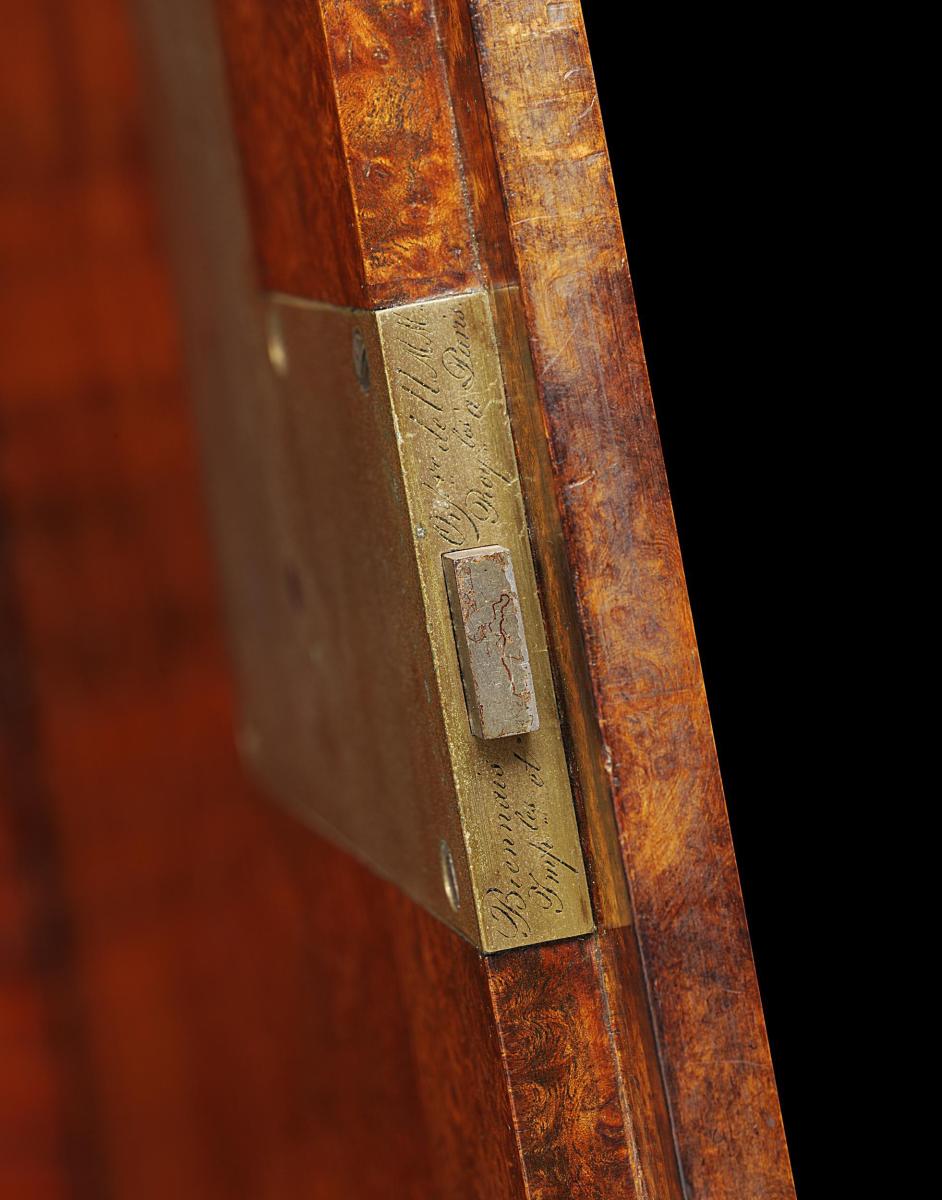
The lockplate of the c. 1811 V&A example with Biennais’ inscription: “Biennais, Orfre de L. L. M. M. Imples et Royles à Paris”.
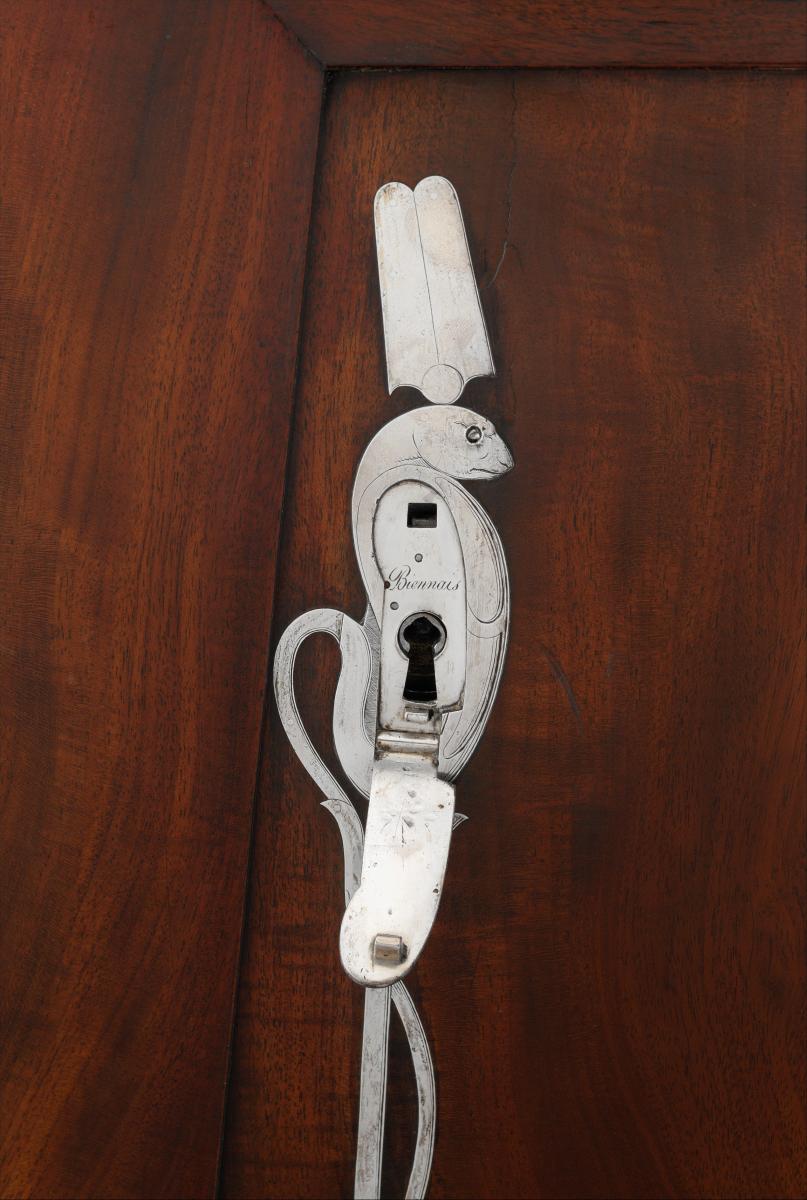
One of the keyholes on the c. 1814 MMA example with the more abbreviated inscription “Biennais”.
None of the high-resolution photos of these two Napoleonic medal cabinet (c. 1810) provide close-up images of the silver hallmarks on the fittings of this cabinet. In my post, I have identified the locations and marks on the silverwork on the two extant examples of this medal cabinet in my thread on his piece, but have used examples from a different silver item made by Biennais to show his maker’s mark. The hallmarks illustrated below are from a cropped image of the underside of the lid of a silver, gilt, and ebony teapot made by Biennais c. 1809-1815, that is curated in the Royal Collection Trust, RCIN 48395 (https://www.rct.uk/collection/48395/teapot). These images are copyrighted (Royal Collection Trust/©Her Majesty Queen Elizabeth II 2021), but can be used for non-commercial purposes.
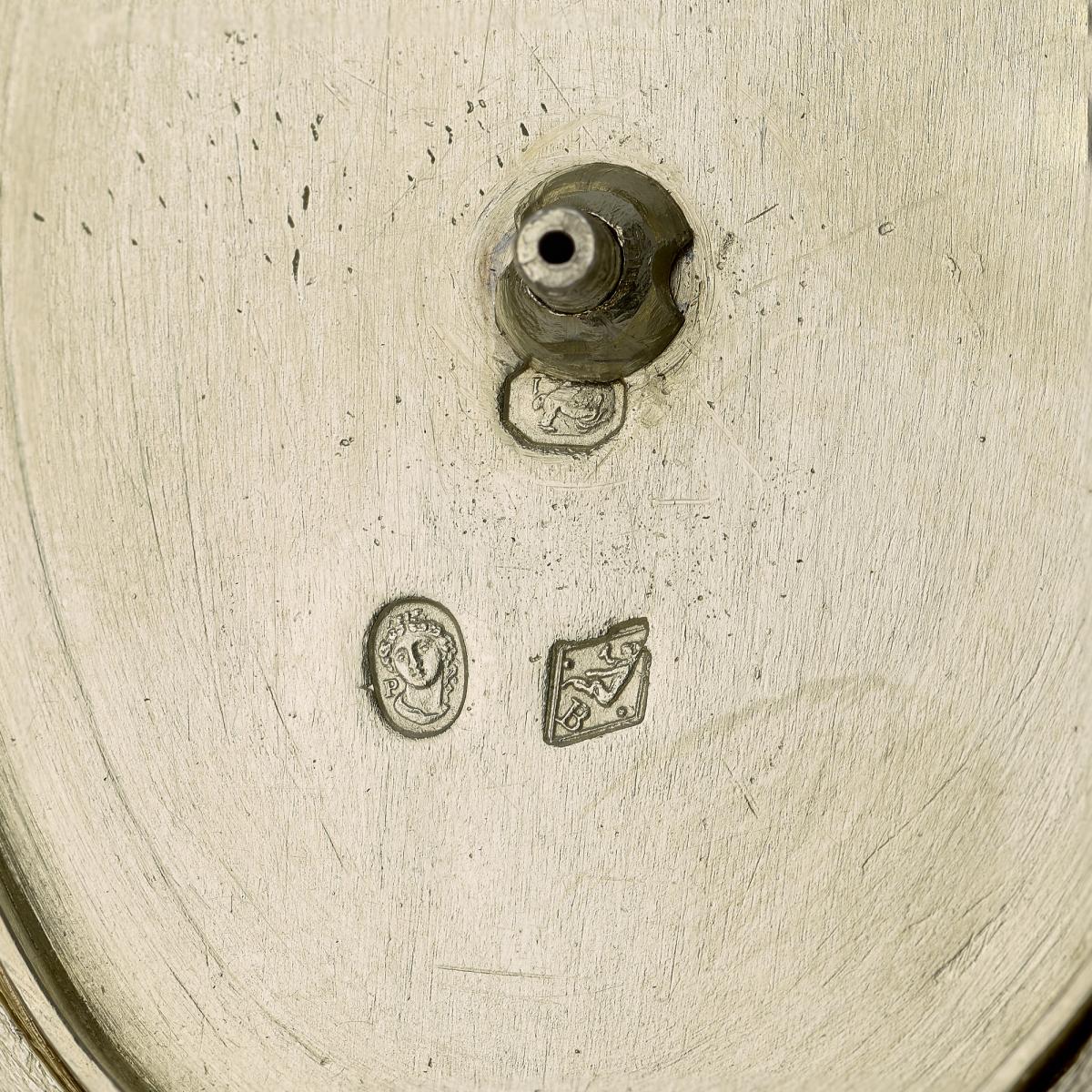
The lower left oval mark is the Greek woman’s head mark for 1793 (with the letter “P”). Apparently this mark, and others dating to the late 19th century, were common marks in the post-revolutionary period and employed in some contexts until at least 1830. The lower right hallmark is that of Biennais, a “B” in a vertical diamond-shaped lozenge with a monkey above that, with two pellets (dots) to either side of the monkey. As noted, the photos of the Napoleonic medal cabinet do not show the maker’s mark and hallmarks in any detail. The images I’m posting of the Biennais maker’s mark and associated hallmarks come from a silver, gilt, and ebony teapot made by Biennais c. 1809-1815, that is curated in the Royal Collection Trust, RCIN 48395 (https://www.rct.uk/collection/48395/teapot). These 7 images are copyrighted (Royal Collection Trust / © Her Majesty Queen Elizabeth II 2021). The above photos show the complete assemblage of hallmarks on the underside of the teapot lid.
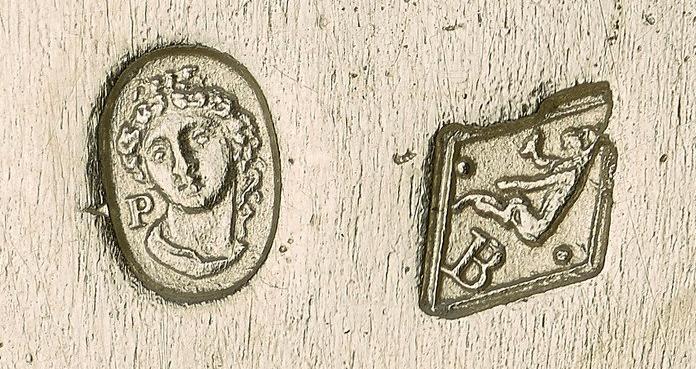
On the right is the Biennais maker’s mark, showing the “B” surmounted by a monkey and flanked by 2 pellets (“dots”). The hallmark on the left is the Greek woman’s head with the letter "P" on the left of the bust in an oval, is a mark identified for 1793. Apparently, this mark, and others dating to the late 19th century, were common marks in the post-revolutionary period and employed in some contexts until at least 1830. Following the revolution, there was a breakdown in systematic guarantee marking of silver and gold. Although this Greek woman’s head mark (and a version with the same bust but with a number 1 to the right of the bust for the period 1794-1797) was instituted in Paris by the Association of Gold and Silversmiths (Association de Orfévres), the use of these punches was only privately done and did not offer any legal guarantee. These hallmarks come from a cropped version of the above photo of the underside of the silver teapot lid made by Biennais c. 1809-1815.
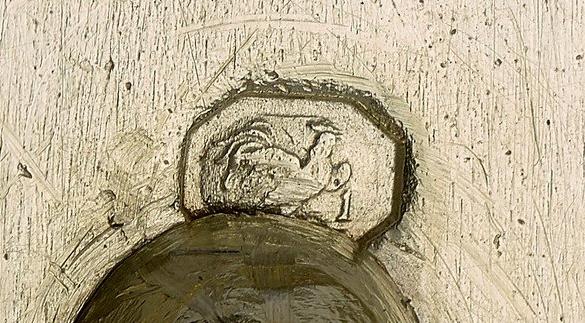
Above is the cock and numeral "1" (1er coq) on the right in an octagon that is the Paris assay office fineness mark for 950 silver. The horizontal octagonal frame probably indicates 1809-1819 hallmark (the standard, or title, mark, poinçon de titre). This photo is cropped and rotated 180 degrees from the above image showing all 3 hallmarks on the underside of the same teapot in the Royal Collection Trust. The mass at the lower edge of the photo is part of the rivet holding the exterior ebony knob to the middle of the lid of the same teapot, which also held a tea caddy nested within itself, one of Biennais’ sets of traveling service ware, necessaires de voyages.
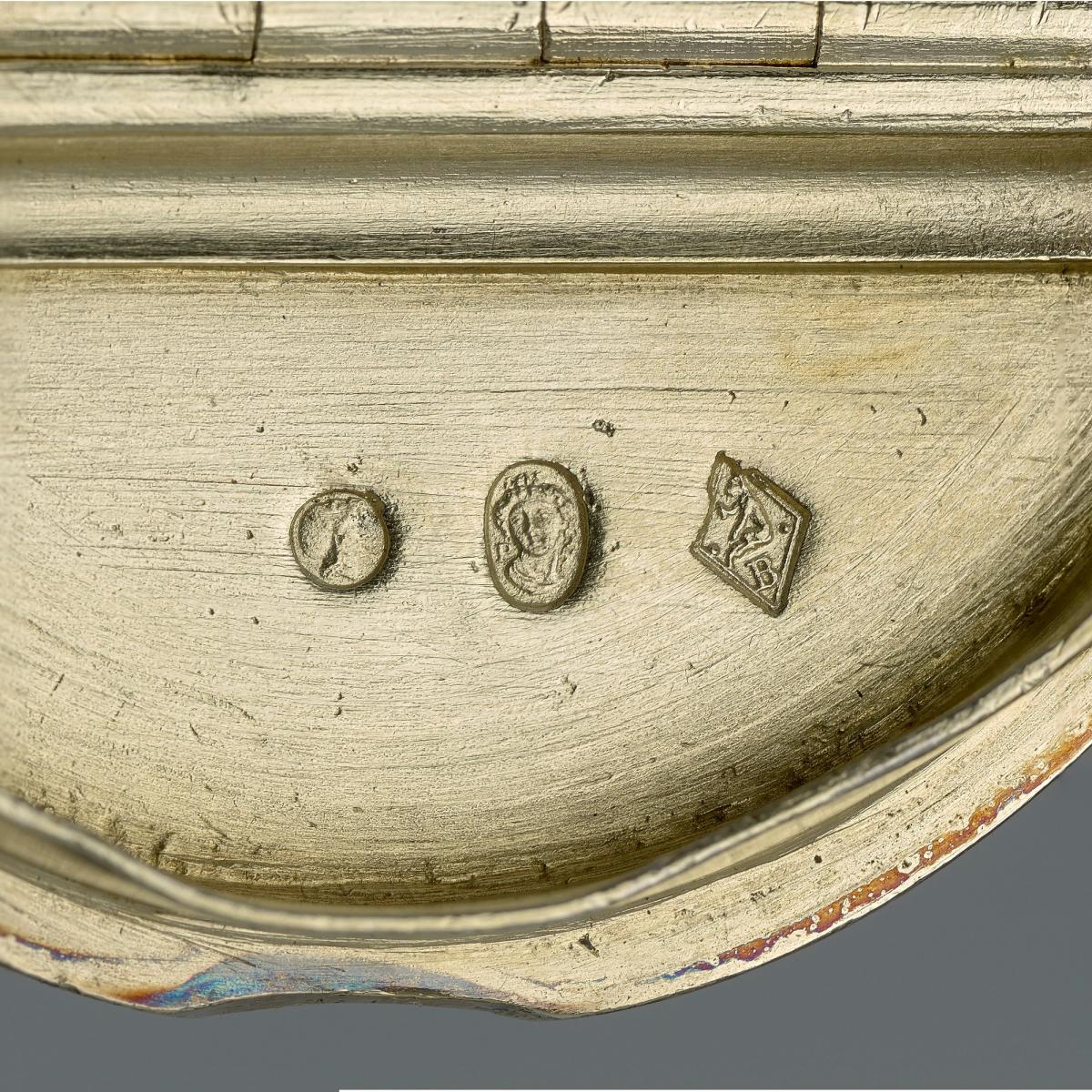
Above is the complete set of hallmarks on the underside of the hinged lid of the teapot (at the back of the lid near the handle), showing from R-L: another example of the Biennais maker’s mark; the 1793 Greek woman’s head with the letter "P" on the left of the bust in an oval; and the helmeted head in a circle that is probably the Paris medium object guarantee mark for silver 1809-1819 (poinçon de garantie). All of these marks are detailed below.
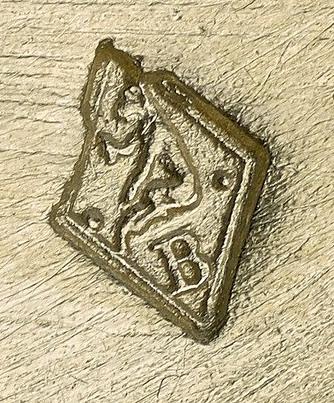
Above is a second example of the Biennais maker’s mark, showing the “B” surmounted by a monkey and flanked by 2 pellets. This image is cropped from the above photo of the underside of the more proximal portion of the hinged lid of the same silver, gilt and ebony teapot made by Biennais and curated in the Royal Collection Trust.
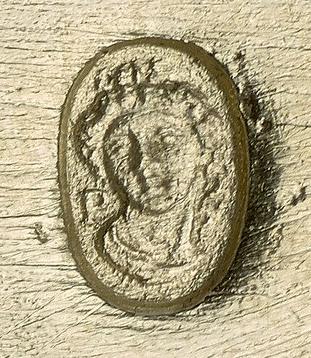
Another example of the mark identified for 1793 showing the Greek woman’s head with a letter "P". This is the mark to the left of the Biennais maker’s mark shown 2 photos above. It is less clear than the first illustration of this mark from the front of the teapot lid shown above, but is likely made with the same die.

Above is the third hallmark on the same part of the underside of the proximal hinged lid of the same Biennais-made teapot as the second example of the Biennais maker’s mark and the Greek woman’s head shown above (cropped from the image showing that Biennais mark, the Greek woman’s head with a "P", and this helmeted head mark). It shows a helmeted head in a circle that is probably the Paris medium object guarantee mark for silver 1809-1819 (poinçon de garantie) This mark is stated to also be present on the Victoria and Albert and the Metropolitan Museum medal cabinets.
I have been researching badges used by judges and some other officials of the Egyptian Mixed Courts (developed to handle increased cases between Egyptian nationals and foreigners in the late 19th century and based on Napoloeonic law). This badge was originally designed and manufactured by the French silversmith Pierre Henri Émile Froment Meurice (1837-1913; he took over his father’s workshop in 1855 and retired in 1907). I have additional bibliographic information about Émile Froment-Meurice in my post of 15 August, 2019 in my thread “Egypt Khedivate Judge’s Badge question” started on 17 November, 2016 in the Middle East & Arab States section. Most of the badges I have encountered that can be attributed to Froment-Meurice are either unmarked or stamped only with his name “FROMENT-MEURICE”. I have only seen 3 examples of his French maker’s mark in a diamond frame that depicts the name "FROMENT" over a rose with "MEURICE" below that.
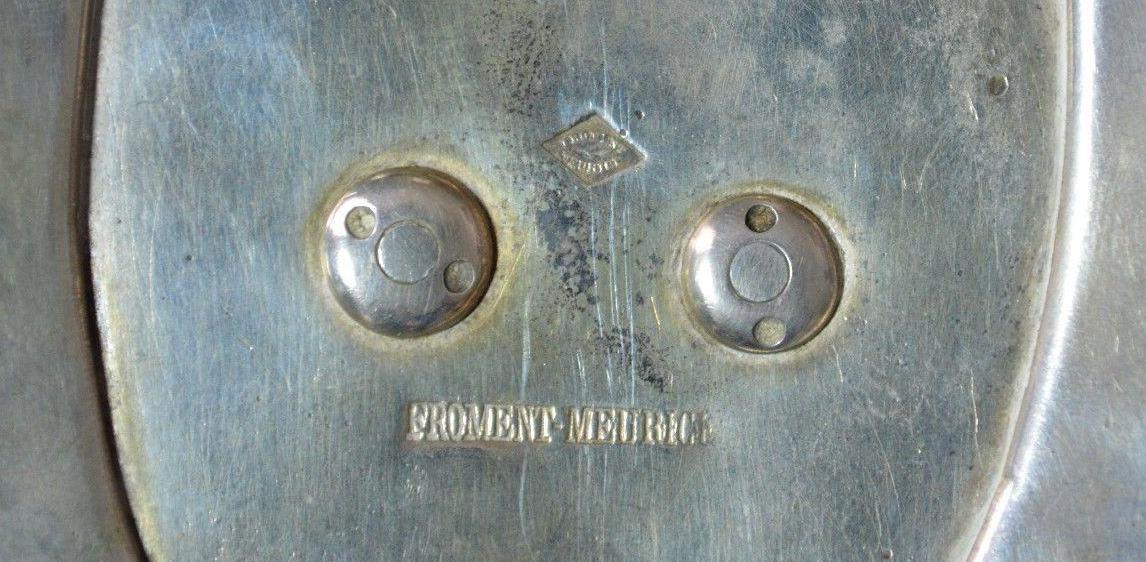
Above is an example of the “FROMENT-MEURICE" name on the reverse of one of the Egyptian Mixed Courts badges, along with the French makers mark in the diamond fame. This is the image of the reverse of a badge from a September 2014 eBay auction archived on the Worthpoint.com website , and is attributed to Judge Apostolo N. Gennaropoulo of the Mixed Tribunals of Alexandria (https://www.worthpoint.com/worthopedia/ottoman-empire-egypt-khedivate-judges-982926374). I have not been able find any biographical information on this individual nor to confirm that he served as a Judge on the Mixed Courts. The badge was offered with the associated case labeled Froment-Meurice and an unframed photo of an individual wearing the badge on a bicolored sash, with the stamboulin coat and tarboosh. Although that coat is usually associated with judges, the bicolored sash (green and red) is usually associated either with individuals working with the prosecutor’s office (Parquet) or other functionaries of the courts such as clerks.

Above is an illustration of the Froment-Meurice mark in the diamond frame showing the maker’s name and rose (from: https://www.langantiques.com/university/mark/froment-meurice/).
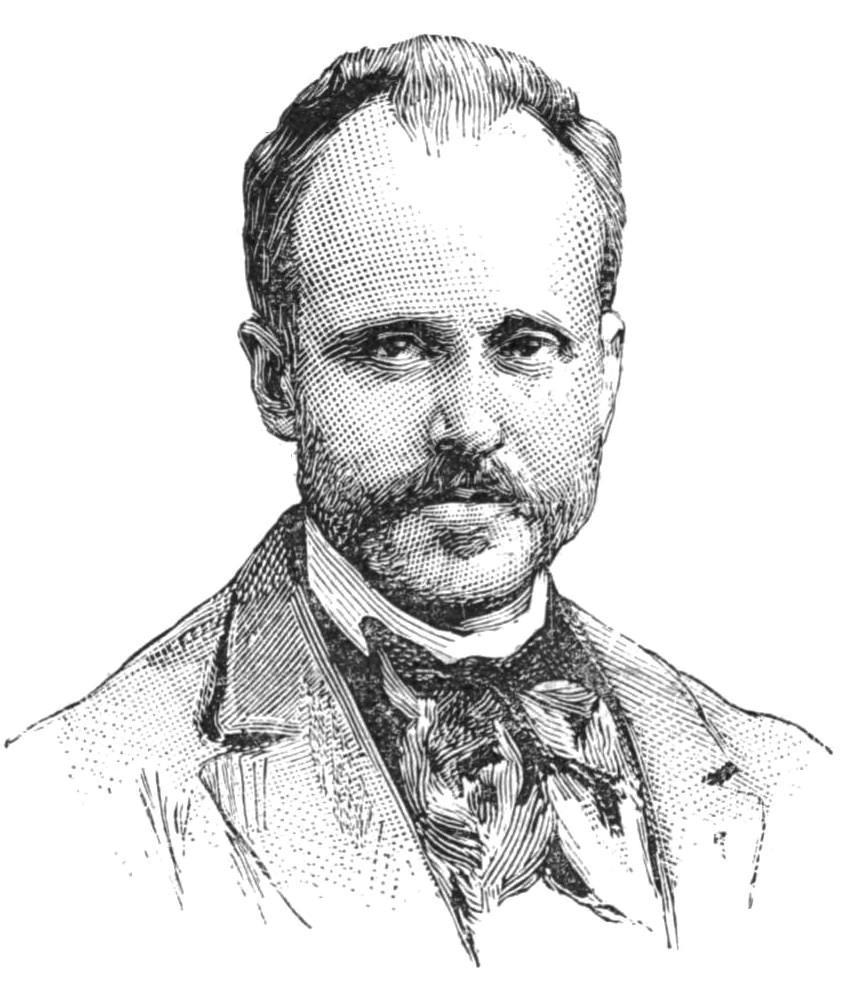
Portrait engraving of Émile Froment-Meurice at the age of 48 from Le mode illustré, 3 October, 1885 (from: https://fr.wikipedia.org/wiki/Émile_Froment-Meurice).
I have seen examples of two manufacturers of these badges who were based in Alexandria, Egypt who also imported items made in France for distribution in Egypt. Wolf Horovitz and Zivy Fréres & Cie.
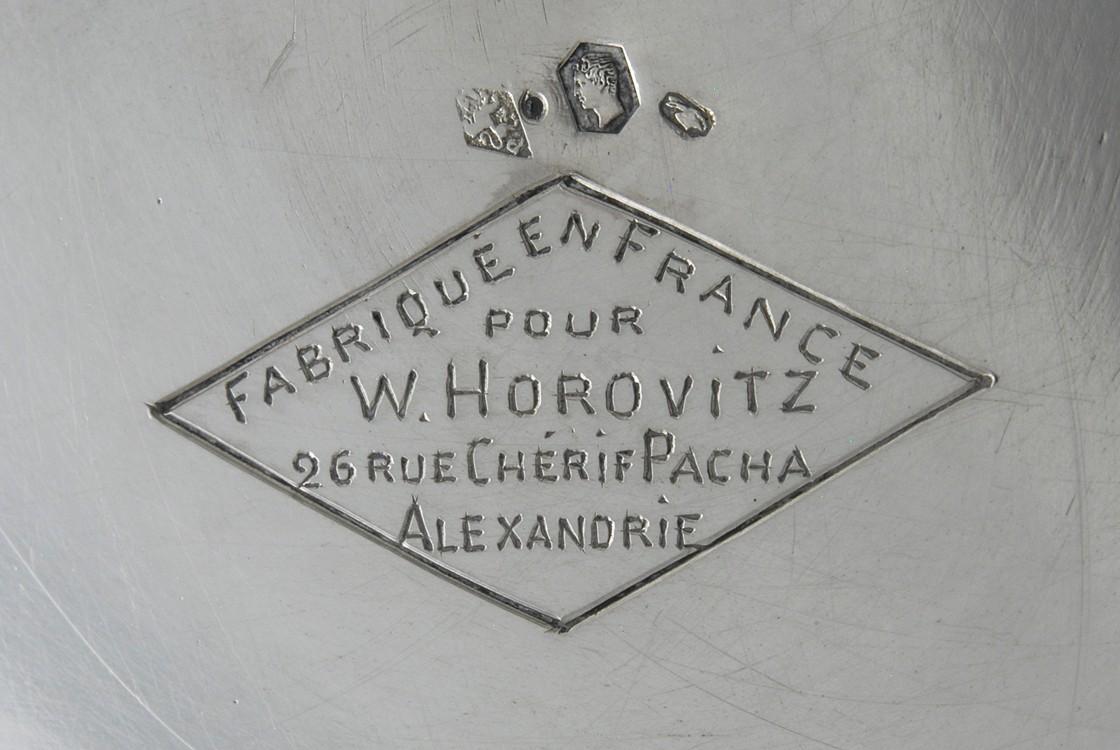
The diamond-framed manufacturer’s mark on a Wolf Horovitz piece made in France for his shop in Alexandria (following the French convention for such maker’s marks). This comes from one element of a 4-piece art deco tea set c. 1930 that was part of a past auction by Grabek in Lublin Antique Silver, Reference No 279 (https://grabekwlublinie.pl/en/offer/1421-paul-bibollet-wolf-horovitz-srebrny-serwis-do-kawy-i-herbaty-art-deco-paryz). It shows 3 French hallmarks above the Horovitz mark. This photo illustrates the W. Horovitz name and identifies this piece as having been made in France for Wolf Horovitzes shop in Alexandria. The 3 examples of Mixed Courts badges made by this atelier that I have seen photos of all show only the “HOROVITZ” name and the set of 3 Egyptian hallmarks, indicating they were made in Egypt and not France. Wolf Zeev Horovitz was born 18 August 1883 in Alexandria, Egypt and died 16 February, 1959 in Geneva, Switzerland and was of Romanian descent. The 3 French hallmarks above the Horovitz mark are: a diamond-shaped cartouche mark on the left, showing a lion with the letter “P” visible is the French silver manufacturer who created this piece for export to Wolf Horovitz. The Grabek W. Lublinie listing identifies a Paul Bibollet with this piece, and it is certainly his maker’s mark that is shown here. The image above does not show the right side of this maker’s mark (the uppermost portion in the photo above), but a photo of another mark on this tea set shows the presence of a “P” on the left side of the mark and a “B” on the right side (see below). The middle hallmark is the large guarantee of Mercury in an irregular hexagon denoting French-made 950 silver for export (1878-1973-accordin to the Online Encyclopedia of Silver Marks, Hallmarks, & Maker’s Marks website for French Hallmarks: http://www.830-1000.dk/Ffrench_marks.html); and on the right is the small guarantee of a rabbit/hare. The diamond-shaped cartouche with Horovitzes name below the French hallmarks appears to be engraved, and the lettering is punched with multiple chisel marks forming the letters.
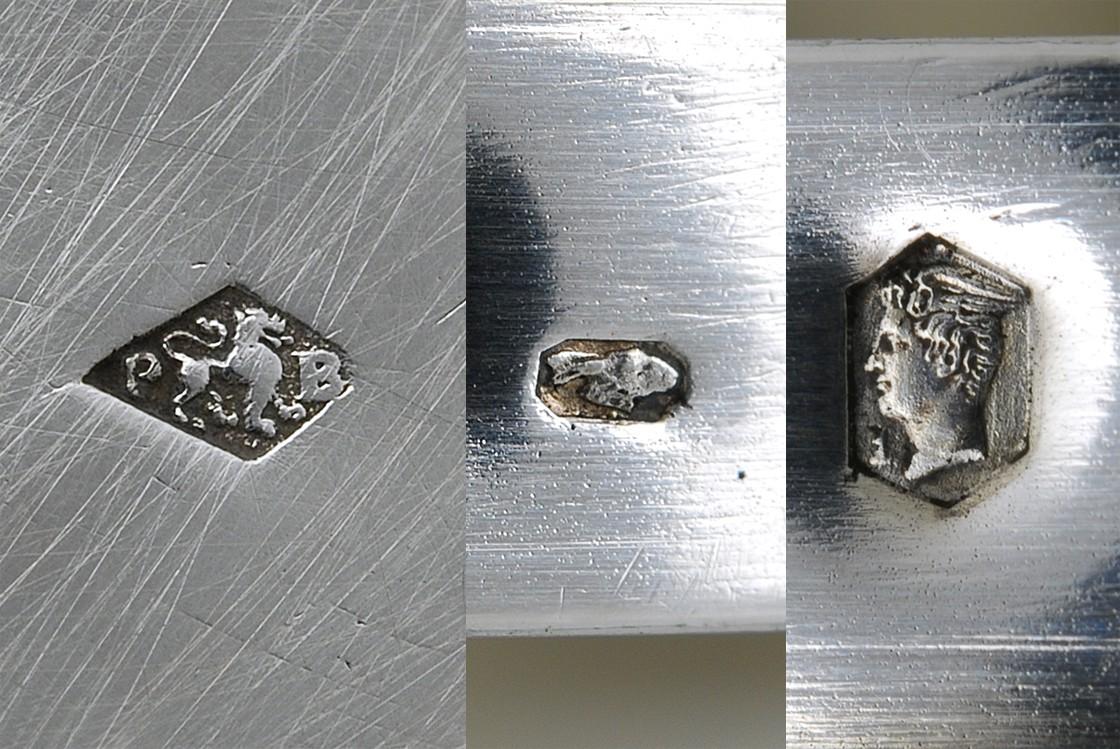
Above is a close-up photo of three of the hallmarks on this same tea set, but from other pieces than the photo above with the Horovitz mark. From left to right: a better image of the Paul Bibollet maker’s mark, showing the full lion design and the “P” and “B” letters. The goldsmith Paul Bibollet of Paris appears to be identified as active and using this maker’s mark between 1924-1934; Center is the small guarantee of a rabbit’s head; At the right is the large guarantee of Mercury in a hexagonal from a with the number "1" in the lower left. The Grabek W. Lubinie website identifies the Mercury mark with the cypher 1 as the fineness mark but states (incorrectly?) that the hare’s head denotes “re-imported goods”.
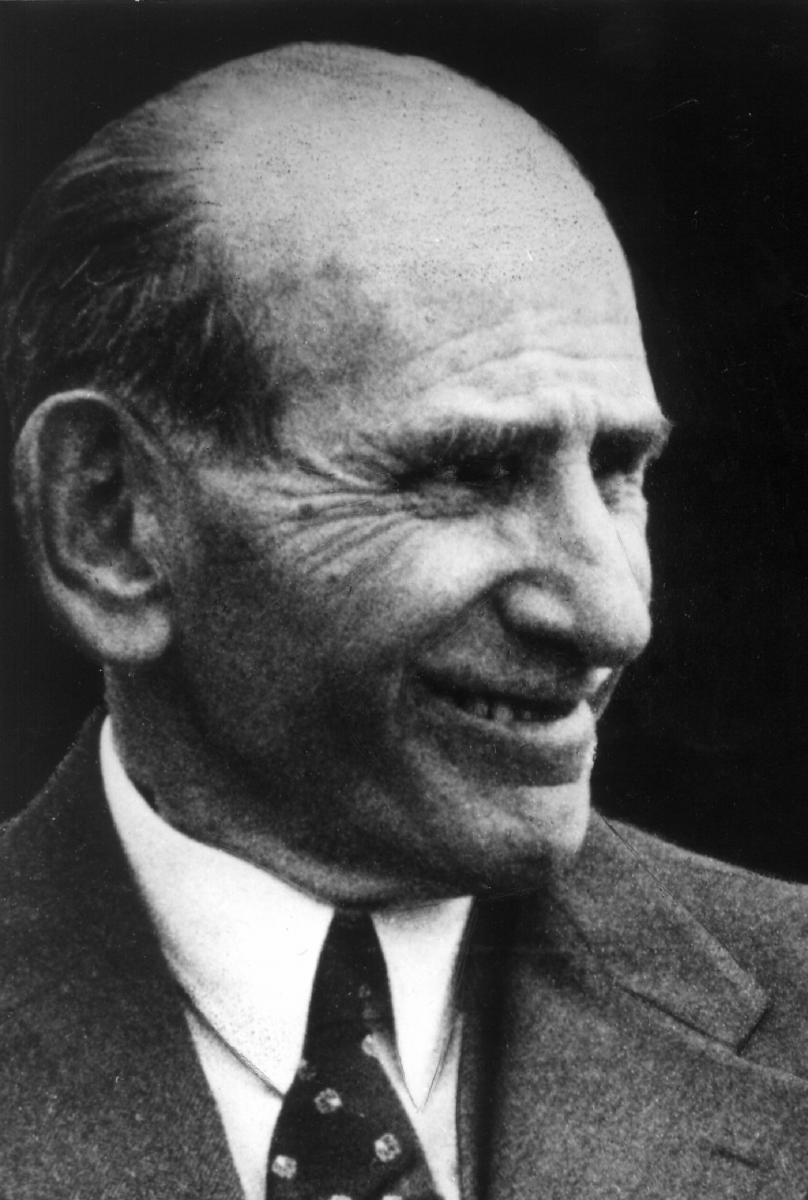
Undated photo of Wolf Zeev Horovitz from Geni.com genealogy website (https://www.geni.com/people/Wolf-Zeev-Horovitz/6000000002383946981). Horovitz had both more modest and élite clientele and also provided jewelry and possibly other goods to the royal courts of Kings Fuad I and Farouk I. I have seen images of one watch made by the well-known Patek, Philippe & Cie. of Geneva, Switzerland bearing the name W. HOROVITZ-ALEXANDRIE” on the face of the watch (but the case is marked with PATEK PHILLIP & CO. GENEVE”, and “W. HOROWITZ (sic) ALEXANDRIE”).
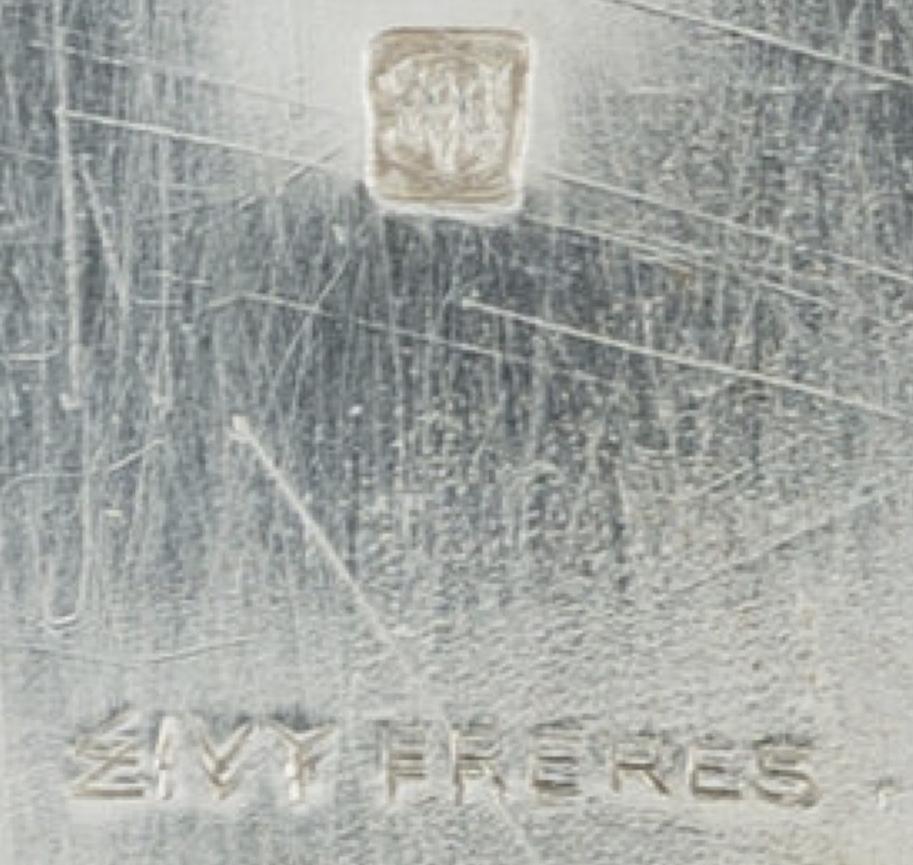
Above is the only example of a mark for Zivy Fréres & Cie. of Alexandria, Egypt on the single example I have found an image of for an Egyptian Mixed Courts badge made by this atelier. The illustration is of a badge offered in a 24 April, 2019 auction by Heritage Auctions. Lot # 74177 (https://fineart.ha.com/itm/metalwork/an-egyptian-silver-magistrate-s-badge-from-the-reign-of-abbas-ii-egypt-circa-1900-marks-unidentified-cipher-/a/5403-74177.s?ic10=FeaturedPastSalePrices-Thumbnail-052317#). This piece was almost certainly struck in Alexandria. I have not seen any example of a French diamond-shaped mark used by either Zivy Fréres & Cie., or the probably related silversmith Cesar Zivy. This example is silver. The “ZIVY FRERES” is double struck. I cannot distinguish details of the upper hallmark in either a square or rhomboid frame, and do not know if it is a French mark(?). It is not one of the 3 Egyptian silver hallmarks (that identify the purity and the location of the assay office where it was marked; the mark indicating Egyptian-made silver; and the date hallmark).
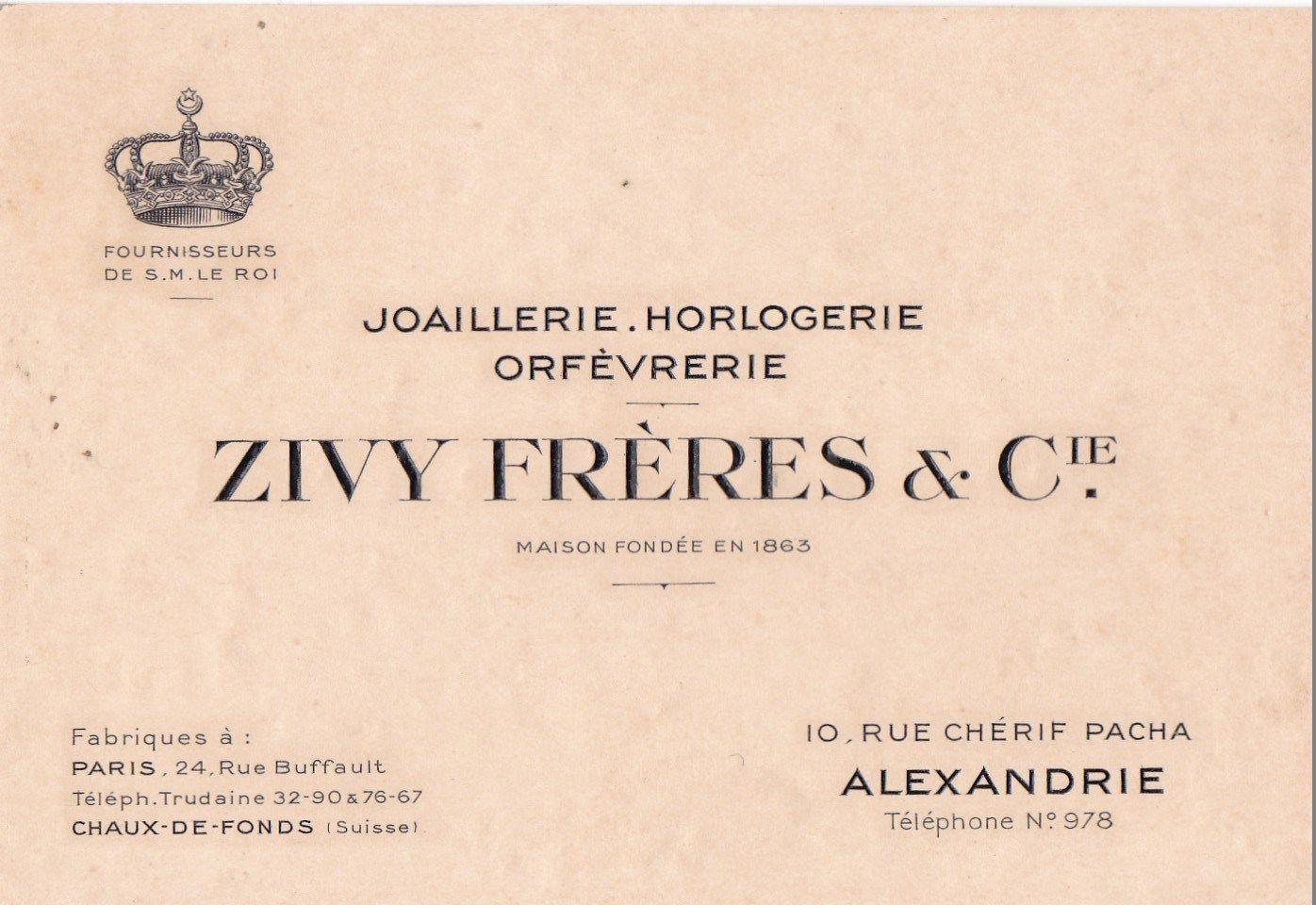
Business card for Zivy Fréres & Cie. identifying the French and Swiss addresses of their European manufacturing locations and the shop address in Alexandria (from: https://www.flickr.com/photos/kelisli/5478285452/).
I also have seen several receipts from Zivy Fréres & Cie. for a range of silver pieces and repairs. Advertisements in contemporary publications also are common in internet images. As seen on the card above, the the Zivy Fréres receipts and advertisements also include the mention of selling watches (common among most Egyptian jewelers at the time). I have seen examples of a Swiss-made pocket watch marked with the Zivy Fréres name and a travel clock manufactured in Switzerland (and marked with Zivy Fréres name as the distributor in Alexandria). A low-resolution photograph (published in 1901 in an unspecified source) of the storefront of Cesar Zivy’s (possibly one of the Zivy Fréres) watchmaker and jewellers’ shop in Cairo shows painted on the front window probable recognition awards from Paris and Alexandria. This suggests some manufacture in Paris, but I have not yet identified a French maker’s mark for Cesar Zivy (nor the form of his Egyptian manufacturer’s mark). A copy of that photo of Cesar Zivy's shopfront is shown as the final image in my post of 8 December, 2018 on the thread “Egypt Khedivate Judge’s Badge question” that I started on 17 November, 2016 in the Middle East & Arab States section of “Rest of the World: Medals & Militaria” here on GMIC.
0 -
This is the maker's mark inside the case for the Cairo University chest badge awarded to Albert M. Baer in November of 1972, illustrated in my previous post here of 3 March.
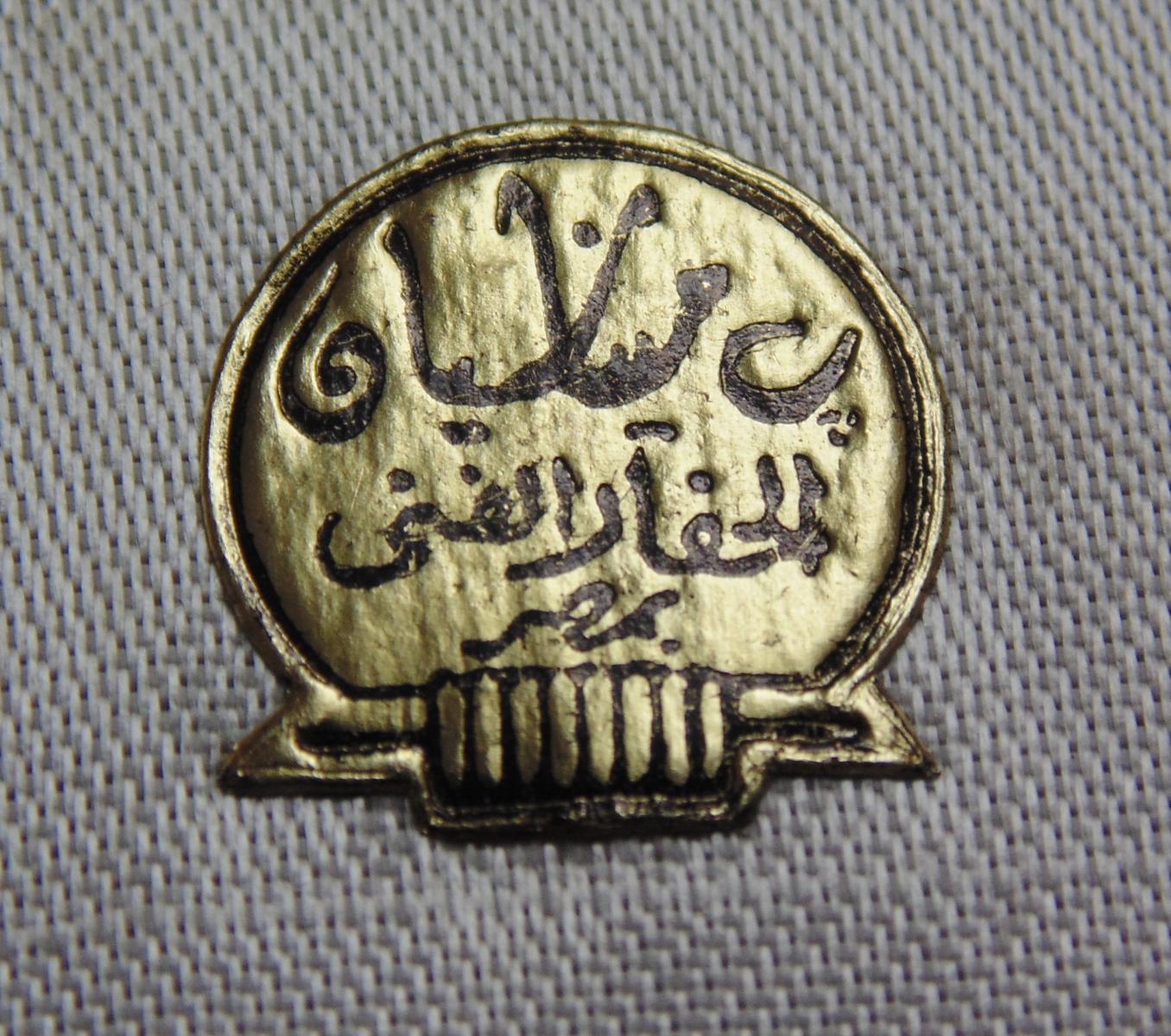
This is the gold foil label attached to the inside of the case lid, that was covered by the paper tag taped to the case reading: "PRESENTED TO ALBERT M. BAER CAIRO UNIVERSITY NOVEMBER 1972". I do not know who this manufacturer is. The margin of the label is a stylized modern version of the Ancient Egyptian cartouche, used to identify names in hieroglyphic texts, and represents a border of cordage (note the "wrapping" of the basal knot element). Ancient Egyptian cartouches are always oval in shape, not round. The label is maximally 14 mm wide x 15 mm tall.
The lapel pin that was included with this recent eBay listing, that is the same as the one illustrated by UKR in his post of 25 February, 2021 and that Owain identified on 26 February, 2021, measures 20 mm in maximum width x 23 mm tall. The chest badge measures maximally 46 mm wide x 29 mm tall (including the cast suspension loop. The ribbon is 54 mm long x 25 mm wide. The case measures 107 mm long x 52 mm wide x 15 mm deep, and is made of white cardboard lined with white satin on the inside of the upper lid and green velvet on the medal bed, The exterior is a textured green paper covering.
0 -
In relation to the lapel pin that UKR posted on 25 February, 2021 and that Owain identified on 26 February, 2021, here are some photos and information on another example of the same lapel pin and a different Cairo University chest badge awarded to Albert M. Baer in 1972. This set is from a current and ongoing eBay auction of a "Cairo University, Egypt, Medal & Lapel Button" (https://www.ebay.com/itm/275191562022?mkevt=1&mkpid=0&emsid=e11011.m43.l1123&mkcid=7&ch=osgood&euid=bb31f2799c344042a2ee802a3153f735&bu=43107496168&osub=-1~1&crd=20220303055213&segname=11011&sojTags=ch%3Dch%2Cbu%3Dbu%2Cosub%3Dosub%2Ccrd%3Dcrd%2Csegname%3Dsegname%2Cchnl%3Dmkcid). Albert Baer was an American cutlery manufacturer and active fundraiser for heart research. In the 1960s he toured ~30 countries with former US President Eisenhower's physician, Dr. Paul Dudley White, to raise money for cardiology research and education. Baer served as the chairman of the worldwide committee on fundraising for the International Cardiology Foundation, that awarded him the first Gold Heart Award in 1968. Baer also performed some work for St. John's College of Business Administration and was National Chairman of the General Studies Alumni Fund for Columbia University. Baer was most likely presented with this award for some aspects of his international fundraising for cardiology research and education efforts, although I have not found any details about this.
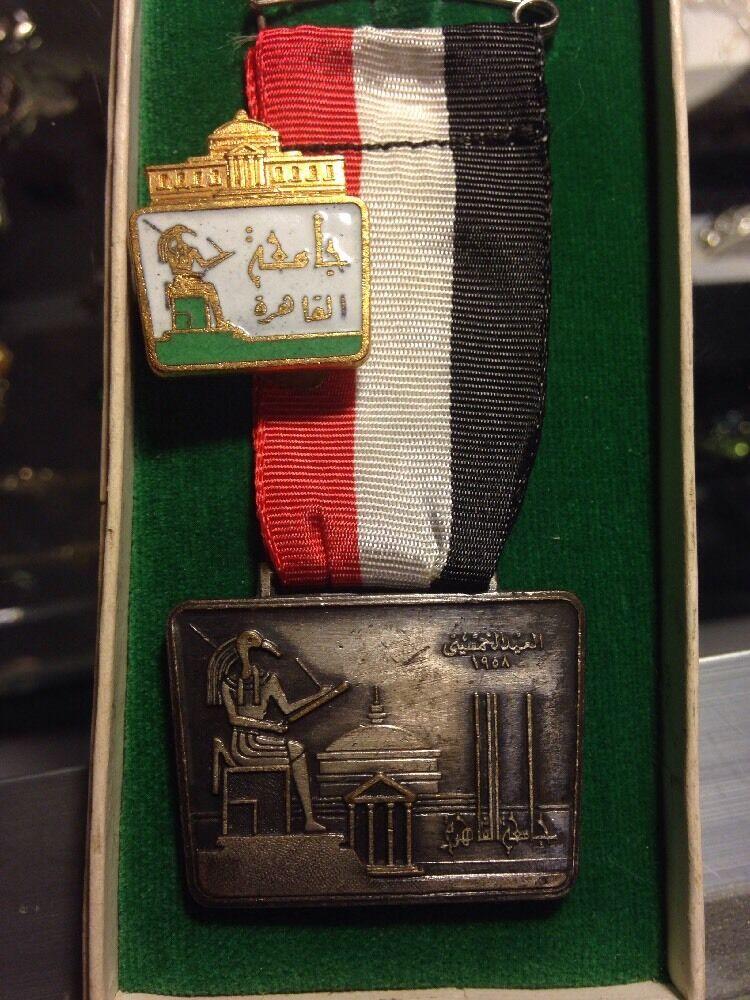
Another example of the same Cairo University lapel pin as posted by UKR on 25 February, 2021, along with a Cairo University chest badge in its original case from a current eBay auction.
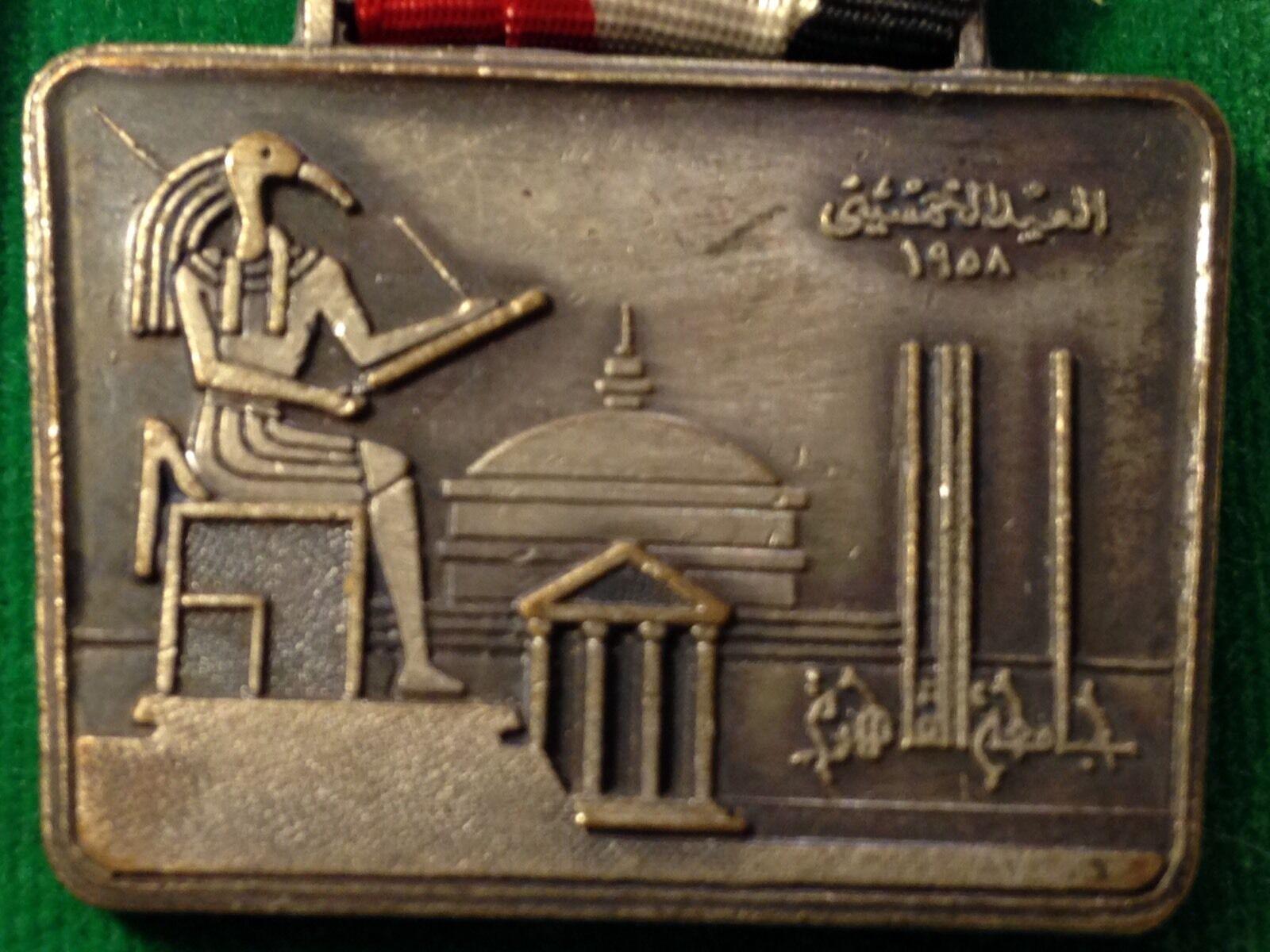
Close up of the chest badge from Cairo University. The image of the seated ibis-headed god writing represents the Ancient Egyptian god Thoth, usually depicted with a document and writing stylus. Thoth performed a number of otherworldly bookkeeping tasks and is a symbol of scholarship. He is most notably depicted in the "weighing of the heart" scenes on various funerary papyri: recording the outcome of weighing the heart of a deceased person against the feather symbol of Truth (Maat), during preliminary processing of dead souls as depicted on examples of the Ancient Egyptian text commonly called the Book of the Dead (more appropriately translates as the: Book of Coming Forth by Day ). The image of Thoth seated and writing is the shield emblem of the modern Cairo University.
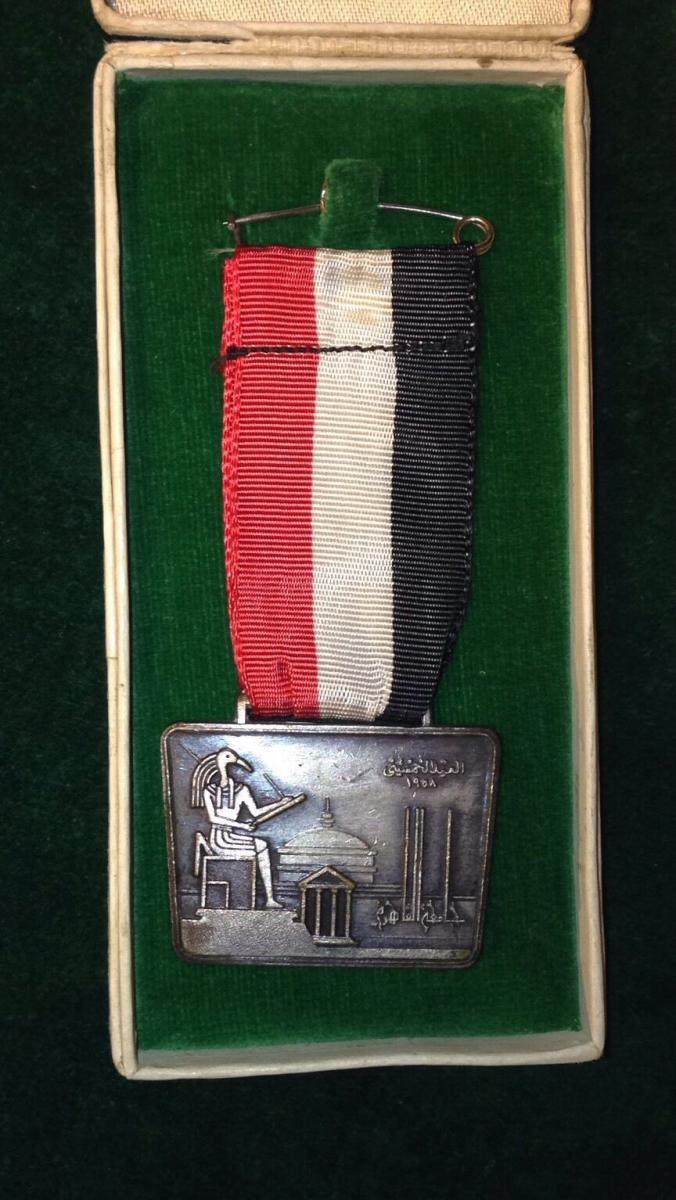
Obverse of the Cairo University chest badge from this current auction the includes the lapel pin.
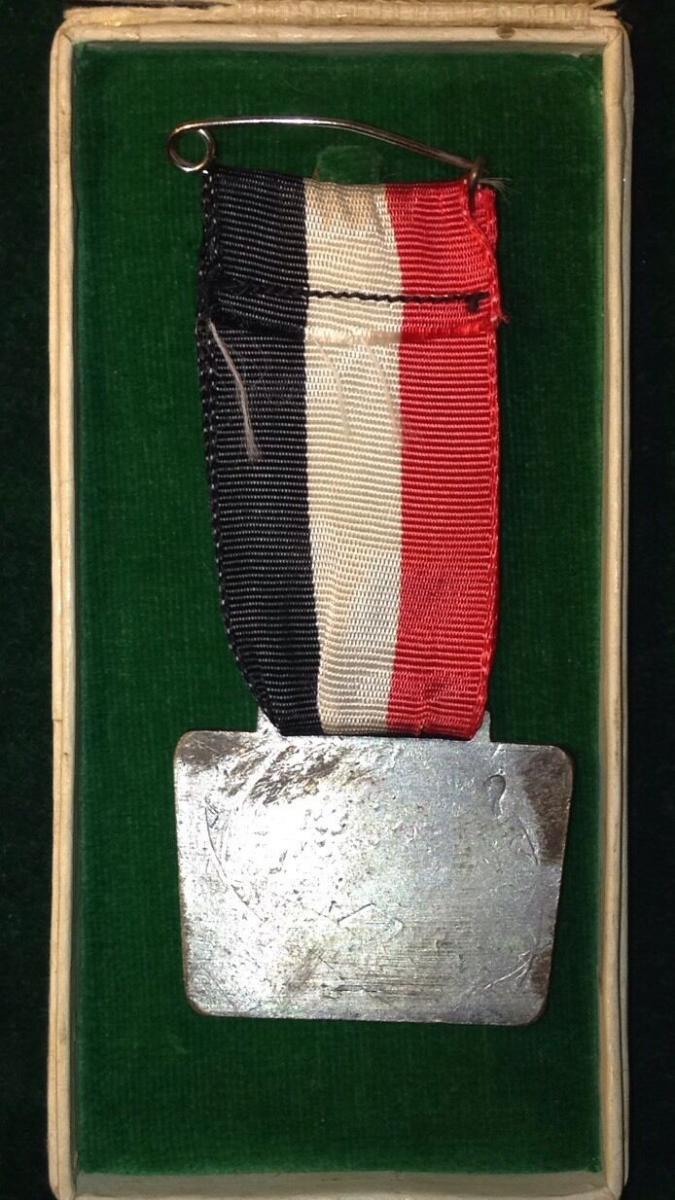
Reverse of the chest badge showing no obviously legible maker's marks

Close up of the obverse of the lapel pin against the ribbon of the chest medal
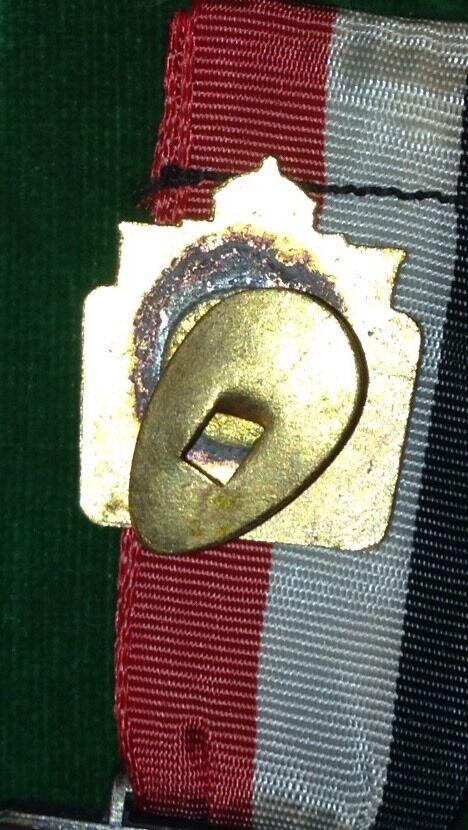
Reverse of the lapel pin, again no maker's mark is visible. Note that the form of pin back appears to be the same as shown in UKR's example, and this form was used by Tewfik Bichay on examples of pins (i.e., for South African Air Force Squadron pins, see the example in the 2nd photo of my post of 21 August, 20 marked "BICHAY CAIRO" and the last photo in my post of 21 September, 2020 of an example marked with Bichay's Arabic maker's mark , both on the thread "Question about the Order of Ismail/Nishan al-Ismail" here in the "Middle East & Arab States" section). Obviously this form of pin back would have been available commercially and would not by itself be indicative of manufacture by T. Bichay (although many of the pins he manufactured are unmarked). The examples on South African Air Force Squadron pins are solid pieces that are soldered to the reverse of the pin, they have something like a cufflink back morphology, but are immobile.
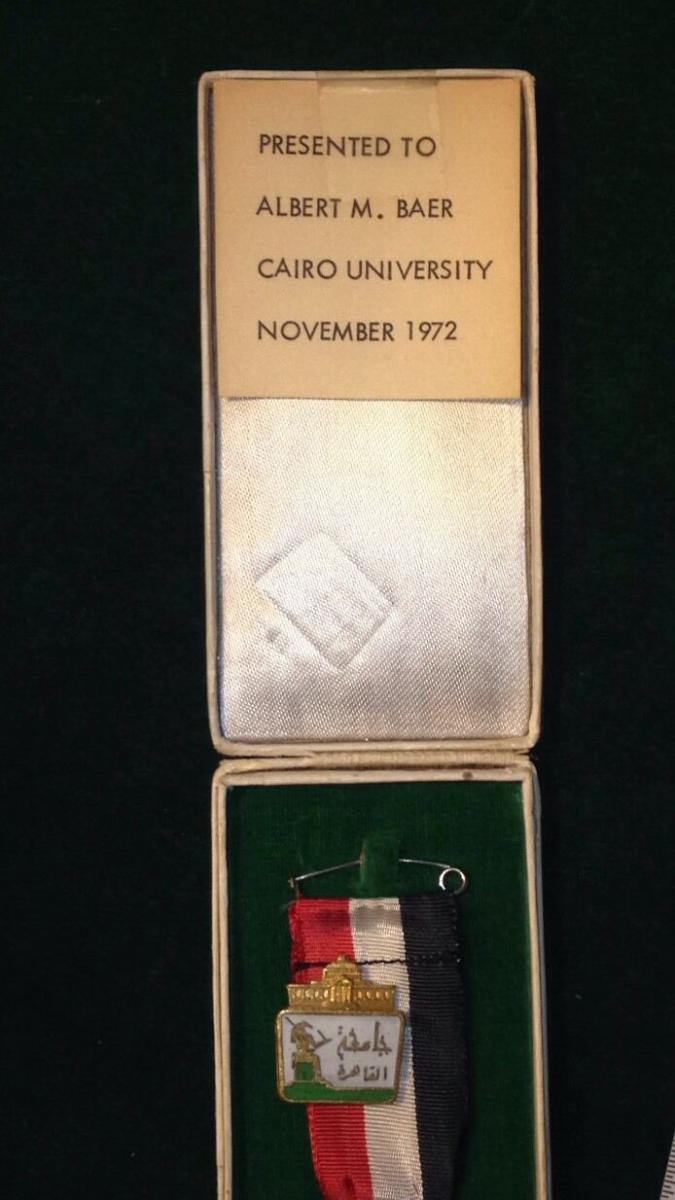
Interior of the case for the chest badge, with the paper note identifying the presentation of this honor to Albert M. Baer in November of 1972. I do not know if this paper covers a possible maker's mark inside the upper case lid.
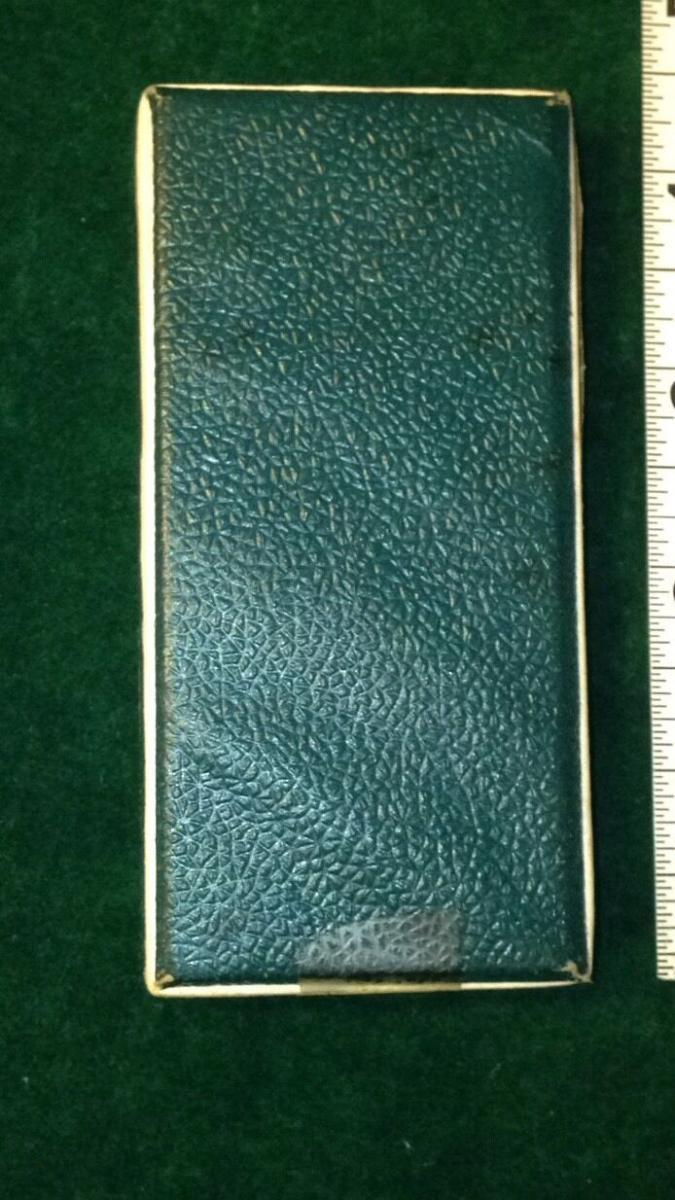
Exterior of the case for the chest badge. The hinge is at the uppermost position in this photo and the opening has cellphone tape in place that kept the paper note in place inside the case.
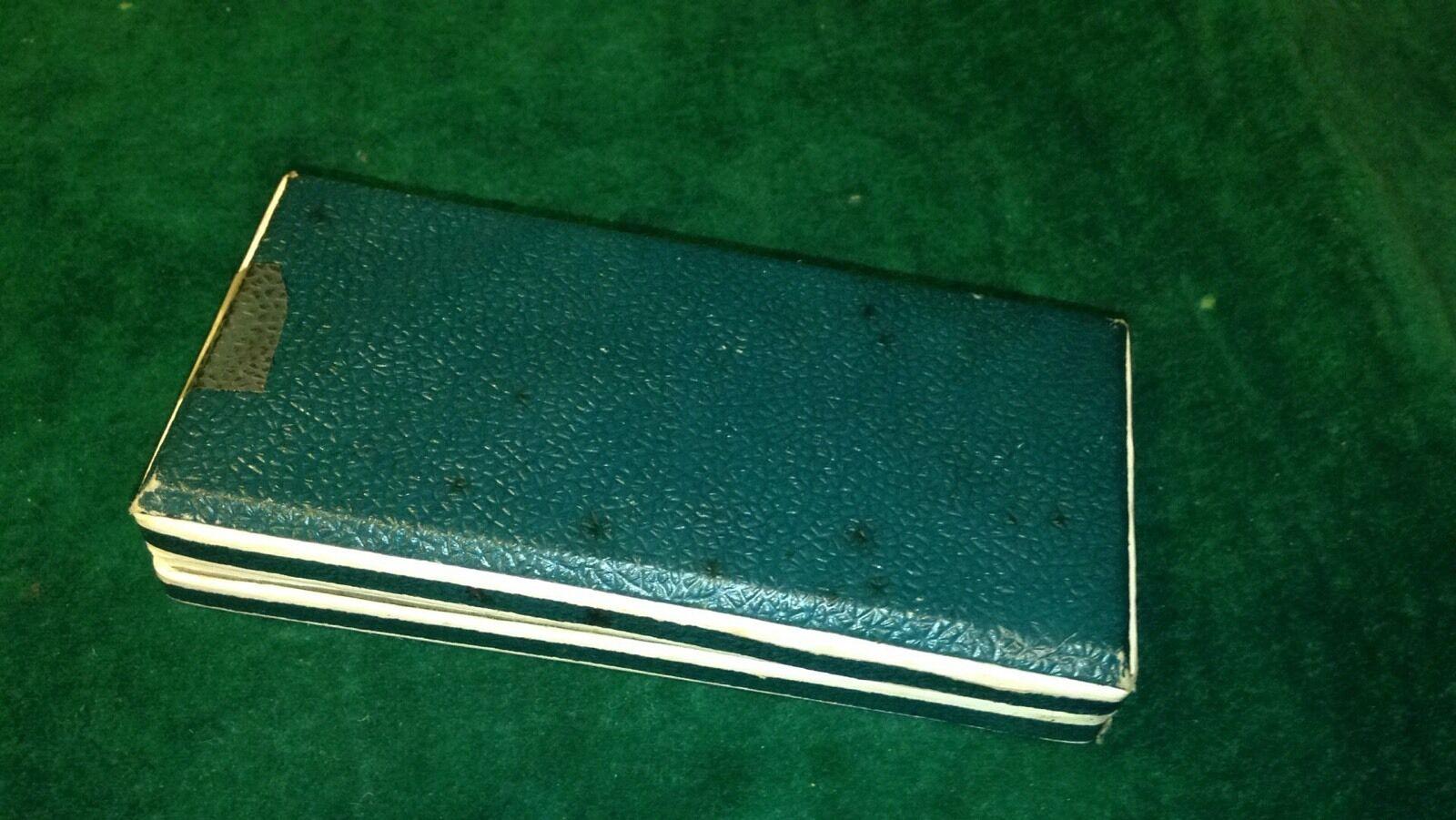
Another view of the same case with the hinge to the right and the opening on the left showing the cellophane tape that is attached to the paper label inside.
0 -
Sorry to be redundant, Marcon1's & El Ninja replies did not show up on my refreshed screen until I was posting this.
Floyd's Medals (https://floydsmedals.com/product/pakistan-medal-for-centennial-of-quaid-i-azam/) identifies this as a Pakistanis medal, Medal for Centennial of Quaid-i-Azam, with the brief description: "Muhammad Ali Jinnah was the founder of Pakistan, serving as its first governor-general after long service in the Indian parliament. He is referred to as “Quaid-i-Azam” (Great Leader)." The example on their webiste is identified as Product ID: A-3447, and is offered for $25.
the Military Glories Past & Present website (https://militaryglories.co.uk/medal-commemorative-of-the-centenary-birth-anniversary-of-the-great-leader-1976-tamgha-i-sad-saala-22-p.asp) has an example on offer for £12.00.
Medal Medaille inlcudes the following description (http://www.medal-medaille.com/sold/product_info.php?products_id=3546of previously sold example (PK120, shown below): "Circular cupro-nickel medal on scroll and bar suspension; the face with the head and shoulders portrait of Muhammad Ali Jinnah facing left, circumscribed in Urdu; the reverse with the star and crescent of Pakistan, an inscription in Urdu above, laurel branches to either side, dated ‘25 December 1976’ below in Urdu letters and numerals; slight age oxidisation marks; on replaced correct ribbon. The medal was instituted to mark the centenary of the birth of the ‘قائد اعظم’ (Quaid-e-Azam = Great Leader), Muhammad Ali Jinnah (1876-1948), founder and first leader of the independent state of Pakistan whose extraordinary life and achievements make him one of the great figures of the 20th Century."

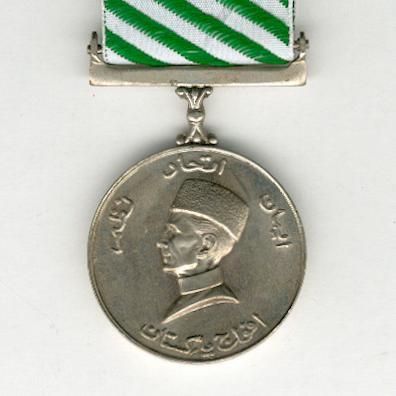
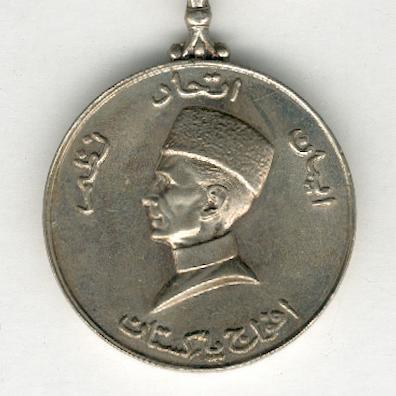
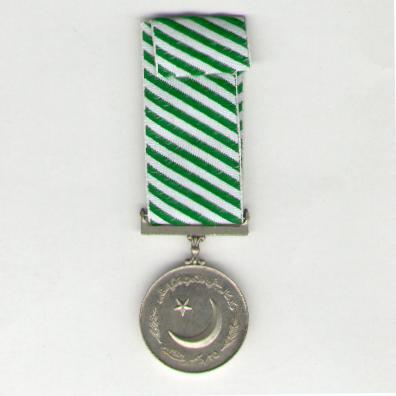
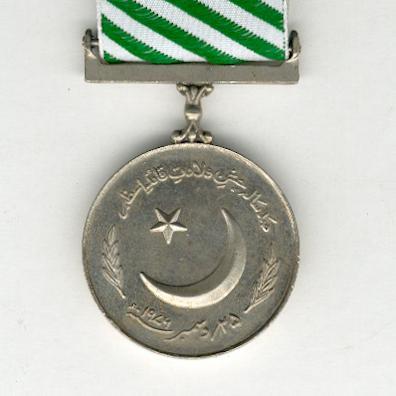
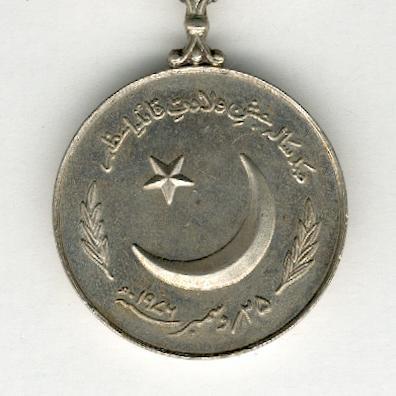 0
0 -
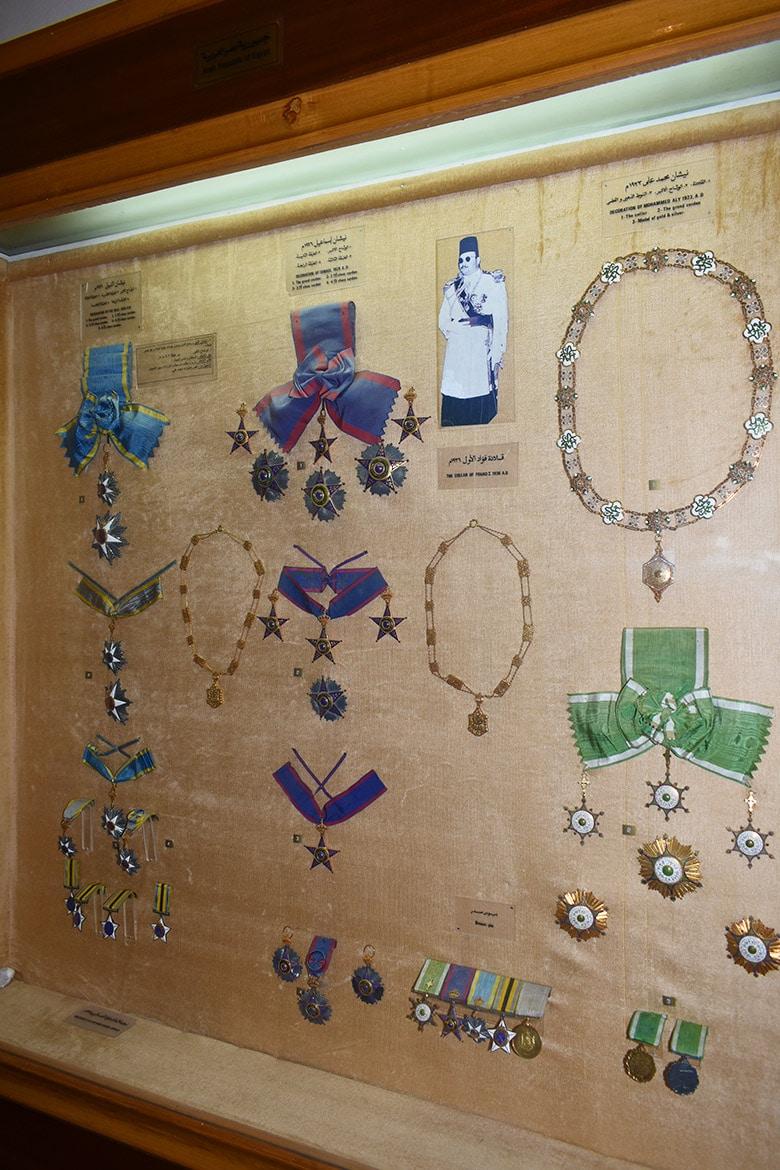
This image of a display case in the Medals and Decorations Museum within the Abdeen Palace complex in Cairo shows a larger view of the display of the Order of Ismail that I illustrated in my post of 26 January, 2022. This is a low-resolution photo, but provides a larger view of the layout of this case's contents. This illustration comes from an 29 October, 2020 article in the Egyptian independent online magazine Linesmag by Mariez Hany titled “Exhibiting glory and grandeur: Abdeen Palace Museums”, archived on the lines-hub.com website (https://lines-hub.com/exhibiting-glory-and-grandeur-abdeen-palace-museums/). This photo is used courtesy of Linesmag and copyrighted (©Linesmag), but single images with credit may be used for editorial but not commercial purposes. This photo does include the full layout of the Order of Ismail awards: showing the 3rd Class Commander neck badge and ribbon, that was only party visible in the FOURSQUARE CITY GUIDES image that is the first photo in my 26 January post. At the bottom of the display is a 4th Class Officer breast badge on the ribbon with rosette, flanked by two additional examples of the Officer badge without attached ribbons. This case predominantly shows the three highest orders of the Kingdom of Egypt: the Order of Mohammed Ali, the Order of Ismail, and the Order of the Nile, along with a couple of additional awards. The right side of the Case shows (from top to bottom): the Collar of the Order of Mohammed Ali; the 1st Class Grand Cordon sash with one attached sash badge, flanked by two additional sash badges, with 1 example of the breast star of this class directly below the sash badge attached to the sash. The 2 breast stars below 1st Class breast star appears a bit smaller and are almost certainly the 2nd Class Grand Officer stars. At the bottom are the Gold Medal (left) and the Silver Medal (right) of the Order of Mohammed Ali. The photograph of King Farouk I shows him wearing the Collar of Mohammed Ali, the sash and breast star of the Grand Cordon Order of Mohammed Ali, the breast star of the 1st Class Order of Ismail, and the breast star of the 1st Class Order of the Nile. The 2nd Class Order of Ismail is flanked by two examples of the Collar of Fuad I. At the bottom of the display to the right of the 4th Class Officer breast badges of the Order of Ismail is one of the unique miniature medal bars made for King Farouk I that Owain photographed at this display in Abdeen Palace. Owain published his image of this specially-sized set of 5 medals as the 1st photo in his article: Owain Raw-Rees, 2006, “King Farouk and his Awards", JOMSA, Vol 57, No. 4, pp: 15-23; and also shown as the 2nd photo in: Owain Raw-Rees, 2018, "Egypt-King Farouk and his Dress Miniatures", Miniature Medals World, No 130. March). I included Owain’s photo of this miniature bar as the 4th-to-last-photo in my post of 31 October, 2020 on this thread. On the far left of the display case (from top to bottom) are: The 1st Class Grand Cordon Sash with attached sash badge and breast star below it of the Order of the Nile; the 2nd Class Grand Officer neck badge and breast star of this Order, the 3rd Class Commander neck badge of the Order of the Nile; on the two plexiglass supports are the 4th Class Officer breast badge with a rosette on the ribbon to the right of the 3rd Class neck badge; and on the left of the 3rd Class neck badge is the 5th Class Knight breast badge of the Order of the Nile. Below the 4th and 5th Class Order of Nile insignia are 4 examples of the Order of the Military Star of King Fuad I. They are likely displayed to show both the obverse and reverse designs, the example furthest to the left shows the gold wreath of the obverse, and while I will guess that the example on the leftmost plexiglass support may also exhibit the obverse, the image is not high enough resolution to be certain.
0 -
Here is a postcard image of the Austrian composer Johann Baptist Strauss II, known as Johann Strauss Jr., the “Waltz King”, showing him wearing a miniature of the Order of Medjidie on the chain on his lapel, along with two round medals I cannot identify. He also wears the full-sized neck badge of the Ottoman Order of Medjidie (probably the 3rd Class, although Wikipedia and the many online bios that borrow wiki “information” repeat the allegation he was awarded the 4th Class, although that would be a breast badge). There are several photos of Johann Strauss the Younger wearing miniature medals on a chain. However, this portrait of him as a young man has the best detail of any online images I've encountered showing any of his miniature medals, especially this Order of Medjidie. Again, I apologize for cluttering this thread with this Ottoman mini, but this is a good photo of a well-known individual wearing this miniature. The portrait shown below may date to approximately 1850, based on the similarity to other portraits of Strauss the Younger showing a similar hairstyle and wearing only mustaches and not a chin strip with mustaches by 1853, and his more elaborate sideburns and mustaches, that are well documented at least as early as 1870.

This image is from a from a current eMedals offering of this postcard (95 mm x 138 mm), Item: EU7487: https://www.emedals.com/johann-strauss-ii-with-turkish-awards-postcard-eu7487. The image can be zoomed for additional detail. Among the awards that I can find listed that Johann Strauss Jr. received are: the Order of Franz Josef (Imperial Austria); Knight of the Legion of Honor (France); Knight of the Order of the Lion and Sun (Persia); and the Order of St. Alexander Nevsky (Russian Empire). As noted, several other portrait photos of Johann Strauss II show him with many more miniature medals on his lapel chain than this postcard does (those later portraits appear to show up to 12). I do not know the dates of any of these awards. Johann Strauss II sided with the revolutionaries during the nationalist revolutions of 1848 in the Austrian Empire, while his father remained loyal to the monarchy. This political position angered his father (the composer Johann Strauss I) and further aggravated their estrangement over J. Strauss II's decision to pursue a career as a musician and composer. Johann Strauss the Younger's support for nationalist ideals caused professional disadvantages for himself, and he eventually made a show of supporting the monarchy of Franz Josef I (enthroned after the 1848 revolution), writing several patriotic marches dedicated Franz Josef I in what is considered a strategy to ingratiate himself with the Habsburg Emperor (i.e., the Franz Joseph Marsch, Op.67, published in 1850).
0 -
I was surprised to encounter an NFT offering of an image of the Order of Ismail on Twitter recently. I am not very familiar with, nor interested in, NFTs (non-fungible tokens, for anyone not yet hip to this relatively new digital form of art image commercialization) and I am not on Twitter. This very New-Agey use of the Order of Ismail superimposed on a pyramid outline and ghostly Udjat Eye (an ancient Egyptian motif representing the eye of the god Horus, a symbol of restorative wholeness and healing) floating in a sandstorm-colored sky turned up in my ongoing online searches for examples of this award.
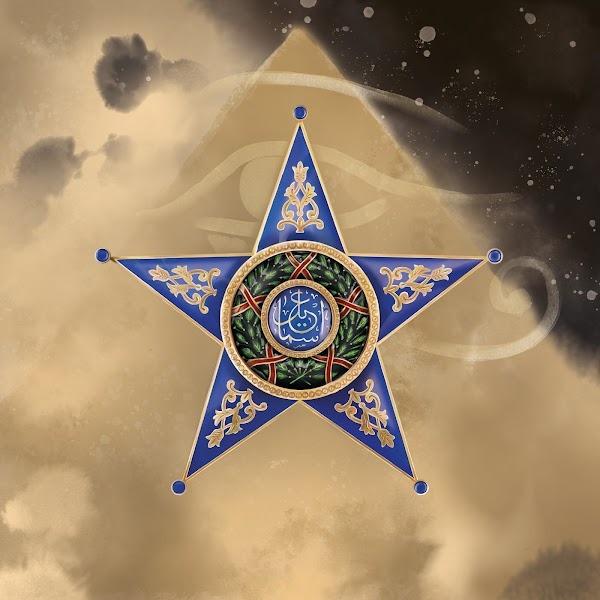
Above is the Twitter NFT image, from Order and Medal Club, @ordmedclub (https://twitter.com/ordmedclub/status/1470068669682266114/photo/1), probably posted "9:30 AM·Dec 12, 2021·Twitter Web App", with the statement “Order of Ismail is now available on Opensea”. This NFT image is derived partly from at least one illustration from a past eMedals auction of a 3rd Class Commander neck badge. The first illustration in the listing from a 23 July, 2019 auction, Item M0306-1 (shown below) exhibits several identical aspects to the NFT. I have shown that image before in a couple of posts, but it is best illustrated and discussed as the 17th photo in my post of 28 March, 2020. In that July 2019 post on this thread, I commented on the apparent combination of the Lattes-made gold and blue enameled star with a wreath that has the configuration of a Bichay-made element. The Bichay wreath is larger than Lattes wreaths so that it covers up the margin of gold at the most central portion of each of the star arms that surrounds the central medallion (see the third photo in this thread). The light reflections and shadows seen on the eMedals image of the Item: M0306-1 neck badge are identical to this on the NFT. The areas of light reflection on the central boss with the "Ismail" inscription on the NFT also match that photo eMedals photo precisely. The size of the wreath in the Twitter NFT image is the same size as on Item: M0306-1. This is of interest in sourcing the image for the NFT, as the eMedals neck badge from 23 July, 2019 auction is quite unusual in exhibiting a Lattes made star element (the Lattes maker’s mark on the reverse is illustrated in the eMedals listing) combined with a wreath element that does not match those seen on other Lattes made-piece, but exhibits the configuration seen only on Tewfik Bichay made badges. The size of the Bichay-made wreath on the eMedals M0306-1 is clearly larger than those by Lattes. As on the eMedals image, the frame of the central medallion on the NFT covers a thin circle of gold on the most proximal (central) portion of the star arms, that is visible on all normal J. Lattes badges. The wreath itself, does not appear borrowed from the photo of Item: M0306-1, its configuration of laurel fruit dots, leaves, the thickness of the green enamel (if this is based on a photo and not completely re-imaged), and the evenness of the gold and red enamel bands around the wreath are unlike those on Bichay-made wreaths. The wreath on the NFT image also is not the design seen on Lattes-made neck badges (see the 2nd eMedals example illustrated below as the 3rd photo in this post). The outline of the gold floral elements on the blue enamel of each arm on the NFT mostly closely resembles the form seen on the Item M0306-1 example, compared with other photos of Lattes 2nd and 3rd Class neck badges. However, this is not a diagnostic characteristic. The spacing between the outer edge of the gold-beaded medallion frame and the most proximal portion of the floral decoration on each of the arms is wider on the NFT than the M0306-1 piece. This wider space can be seen on other images of Lattes neck badges, such as the third image in this post, but several photos of these badges show similar spacing. This NFT has obviously done some computer image manipulation to remove he crown suspension device and to touch up some other aspects of this image. The space between the outer margin of the central gold medallion with beads and the most proximal portion of each of the gold floral ornamentation of each of the blue enamel arms has also been stretched, and the particular light reflection and shading seen only in the M0306-1 photo has been extended into that gap. The original eMedals photo is not very high resolution, and there has been sharpening of the image, quite apparent in how clear the engraving appears on the gold floral elements on the gold and blue enamel arms, the gold margins of the arms, and especially the gold surrounding the blue enamel of the ball finials on each arm. Additionally, the engraving of the gold floral elements is different from that on the 23 July, 2019 eMedals example. The M0306-1 badge shows two lateral engraving marks on the most distal flower and the NFT shows three. The eMedals photo also shows a common variant of the engraving on the paired blossoms in the center of the floral design that creates a “V outlining the middle petal of each of these twin blooms. The NFT shows a single engraved line that accents the most medial, and longer petal of each of those paired flowers. That form also is common on many examples (see the engraving on the second eMedals example below that shows the configuration replicated on the NFT). The NFT appears to show computer-generated augmentation of the actual engraving within the outlines of the floral decoration, that in my opinion most closely resemble the outline seen on the eMedals Item: M0306-1. As noted, the wreath on the NFT is the same size as the Bichay-made wreath on the Lattes star body of the eMedals Item: M0306-1, but the configuration is not that of a Bichay or Lattes-made neck badge wreath. The configuration of fruit dots is most similar to wreaths seen on Lattes-made 2nd Class breast stars (see the last photo in this thread). However, a few fruits may be anomalously-placed in each of the lower left and lower right panel (as separated by red and gold bands). The form of the leaves, the depth of the green enamel, and the evenness of the gold and red enamel bands are characteristic of Lattes wreaths. I have compared this NFT image to many other photos of both sash and neck badges, as well as 1st and 2nd class breast stars, to try and determination the combination of elements on the NFT. Perhaps a silly waste of time, instead of working on an upcoming post I’m preparing with photos of a few men wearing the Order of Ismail. However, my conclusion is that this NFT is principally based on the eMedals' image of an already chimeral example of a neck badge. It exhibits a wreath that is not consistent with either Bichay or Lattes neck or sash badges, but appears most likely either from, or based on, the wreath configurations of Lattes-made 2nd Class breast stars. Additional computer image manipulation has created this mosaic form based on the Order of Ismail neck or sash badge, but not an accurate artistic or manipulated image of this regalia element.
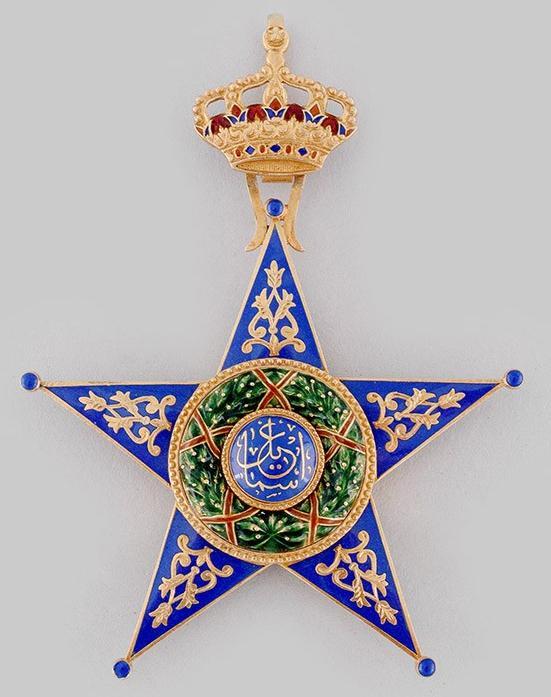
For comparison, here is a cropped version of the original eMedals image (from a 23 July, 2019 auction, item M0306-1; https://www.emedals.com/egypt-kingdom-an-order-of-ismail-in-gold-i-class-commander-by-j-lattes-c-1924) from which much of the above NFT on Twitter is derived. This example shows the larger size of the Tewfik Bichay-made wreath that has apparently been added to the Lattes star portion of this badge.
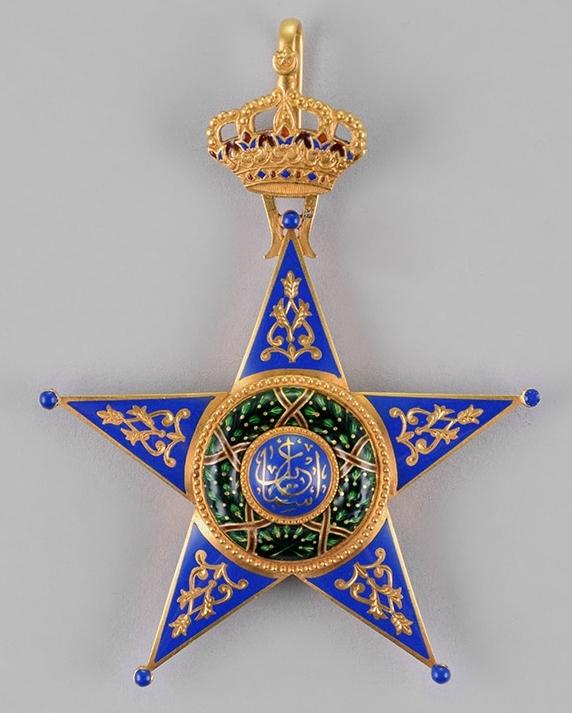
Image of a normal J. Lattes-made 3rd Class neck badge from an undated eMedals archived auction from the Dr. Albert Goodwin Collection, Item: EG814 (https://www.emedals.com/egypt-kingdom-an-order-of-ismail-in-gold-1st-class-commander-by-j-lattes-c-13259). This example shows the smaller size and different design configuration of the wreath of the Lattes pieces compared with the M0306-1 badge above.
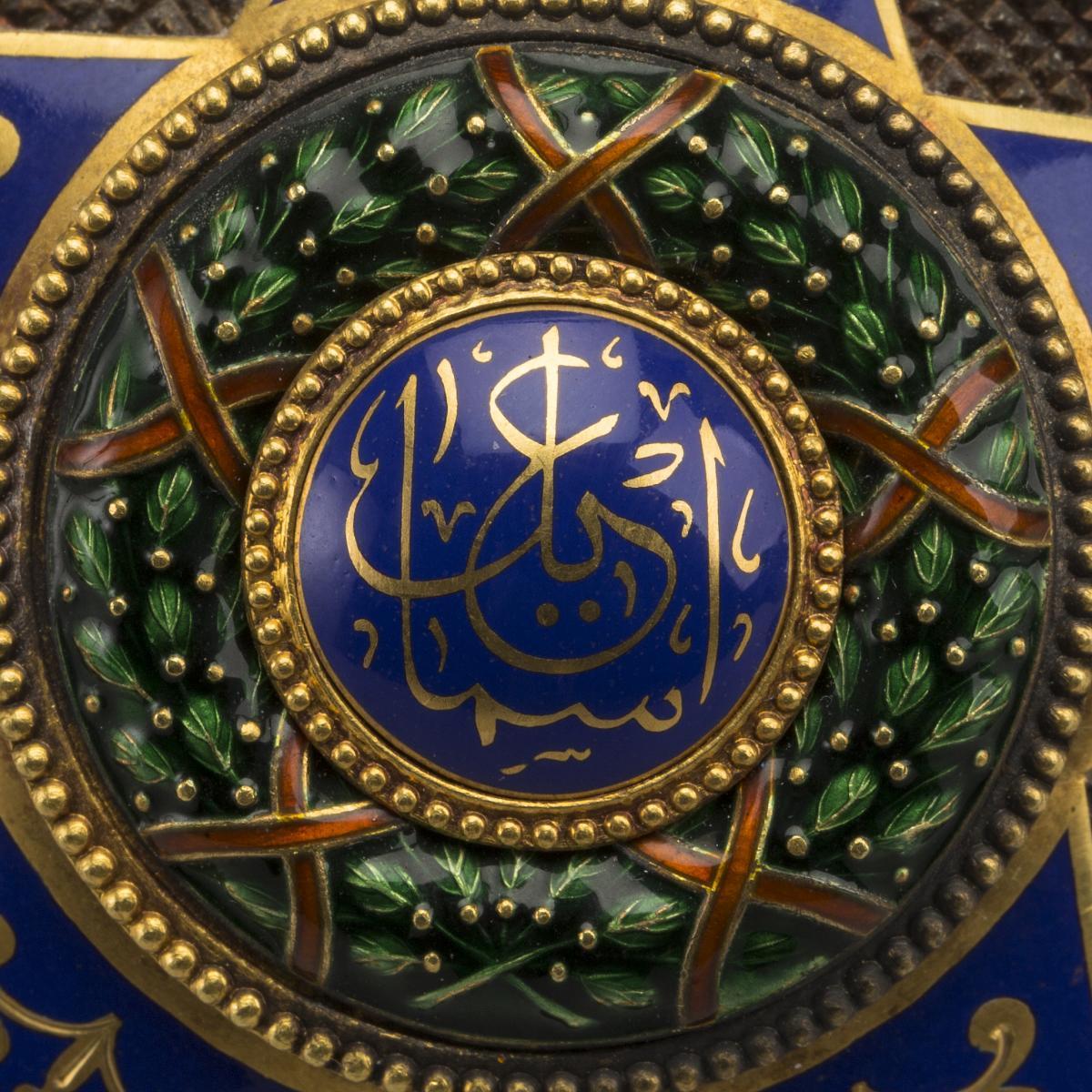
Cropped photo of the wreath from a J. Lattes-made 2nd Class breast star from a 6 April, 2017 auction by Bukowskis (https://www.bukowskis.com/en/lots/906427-the-order-of-ismail-nischan-al-ismail-22k-gold-lattes-in-kairo-1928-1928-weight-ca-47-g). This shows the greater similarity of the form of this wreath configuration to that in the NFT than either the Lattes or Bichay-made wreaths shown above.
0 -
I came across an unusual example of a probable Mixed Courts badge. This piece appears to address a previous question about the authenticity of another exceptionally atypical badge that I originally dismissed as an ornamental mock badge, not an official Mixed Courts badge. This second example suggests to me the possibility that a manufacturer created contemporary, but likely inexpensive, cast versions of this insignia that may well have been used by some judges on the Mixed Courts.
I initially found these images on a Facebook post of 5 January, 2021 by Robert Egeric on the Facebook page “ARABIC MEDALS & MILITARIA اوسمة ونياشين عربية عسكرية (https://www.facebook.com/groups/434957140007223/). The illustrations show the watermark for Northstar Militaria. The four photos from his Facebook posting show a gold & silver judge's badge in a case. Most interestingly, one of the images shows the name of the presumed maker of this badge on the inside of the upper case lid, and the name is one I have not encountered before as a manufacturer of Mixed Courts badges. Searching for these images on Northstar Militaria eventually led me to 17 photos showing this badge and its case. The following photos in this post are from the website of this Swedish phalersitics dealer site: Northstar Militaria (http://www.northstarmilitaria.com/product/judicial-badge/#).
The listing of this Mixed Court badge (SKU 0025) likely predates the 5 January Facebook posting by Robert Egeric, who is noted to have previously worked for Northstar Miliaria (according to his Facebook page). Other than the very modest listed price (compared with most recent auction price data for other Mixed Courts badges) of 1200 kr, (~US $132/~ €115, at current exchange rates) there is absolutely no information about this badge on the website, but there are 17 good-resolution images of this badge and its associated case. The badge appears to be silver and gold, although no materials are identified in the listing. There is no maker’s mark on the reverse, and the detailed photos show no evidence of any Egyptian silver hallmarks. The name on this inside upper lid of the case reads: “UNION DES GRAVEURS; D. IALANOS, A. DE LEO &. A. KASSANDRINOS; 5. RUE DE L’EGLISE COPTE; ALEXANDRIE (Egypte)”. I have not previously encountered the name of this business, and so far have not found any additional information, advertisements, or examples of work from this atelier. The workmanship is significantly less detailed than that of any other badge I have seen, even that of the one example I have found and illustrated here on GMIC that was made by Zivy Fréres & Cie. of Alexandria. However, the detailed images on the Northstar Militaria site appear to show that this piece was cast rather than struck (even the Zivy Fréres & Cie appears to have been struck). The rayed embellishment may be struck, but the photos of the mantle element appear to show this piece is cast. I am unsure about the central tablet with the inscription. The cut-out in the medal bed for the tunic pin indicates this is almost certainly the original case, suggesting an appropriate association of the case and badge. The calligraphy on the central tablet of this badge is unique in its configuration of the diacritical marks compared with all of the other inscriptions I have looked at for the other four identified manufactures of this badge and the four currently unidentified makers (summarized my post of 6 September, 2021 on this thread). However, the calligraphy exactly matches that on a very odd version of this badge that I previously dismissed as an unofficial and possible jewelry-version based on the official badge design (from a June 2019 auction by Lugdunum GmbH, Auction 16, Lot 289). The tablet on that badge with the same calligraphy as the Northstar Militaria badge is shown as the 5th-to-last image in my 6 September, 2021 post, in the section I titled "Odd non-official badges". My assessment was based on the much less-detailed nature of the execution of the badge design, its material, and the appearance that it was cast rather than being struck. The 2019 Lugdunum GmbH badge is made of bronze, a material that was not employed officially for any of these Mixed Courts badges. I previously illustrated the obverse and reverse of this unusual piece (listed in a June 2019 auction by Lugdunum GmbH, Auction 16, Lot 289, and formerly archived on the CoinArchives.com website) as the last 2 photos in my post of 14 August, 2019 on this thread. I have illustrated this badge again as the last 2 photos in this post for comparison.
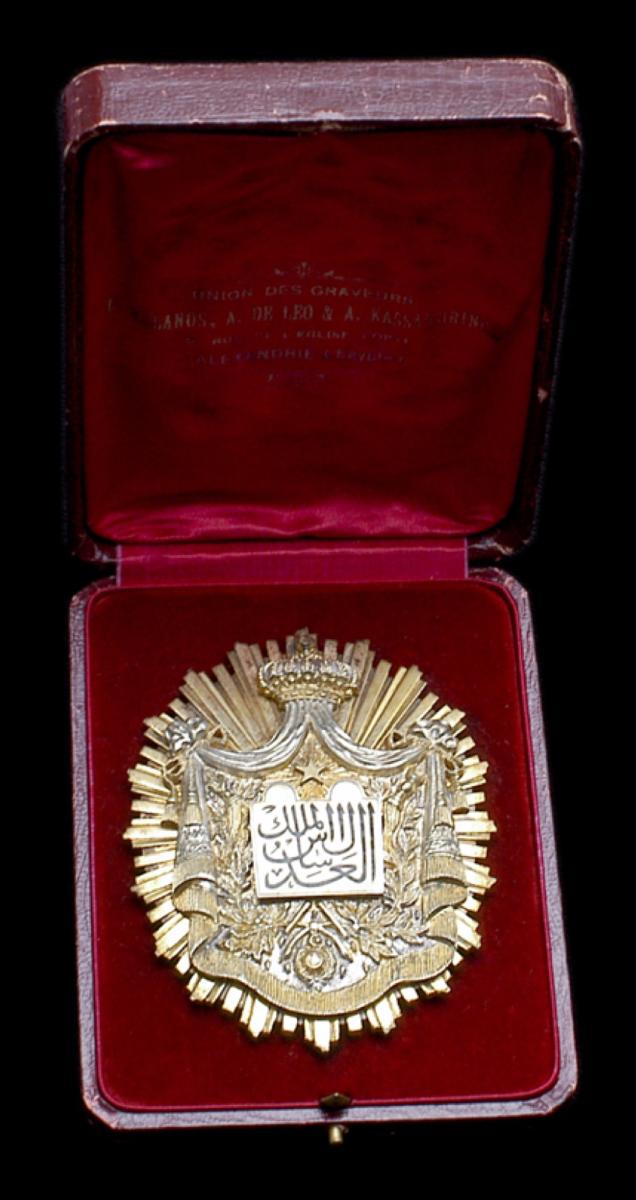
Low-resolution photo of the Northstar Militaria badge in its case. The inscription on the inner lid is unclear in this image but can be seen in the 17th below photo in this post. This and the other 16 photos of this badge and case are from: http://www.northstarmilitaria.com/product/judicial-badge/#.
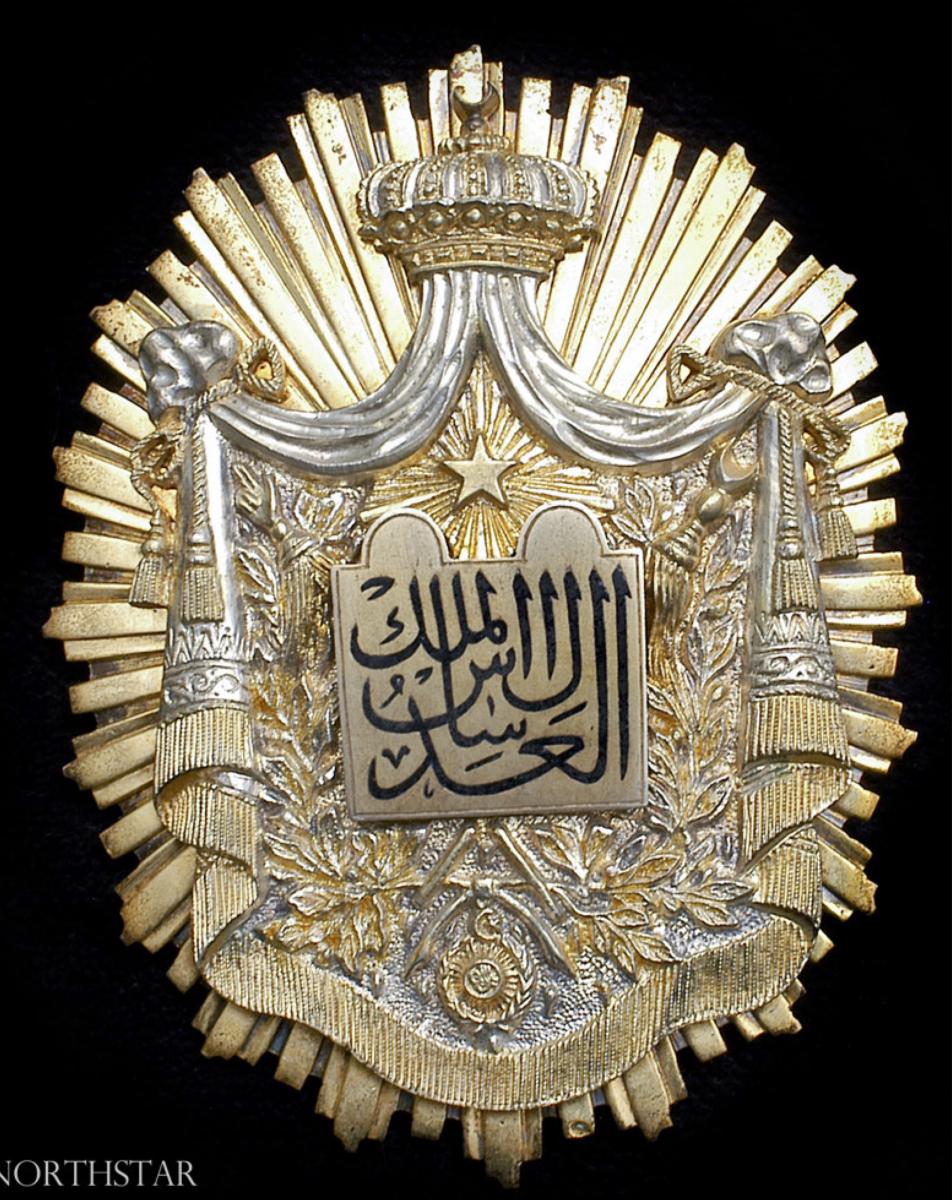
Moderately high-resolution image of the obverse of the Northstar Militaria silver and gold District Courts badge.This image can be zoomed for some additional details and comparison with the Lugdunum auction badge. A description of the significant detail contrasts in the design elements of this cast badge are discussed in my previous post of 14 August, 2019 on this thread, identifying the same differences in execution exhibited by this badge as seen on the Lugdunum GmbH, Auction 16, Lot 289 example compared with all other struck examples of these Mixed Courts badges. The 2nd-to-last photo in this post shows the obverse of the 2019 Lugundunum for comparison. The single bronze color of that badge more clearly shows the lower detailing of the cast elements of this manufacturer's versions of the Mixed Court badge design than in the silver and gold image above.
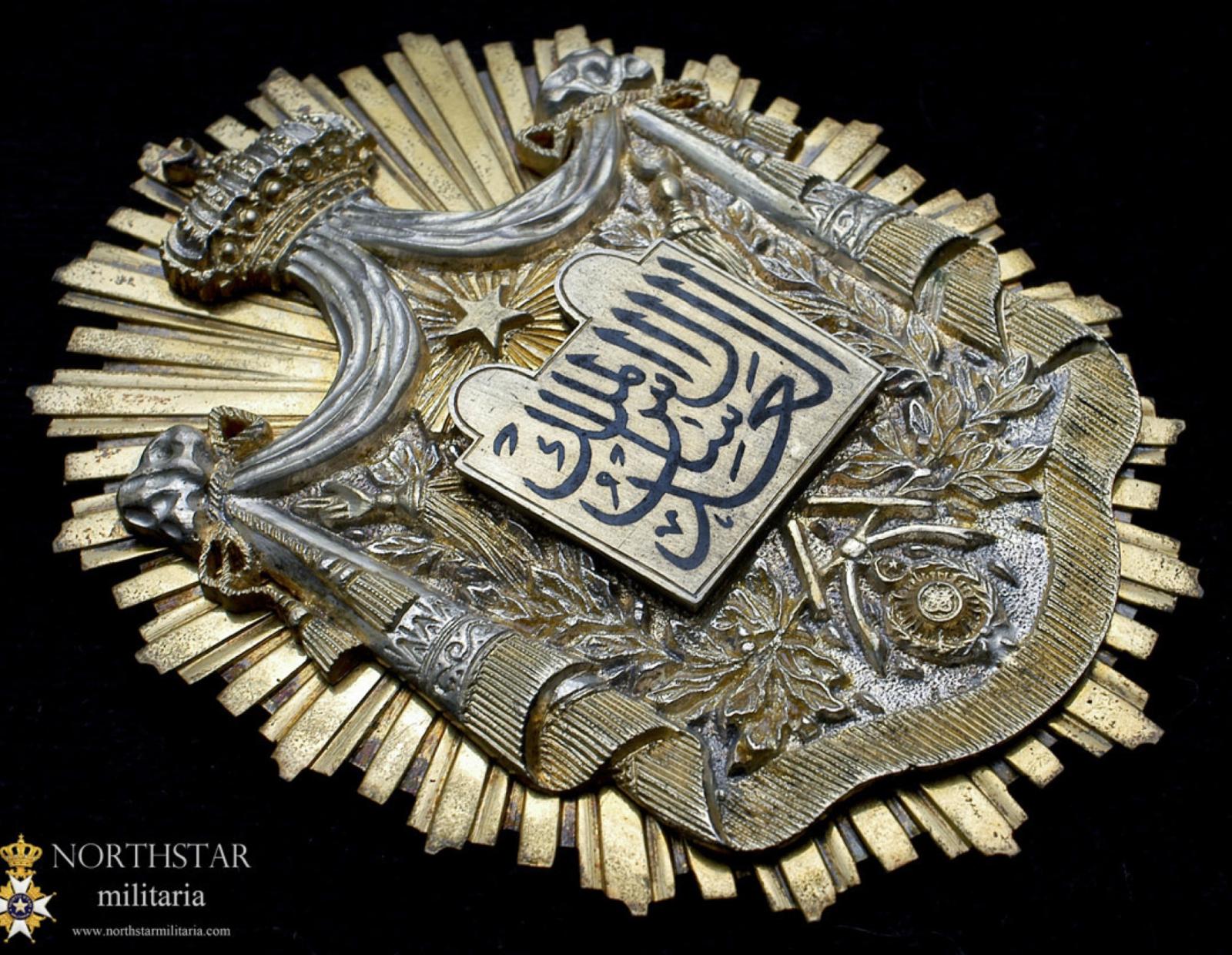
High-resolution oblique image of the obverse of the Northstar Militaria District courts badge. The probability that this badge is cast can be seen well in the form of the design elements of the mantle component in this view.
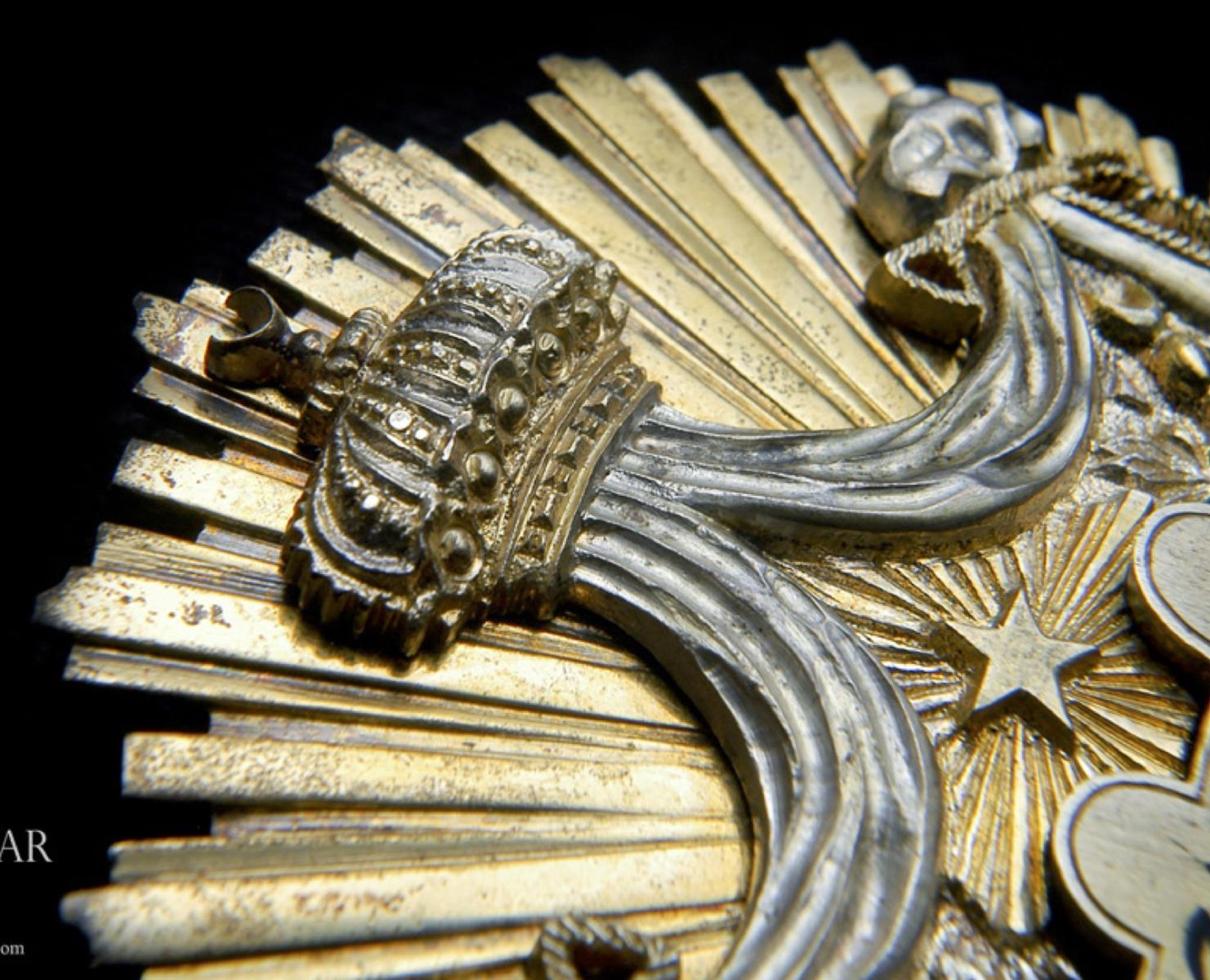
High-resolution oblique photo of the most superior crown element of this same Mixed Distict Courts badge.
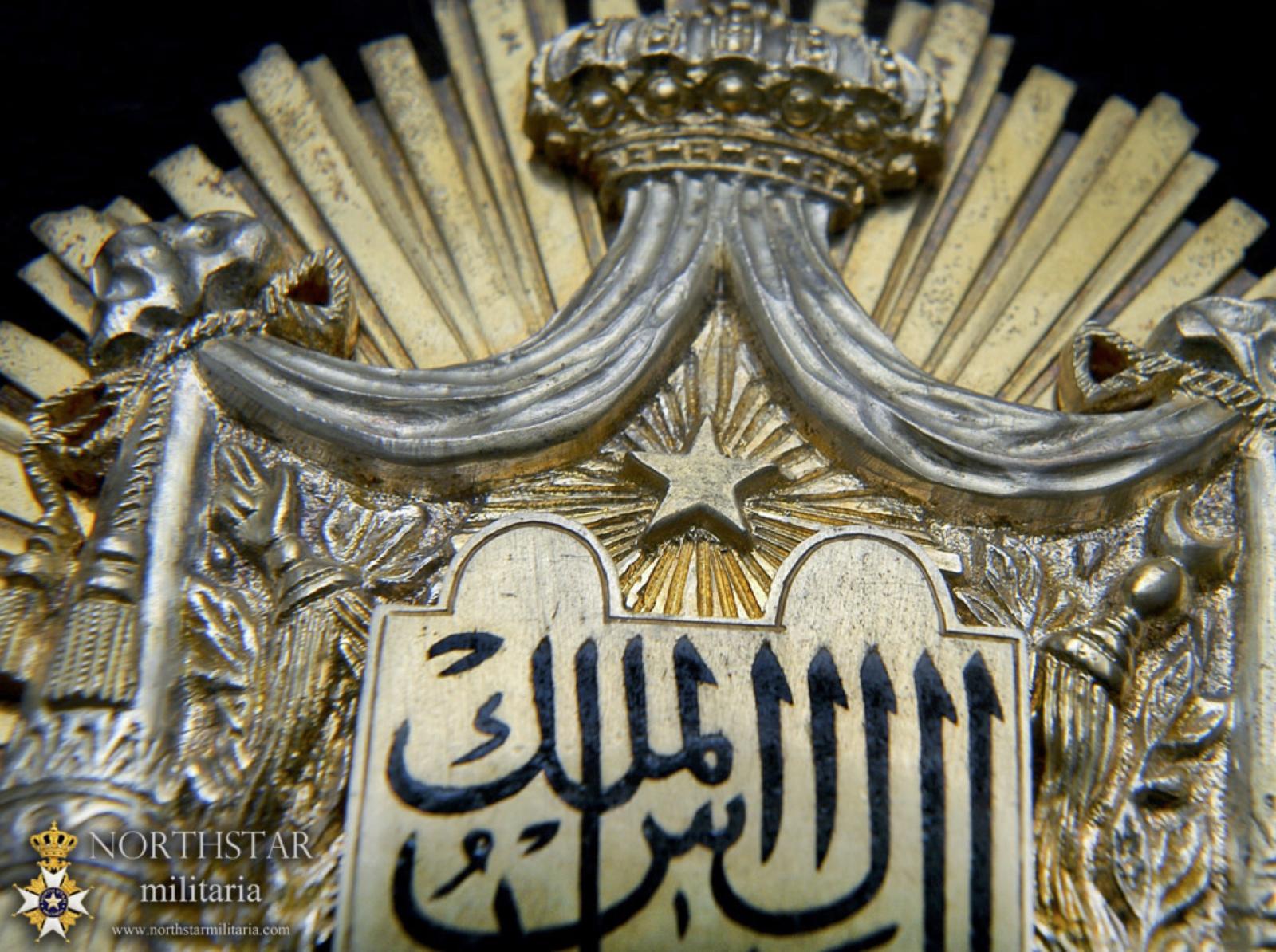
Another detailed high-resolution image of the superior portion of the design elements of this badge. Note especially the uniquely course and wide grooves of the rays around the star above the central inscribed tablet.
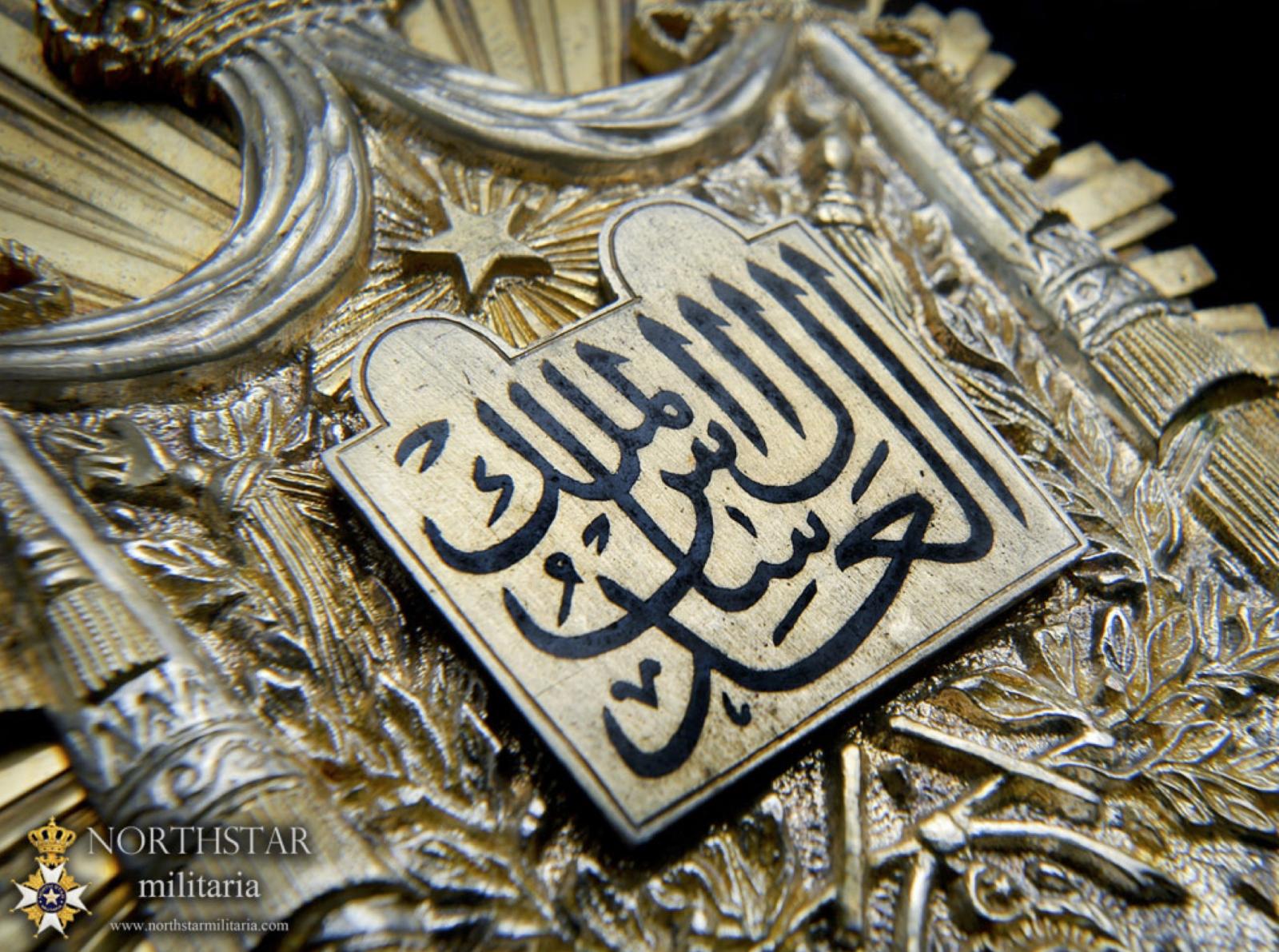
High-resolution photo of the central tablet and adjacent portions of the Northstar Militaria badge, showing the appearance that this badge is cast in the form of the laurel leaves on the right.

High-resolution photo of the inferior central portion of this badge. This image shows that the tugra in the center of the Order of Medjidie is oriented correctly, although it is not very detailed. The flat sides of the laurel and oak leaves, proximal ends of the shafts of the tugs below the central tablet, and the branches of the proximal laurel and oak branch stems appear cast. The view of the stipple-textured mantle, the appearance of the Order of Medjidie (especially the lowermost portion), and the ermine tails all strongly suggest that at least the mantle element of the badge is cast.
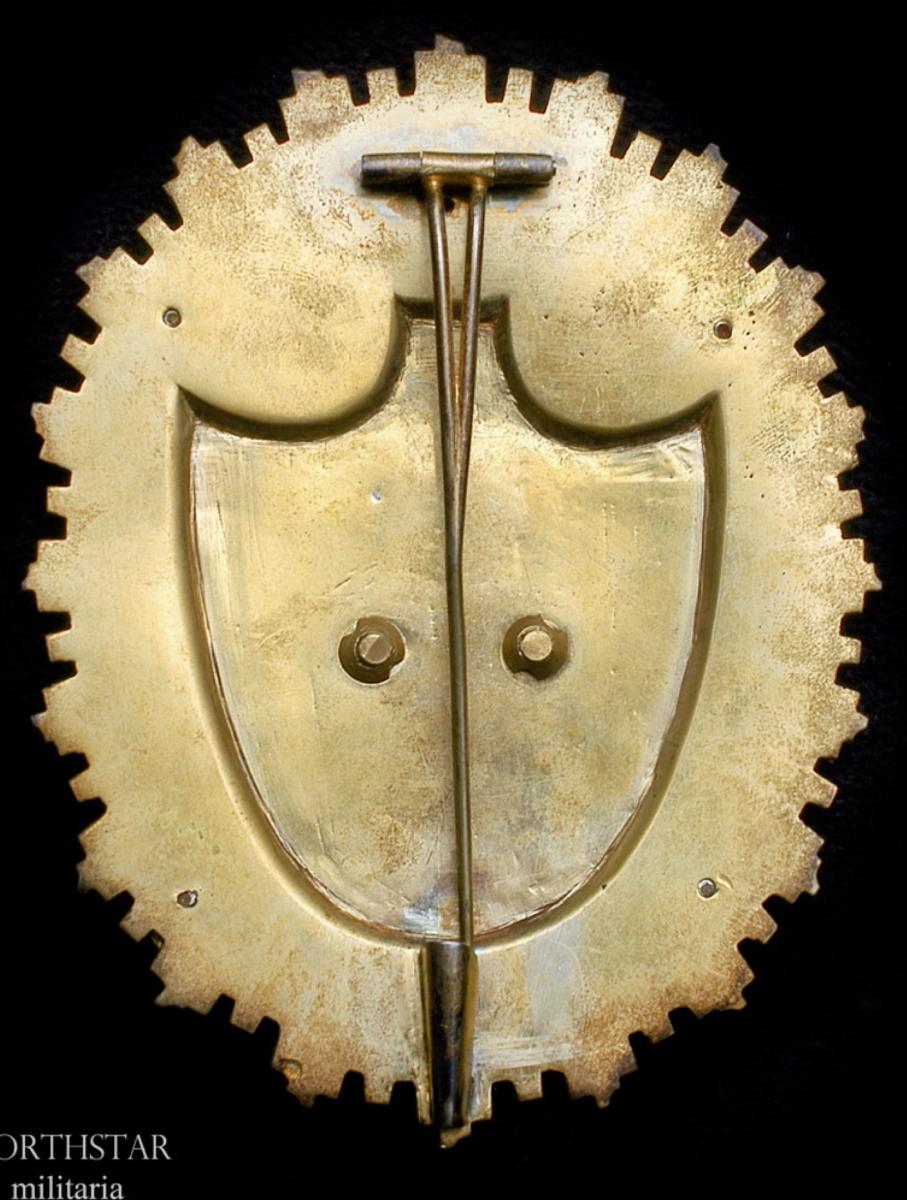
Image of the reverse of the Northstar Militaria silver and gold District Courts badge. There are no maker’s marks nor any Egyptian hallmarks on the reverse. Also note the form of the rivets that are unlike those on all other badges except those on the Lugdunum GmbH Lot 289 example.
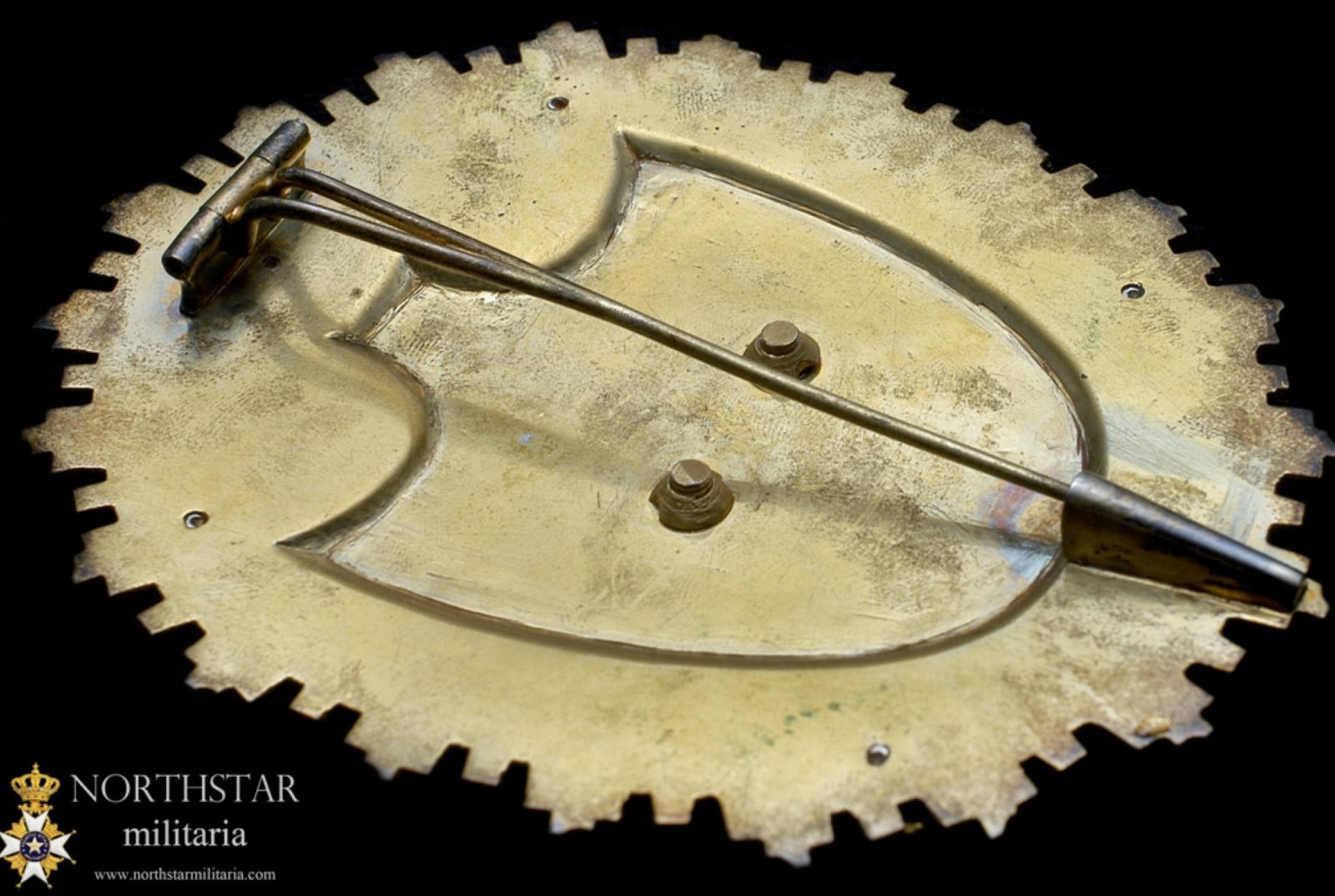
Oblique view of the reverse of this same badge. Although the foreground is unfocused, it shows that the mark on the lower longer ray to the viewer’s left of the pin catch is not any form of maker’s mark or Egyptian hallmark.
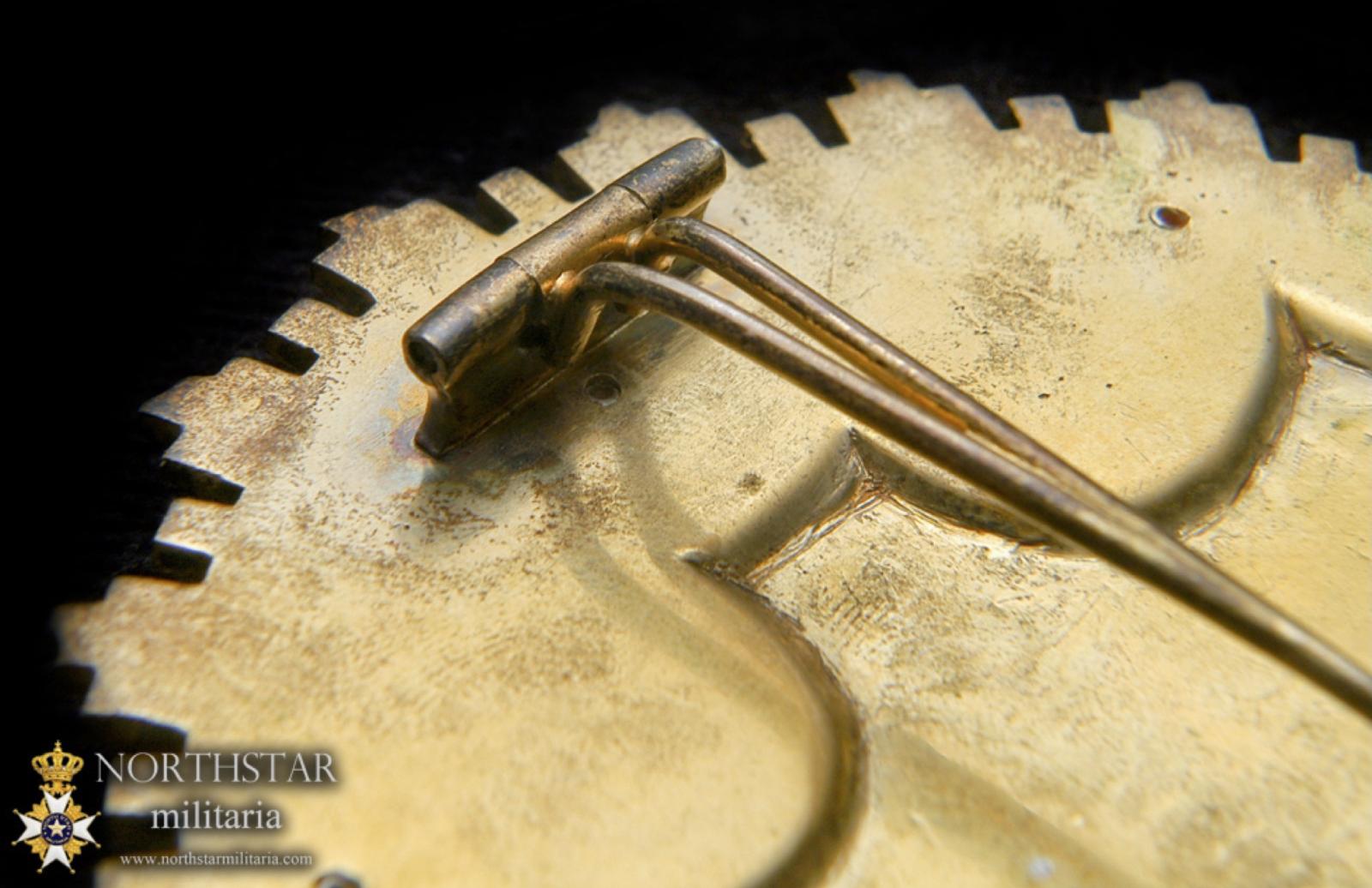
High-resolution close-up photo of the hinge portion of the tunic pin on this same badge.
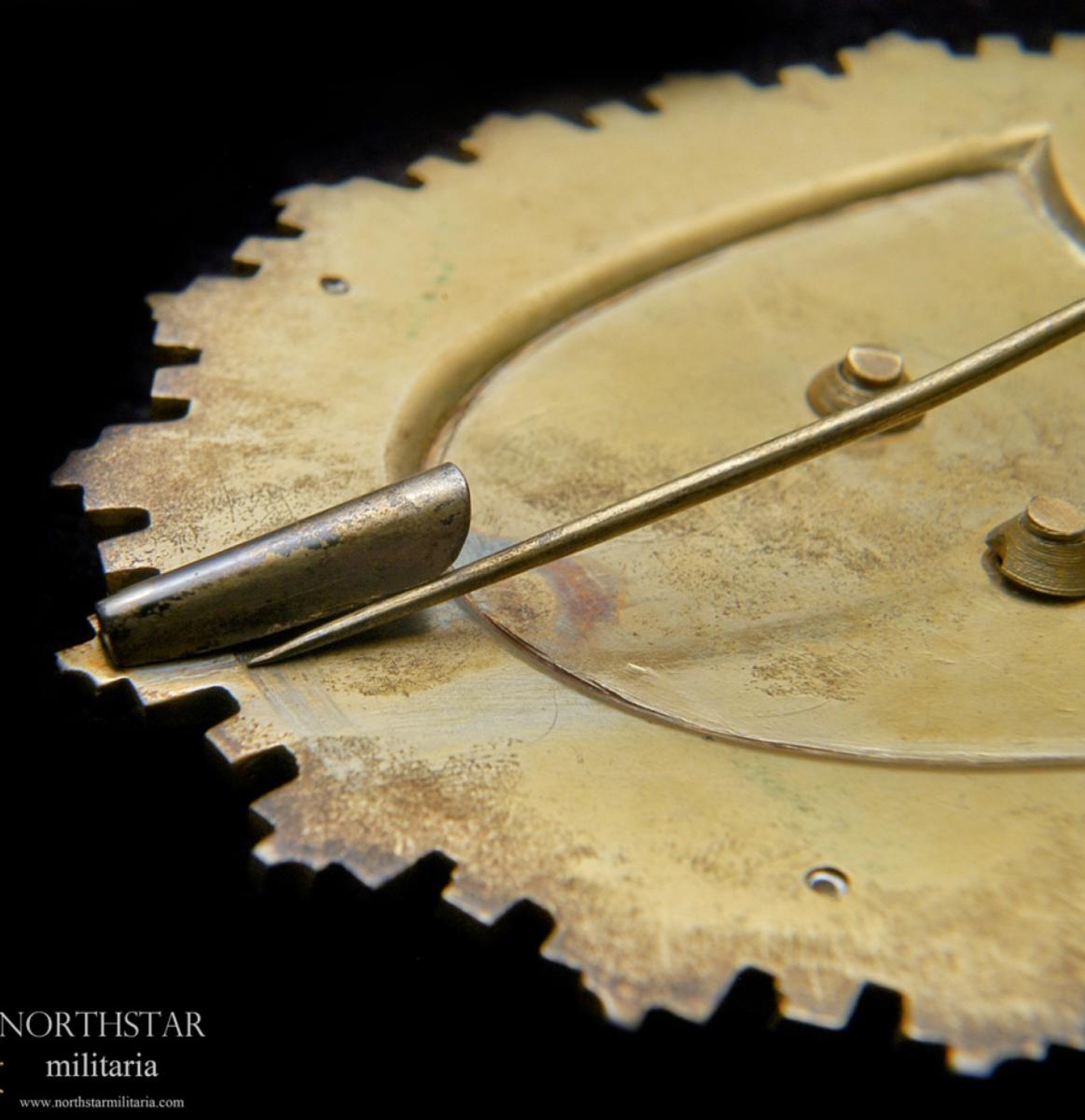
High-resolution close-up image of the catch of the tunic pin on the Northstar Militaria District Court badge. Note details of the rivets visible in this image.
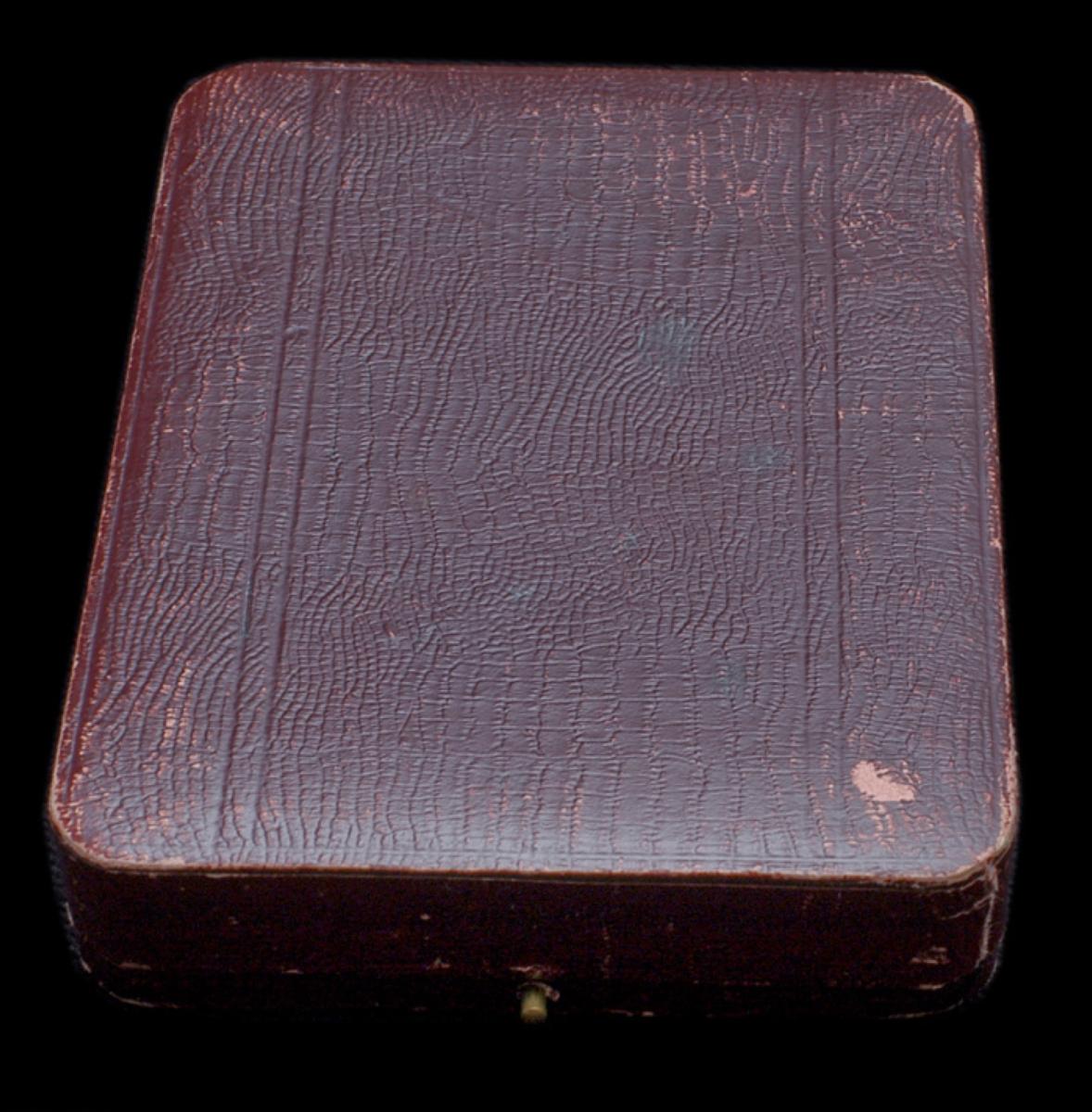
Photo of the closed upper case lid for this same Northstar Militaria badge showing the mock lizard texture of the paper case cover.

Image of the opened case showing the cut-out for the tunic pin and some of the detail of the catch for the case.
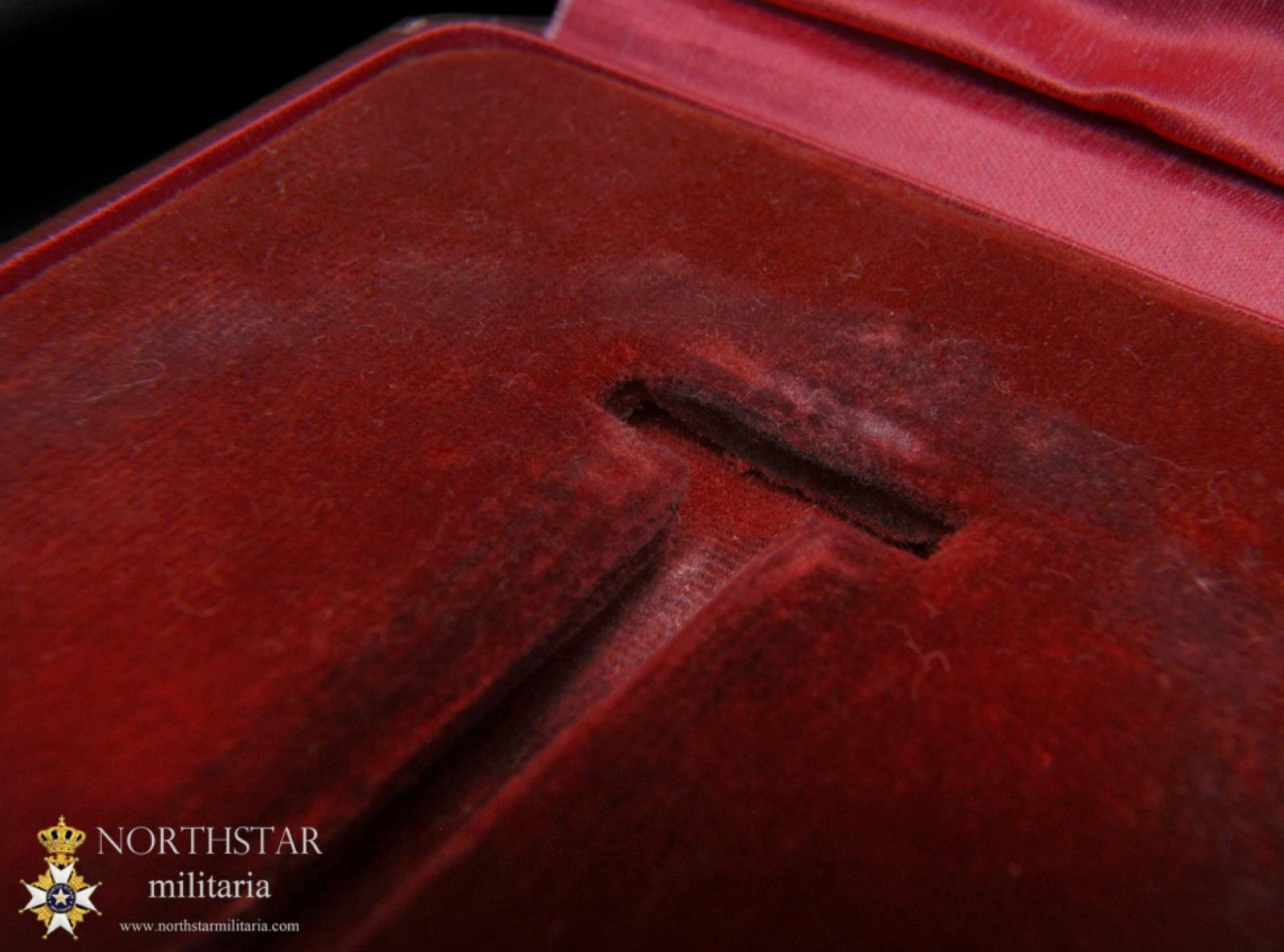
High-resolution close-up of the cut-out for the hinge of the tunic pin in the medal bed of the case.

High-resolution close-up of the release catch button on the exterior of the case, also detailing the mock-lizard texture of the maroon paper covering of the case.
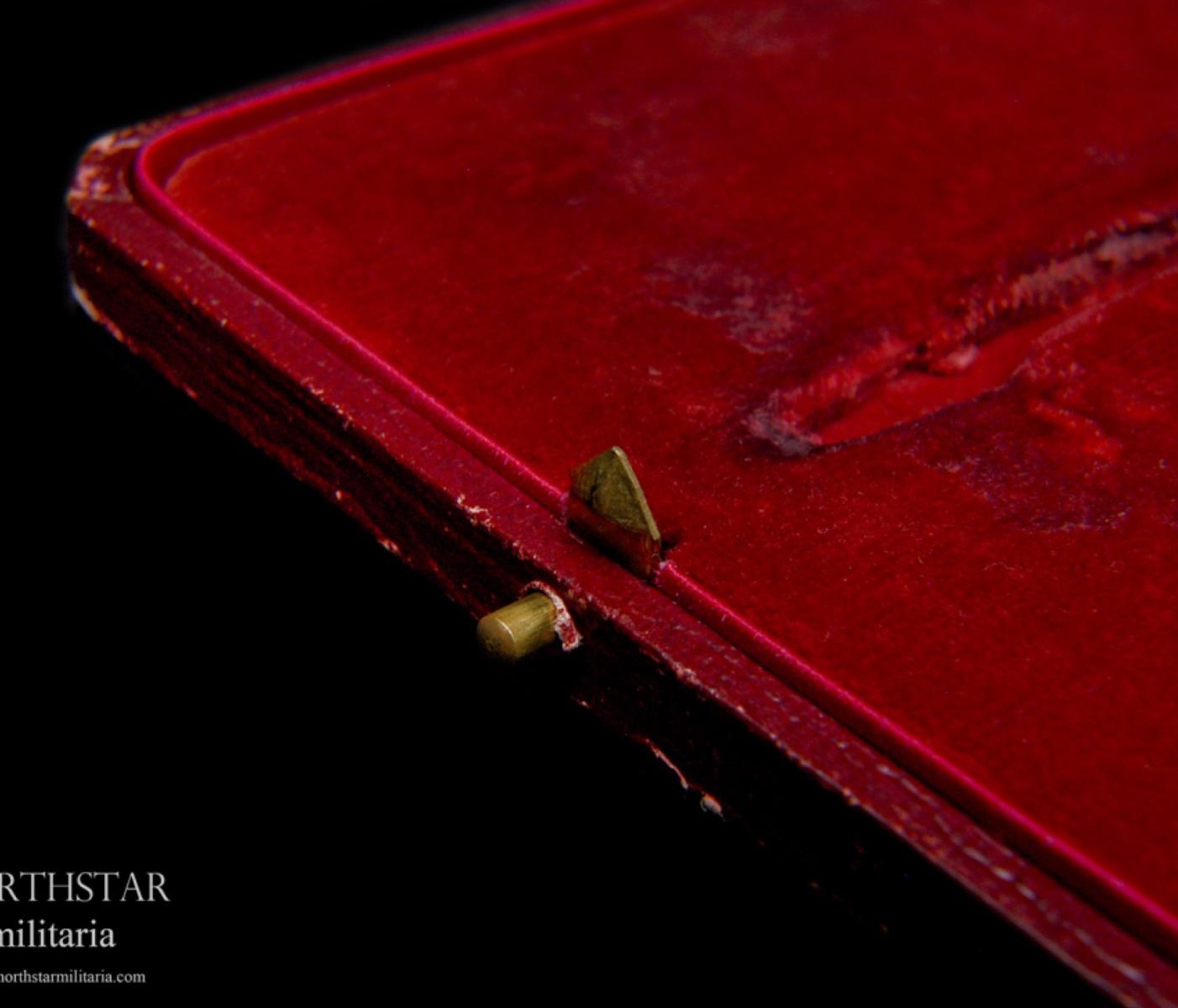
High-resolution close-up detailing the catch release tongue on the inside of the case.
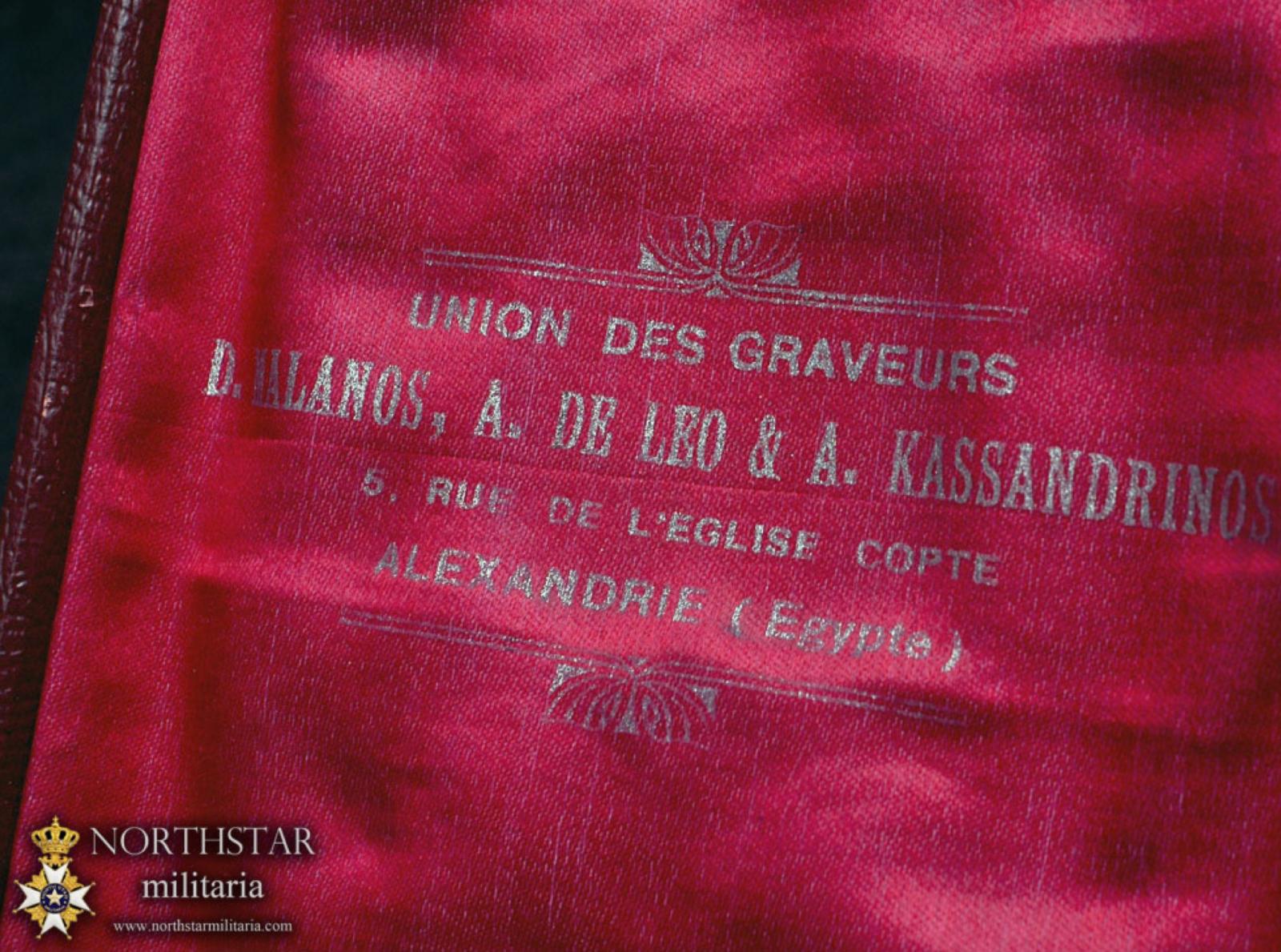
High-resolution close-up of the upper interior case lid showing the manufacturer’s name printed on the satin lining:
"UNION DES GRAVEURS; D. IALANOS, A. DE LEO &. A. KASSANDRINOS; 5. RUE DE L’EGLISE COPTE; ALEXANDRIE (Egypte)”
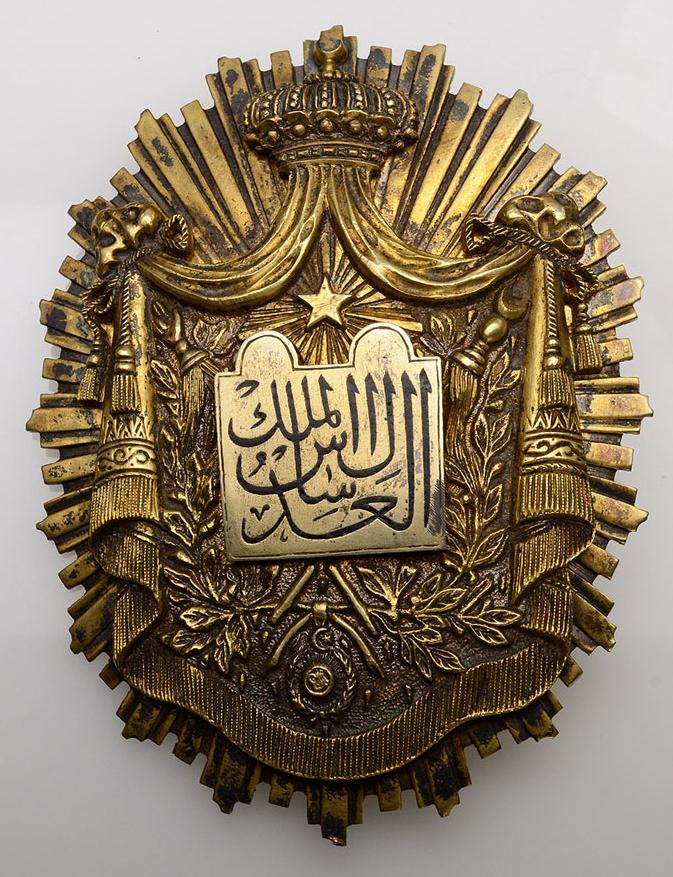
Image of the obverse of the unusual bronze badge from a June 2019 auction by Lugdunum GmbH, Auction 16, Lot 289, and formerly archived on the CoinArchives.com website (https://www.coinarchives.com/w/lotviewer.php?LotID=3972879&AucID=4100&Lot=289&Val=efc6a2fa2700e6a994f8217cb7d28a9c, no longer on that website). However, it is still archived on the NumisBids website (https://www.numisbids.com/n.php?p=lot&sid=3270&lot=289). I originally thought the coarser detail in the design execution, the evident casting of this piece, and especially its manufacture in bronze suggested it was not an actual Mixed Courts badge but a piece of jewelry inspired by these badges (see the pin from a December, 2018 auction by Bamfords Auctioneers & Valuers listing, Lot 3620A, that is very loosely adapted from the design of the Mixed Courts badges and clearly is not an official badge, that I illustrated and discussed in my post of 2 December, 2018 on this thread). Note the identical calligraphy on the enameled central tablet inscription to that on the Northstar Militaria example. The comparably more coarse details in the cast execution of the design elements are more readily apparent in the single bronze color of this example and are identical to those on the frontal view of the silver and gold Northstar Militaria badge.

Photo of the reverse of the Lugdunum Lot 289 bronze badge showing the engraved initials and the lack of any manufacturer’s mark or other hallmarks. The hinge and catch design are the same as on the Northstar Military example, however the breadth of the tunic pin is quite different from that example as well as all other Mixed Courts badges. Could this be a later replacement pin?
The two above Illustrations of the obverse and reverse of the unusual badge come from a June 2019 auction by Lugdunum GmbH, Auction 16, Lot 289, that were archived on the CoinArchives.com website (https://www.coinarchives.com/w/lotviewer.php?LotID=3972879&AucID=4100&Lot=289&Val=efc6a2fa2700e6a994f8217cb7d28a9c) and is still archived on the NumisBids.com website https://www.numisbids.com/n.php?p=lot&sid=3270&lot=289). The description of this badge identifies the material as bronze and gives measurements that are identical to those of all authentic badges (85 mm wide x 115 mm high, and weighing 196.22 g). The description identifies this badge as from Alexandria, which I dismissed in my original description of the badge in the 14 August post. A case was associated with this badge, but it was not illustrated, nor was there any descriptive identification of the maker. If it is the same maker as the Northstar Militaria case name (most likely given the identical workmanship), that would explain the association with Alexandria. A date of 1892 was identified for the badge, but I have no knowledge why that was stated in the description. This same June 2019 Lugdnum auction also included a clearly authentic silver example of a Mixed Courts badge (Auction 16, Lot 288). I illustrated and described that silver badge made by Froment-Meurice in my 14 August, 2019 post on this thread (it is still archived on the NumisBids website: https://www.numisbids.com/n.php?p=lot&sid=3270&lot=288). The 1st photo in that post shows the obverse of this silver badge, and the 2nd image shows the reverse, marked “FROMENT-MEURICE” and bearing the less commonly seen (on Mixed Courts badges) French diamond mark with the name “FROMENT” over a rose with the name “MEURICE” below the rose (shown as the 3rd image in that 14 August post, and a few other posts on this thread as well). The above unusual bronze badge is shown as the 4th photo (obverse) and 5th photo (reverse) of that 14 August, 2019 post. As noted there, the reverse bears the inscribed initials "A." followed by either "I." or "J.", "S.", "T.", or possibly "G.", that are likely the initials of its owner. As with the Northstar Militaria example, there is no manufacturer’s mark on the reverse nor any of the 3 Egyptian assay, material (inappropriate on the Lugdunum example as there was no assay control nor mark for the Egyptian manufacture of bronze jewelry), or date hallmarks. The fastening rivets of this Lugdunum example are also identical to those on the Northstar Militaria piece, that are different than those seen on all other Mixed Courts badges.
My original assessment of the Lugdunum GmbH piece as a mock-badge and probably a piece of jewelry is likely wrong, based on this comparable Northstar Militaria example in the silver and gold scheme of a District Courts badge. These two cast pieces may represent more economical versions of the Mixed Court badges, suggesting judges and court officials had to buy their own court regalia. Perhaps if the Northstar Militaria example was genuinely used as an inexpensive version of a Mixed District Courts badge in silver and gold (but why are no assay, Egyptian made-silver, or date hallmarks are present if this really is silver and gilt?), then the bronze material of the Lugdunum badge might have been a substitute for the gold of the Appeals Court judicial badges (not worn by any other court officials, who wore silver badges). The presence of two examples of the cast badge, one in bronze that may imitate the color of a gold Appeals Court judges’ badges, and the other in the silver and gold pattern of District Courts judges badges, are a bit surprising if my inference about economy is the reason for such lower-quality versions of these insignia. Jasper Yeates Brinton in his book The Mixed Courts of Egypt, 1931 Yale University Press, New Haven, provides information on salaries of Mixed Courts’ officials. He states that the compensation was quite generous by contemporary standards, for both Egyptian nationals and foreigners (pp. 83-86). Economic need may not have driven the market response in producing such a potentially less expensively-crafted cast insignia. Although that could have been a concern for individual officials, the fact that D. Ialanos, A. de Leo, & A. Kassandrinos appears to have manufactured at least Appeals Court and District Courts judges’ badges (I have not yet seen any such cast silver badges, and many more officials wore these regalia, as also evidenced in the greater number of silver badges that appear on the current auction market) suggests a demand among some of the relatively large number of judges for what must have been less expensive badges than the struck versions made by Froment-Meurice, Stobbe, Horovitz, at least four other currently unidentified manufactures, and the least detailed Zivy Fréres & Cie. pieces. Whether such demand was due to personal economic need or less interest by some judges for expensive insignia of their office cannot be resolved probably without contemporary letter or journal references to reasons for such frugality.
0 -
I came across a few photos of Abdeen Palace that show displays of some of the Egyptian orders and medals, along with other images on the foursquare.com website. These photos were posted to the FOURSQUARE CITY GUIDES website on 30 January, 2020 by Abdulrahma (https://foursquare.com/v/abdeen-palace--قصر-عابدين/4f169cc8e4b0044a28561a2a?openPhotoId=5e32a4d26a961f00085b600b).
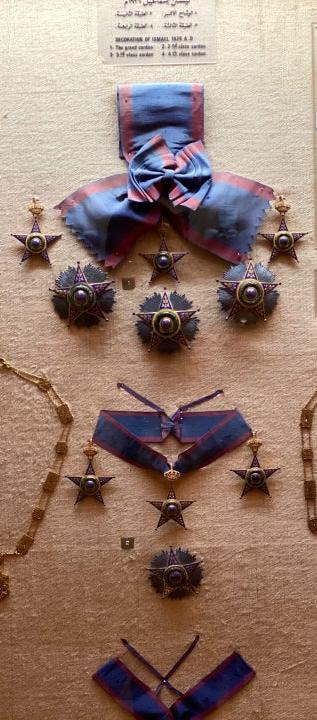
Above is part of a cropped version of a larger, low-resolution photo centered on a display of different classes of the Order of Ismail. From top to bottom: a 1st Class Grand Cordon Order of Ismail sash, a sash badge attached to the sash, two sash badges exhibited to either side of the sash, and three 1st class breast stars arrayed under the sash (all marked with the number 1); 2nd Class Grand Officer Order of Ismail (marked with a number 2) neck ribbon with attached neck badge, flanked by 2 additional neck badges, and one breast star (the 2nd Class regalia are displayed between 2 examples of the Collar of Fuad I); at bottom is part of the neck ribbon of a 3rd Class Commander Order of Ismail. Presumably, below the 3rd Class regalia is a 4th Class Officer breast badge of the Order of Ismail as well.
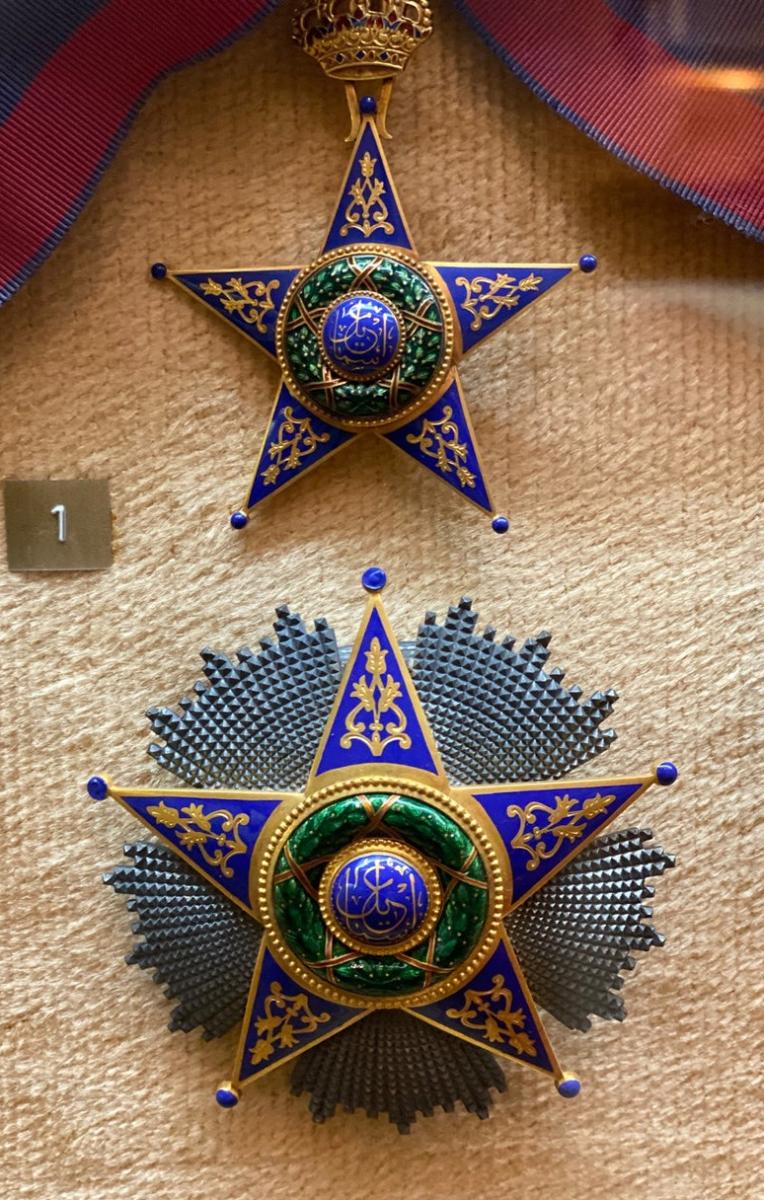
Above is a slightly cropped version of a separate higher-resolution photo of the 1st Class Grand Cordon sash badge & breast star of the Order of Ismail, as seen in the above image of the Abdeen Palace display. This moderate-resolution photo can be zoomed for slightly better details of the sash badge and breast star. The wreath configuration of the sash badge clearly shows this is a J. Lattes-made piece (the distribution of the gold laurel fruit dots, form of the leaves, the thickness and even design of the gold and red bands around the wreath). The sash badge shows 3 lateral engraving marks on the most distal flower of each gold and blue enamel arm of the star with a single mark in the middle petal. The 2 middle flowers each exhibit 3 lateral marks and a single engraved mark in the medial longer petal. Although the image of the sash badge is not very high resolution, the other engraved marks in the floral elements of the star arms do appear to be elegantly executed examples of the best workmanship coming out of the Lattes workshop (not surprising as these were probably intended for either King Farouk I, or another member of the royal family, i.e., see the 7th photo in my post of 2 April, 2019 showing prince Soliman Daoud at the far R wearing the breast star of the Order of Ismai, possibly 1st Class). I cannot distinguish details of any of the 3 Egyptian gold hallmarks on the right suspension link between the most superior arm of the star and the crown suspension element, and cannot assess what the date hallmark may be.
The configuration of the wreath on the breast star may suggest it is the work of Tewfik Bichay rather than J. Lattes. The image is not good enough resolution for easy comparison of the gold laurel fruit dots distributions visual on this piece with other 1st Class examples made by Lattes and Bichay (distinctive between 1st and 2nd Class breast stars of the Order of Ismail, and between J. Lattes and T. Bichay-made pieces). However, the pattern of the fruit dots is very similar to that seen in the 8th illustration of my post of 31 January, 2020 on this thread, showing a 1st Class Grand Cordon breast star from a fall 2014 auction by by Künker Münzauktionen und Goldhandel, Lot 1512, (https://www.kuenker.de/en/archiv/stueck/58396) that was made by Tewfik Bichay (the auction listing shows the Bichay maker’s marks on the reverse of the sash badge and breast star). The gold and red enamel bands may also exhibit the thinner and less-even execution that also help distinguish differences between manufacture by Lattes or Bichay. Although the photo does not permit a clear evaluation of the maker, it appears likely that this breast star is not the paired Lattes-made breast star that should accompany the illustrated sash badge, but a Bichay-made breast star that has been inadvertently mounted with the Lattes sash badge. The presence of 2 additional 1st Class breast stars mounted for display with this Grand Cordon "set", suggests that one of the other breast stars may be the Lattes breast star that is the mate to the sash badge. It may also indicate a likelihood that at last one of the extra sash badges mounted with this Grand Cordon set (or the 2 neck badges mounted with the 2nd Class Grand Officer set) may be Bichay-made badges. As noted in several post on this thread, there are no differences between 1st Class sash badges, the 2nd Class neck badges, or the 3rd Class neck badges, except that the number and configuration of gold fruit dots, the gold and red enamel bands, and the diameter are distinctly dissimilar between Lattes and Bichay-made examples. I do not know where, or from whom, the Abdeen Palace may have obtained these insignia, but it appears their associations have been jumbled. The presence of 2 additional 1st Class breast stars mounted for display with the sash badge attached to the sash, suggests that one of the other breast stars may be the Lattes breast star that is the mate to the sash badge illustrated above attached to the sash. It may also indicate a likelihood that at last one of the extra sash badges mounted with this Grand Cordon set (and/or the 2 neck badges mounted with the 2nd Class Grand Officer set) may be Bichay-made pieces. If multiple examples of 3rd Class neck badges are in this display, that would additionally complicate sorting out associated regalia. Only examination of the reverse for maker's marks and date hallmarks could resolve this. The above illustration of the breast star exhibits a similar configuration of engraving marks in the distal flower and the paired flowers in the star’s gold and blue enamel arms, however the execution on the breast star is a bit less elegant. This engraving is not distinctive of manufacture by Lattes or Bichay. On this example, the 3 lateral marks and distal marks in each flower seem fairly short compared with the engraving on other pieces. The photo shows engraving in the paired stems that terminate at the proximal end of the most distal flowers, in addition to the usual flowing engraving ornamenting the other stem elements. The marks on the oval where the stems of the 2 central flowers originate may show 2 deeper marks, rather than a single mark as seen on most examples. There also appears to be a small mark just distal of this gold oval in the base of the paired stems supporting the 2 central flowers that I have not seen on most (all?) other Order of Ismail breast stars.
0




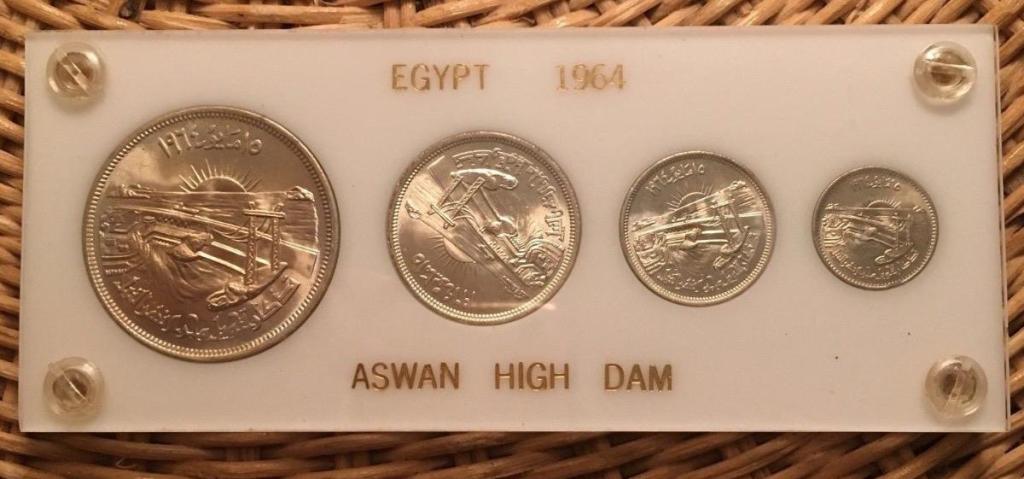


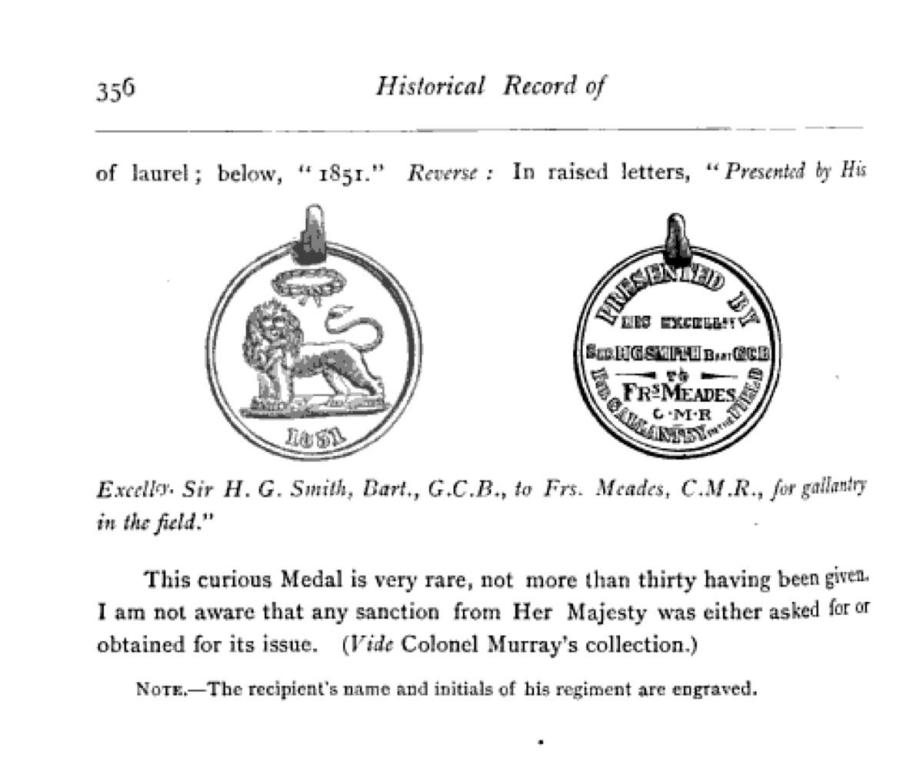

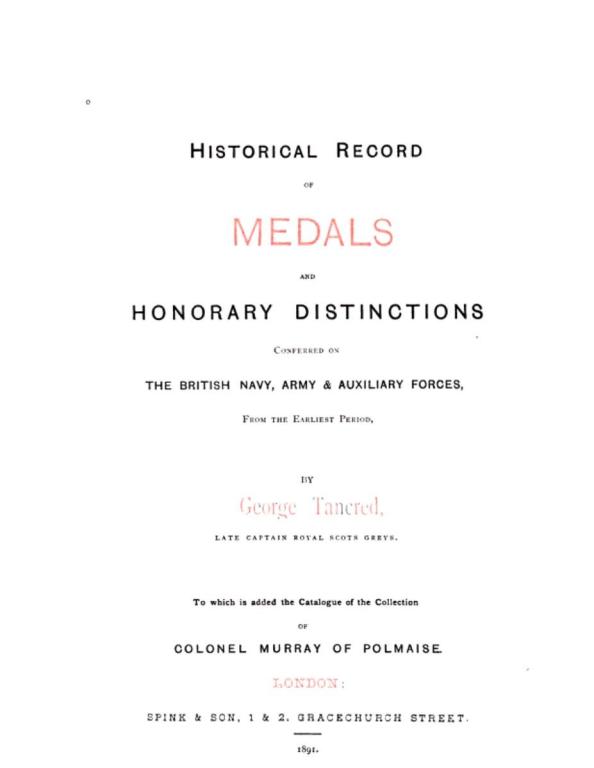
Question about the Order of Ismail/Nishan al-Ismail
in Middle East & Arab States
Posted · Edited by Rusty Greaves
Owain recently alerted me to an auction sale of a “set” of the 1st Class Grand Cordon Order of Ismail. He also helped me with the high-resolution images from that offering. This example comes from a 21 May, 2022 auction (69. Lot 241) by Auktionshaus Carsten Zeige (https://www.zeige.com/vorschau/41.pdf), archived as high-resolution images on the Saleroom.com website (https://www.the-saleroom.com/en-gb/auction-catalogues/auktionshaus-carsten-zeige/catalogue-id-srauktionsh10012/lot-5aa63c15-e9e3-4c06-a6f1-ae7c00e6d400).
High-resolution image of this alleged 1st Class Grand Cordon "set" of the Order of Ismail from a May 2022 auction by Carsten Zeige in a case showing sash, sash badge, and breast star. All of the images from the archived Saleroom listing of the 21 May Auktionshaus Carsten Zeige auction can be zoomed for additional details.
This auction lot is presented as though it represents a “set" of the 1st Class Grand Cordon Order of Ismail with the sash and case. The sash badge is identified as weighing 47.0 g, but the weight of the breast star is not given and no dimensions are given for either of the insignia. Photos clearly show the Lattes maker's marks on the reverse (also noted in the description) of each piece and the 3 Egyptian hallmarks for gold (on the sash badge) and silver of the breast star. However, the two pieces have different Egyptian date hallmarks (the sash badge has the “A”= 1925-1926 and the breast star is marked “Y” = 1923-1924.).The engraving on the gold floral elements of the gold and blue enamel star arms on the breast star are completely unlike those on the sash badge. This form of more elaborate engraving can be seen in photos of two other breast stars and one sash badge that is associated with one of those breast stars. I posted images of those pieces and a discussion of the strikingly different engraving in my post of 31 January, 2020 that, at the time, appeared anomalous to me. However, with a 4th example surfacing (3 breast stars and one neck badge) it seems this may have been an elaboration, possibly available either for special customers or individuals willing to pay for the extra engraving. The photos in this post represent all of the examples that I have encountered from online auction listings that show this more elaborate engraving (and the three, other than the Carsten Zeige example, that I have previously illustrated on this thread). Another interesting anomaly of all of these pieces is that they have wreaths that are unlike the normal Lattes configuration. Three of these insignia, including the Carsten Zeige piece, have wreaths that are identical to those encountered on Tewfik Bichay-made examples of the Order of Ismail. The Fritz Rudolf Künker example has an unusual form of the wreath not seen on any other Order of Ismail I have encountered. The Carsten Zeige 1st Class breast star, the 2nd Class neck badge and breast star from the three 2013 La Galerie Numismatique auctions archived on the Liveauctioneers.com website, and the Fritz Rudolf Künker 30 January, 2020 auction (331, Lot 1074) (30 January, 2020), Lot 1074 breast star interestingly are marked “LATTES”, but exhibit forms of the wreath unlike the vast majority of Lattes-made insignia. As the chief craftsman for the Lattes workshop, perhaps Tewfik Bichay was tasked to do the specialized custom engraving seen on these 3 breast stars and one neck badge, assembling them with a form of the wreath that later featured on pieces under his own maker’s mark. No pieces marked with Tewfik Bichay’s mark exhibit this unusual engraving, they all exhibit the forms of engraving of the gold floral elements quite similar to that seen on almost all Lattes-made awards (except those shown here).
A slightly closer view of the regalia in this Carsten Zeige recent auction offering displayed in the case.
Above is a very high-resolution image of the sash badge of this alleged set from the recent Carsten Zeige auction. The configuration is the normal design for Lattes workmanship. The wreath has the correct number & distribution of laurel fruit dots in the wreath as seen on other Lattes sash badges, 2nd and 3rd Class neck badges. The wreath is the correct size for Lattes pieces. The form of the leaves and thickness of the green enamel also is consistent with the design and execution seen on almost all Lattes made Order of Ismail regalia. I have detailed in several entries on this thread a couple examples of either sash badges or neck badges marked “LATTES” that appear to have the Bichay form of the wreath. I do not know if this was a contemporary substitution for the usual, slightly smaller and differently constructed “Lattes-style” of the wreath if that was unavailable or a possible recent repair using the different “Bichay-made” wreaths. If the use of an alternative wreath was an occasional practice at Maison Lattes, such a use of a different wreath was extremely uncommon, although all of these unusually engraved examples have forms of wreaths that are principally found on Tewfik Bichay-made reaglia. The engraving on the gold floral elements of the gold and blue enamel star arms of the Zeige sash badge is within the normal variation seen on most Lattes-made sash and neck badges. The engraving on this neck badge exhibits 3 lateral marks on the most distal flower of each arm with a single central engraving mark in the central petal. The 2 paired central flowers show 3 lateral marks and a single distal and a single distal mark generally oriented with longer medial petal of each flower. The engraving in the stems & leaves also is typical of all Lattes pieces. The Cairo assay office mark for 18 carat gold is visible on the attachment from the most superior arm to the crown suspension device. There is some loss or damage to at least 2 of the red enamel “jewel” ornaments on the crown’s headband. As noted, the lack of the same form of engraving as seen on the breast star offered with this sash and sash badge and the slightly later assay date for this piece suggests a high probability that they are not an associated set but a combined grouping.
Reverse of the same sash badge showing the “LATTES” maker’s mark above the 3 Egyptian hallmarks (L-R: the Cairo assay office mark for 18 carat gold; the ibis mark for Egyptian-made gold; and the “A” date hallmark for 1925-1926. The same 3 Egyptian gold hallmarks are visible on the reverse of the suspension loop that attaches to the sash. No hallmarks are present on the reverse of the crown as seen on some examples.
Above is a very high-resolution image of the breast star offered with the sash, sash badge, and case in this Lot 241 listing from the recent 21 May, 2022 Carsten Zeige auction. This image is not oriented vertically because the image in the original Carsten Zeige catalog illustration and the Saleroom version is shown incorrectly with the inferior margin of the star pointing to the 11:00 o’clock position. It is unlikely that the central boss has been rotated. The images of the star in the medal bed of the case shows it in the correct orientation (and it would be fit into the cut outs for the tunic pin and other clips). Also the image of the reverse shows the Lattes mark in the correct position with the tunic pin oriented correctly. This piece exhibits much more elaborate engraving on the gold floral decorations on the gold and blue enamel star arms than most examples of the Order of Ismail. I have only seen this form of engraving on 2 other examples of Order of Ismail breast stars and one neck badge (all illustrated below). One of those examples is a 2nd Class Grand Officer neck badge with breast star that both exhibit the same more complex engraving (shown as the 4th photo below). I am assuming that those insignia probably represent a true associated set with the same form of unusual engraving on both elements of the insignia. I have discussed the unique components of the engraving of the two similar pieces in the first part of my post of 31 January, 2020 here on this thread. Given that the La Galerie Numismatique neck badge and breast star both have the same more detailed engraving, I suspect this Carsten Zeige offering combines a normally configured Lattes sash badge that could be from another set (or a neck badge from either a 2nd or 3rd Class award) with this specially ornamented breast star. I also infer that the differences in dates may also suggest that these 2 pieces are not an associated set. It is, of course, possible that hallmarking of a sash badge (“A”=1925-26) could have happened just after the beginning of 1925 while the hallmarking of the breast star (“Y”=1923-1924) could have been done at the end of 1924 and they might be contemporaneous. However, because there is an extant example of a breast star and neck badge that both share the same more elaborate engraving, and the slight dating difference in the Zeige insignia, I think there is a very strong probability that the Carsten Zeige offering is not an original set, but pieces combined for sale as a more valuable boxed 1st Class “set”. As noted on all the other examples with this more detailed engraving, the wreath on the above piece is not a Lattes configuration. It is identical to Tewfik Bichay-made wreaths for 1st Class breast stars, but not Lattes made 1st or even 2nd Class stars. The configuration of the laurel fruit dots is identical to that those shown on the breast star I illustrated as the 8th photo in my post of 31 January 2020 on this thread, that is a Tewfik Bichay-made 1st Class star from a fall 2014 auction by Künker Münzauktionen und Goldhandel (https://www.kuenker.de/en/archiv/stueck/58396). The gold and red enamel bands of this wreath also exhibit the thinner width, with a slightly irregular outline as seen on Bichay wreaths but not on unquestionable Lattes ones. The leaves of the wreath also exhibit the longer, thinner, configuration, showing less prominent veins, with thinner green enamel that contrasts with Lattes wreath elements. The set of 2nd Class neck badge and breast star with the similar more-detailed engraving from the 2013 La Galerie Numismatiqie auctions also appear to show Bichay-made wreaths on both regalia elements that also are marked “LATTES” on their reverse.
High-resolution photo of the reverse of the same Zeige breast star showing the “LATTES” maker’s mark (although only “LA…S” is visible) and the 3 Egyptian silver hallmarks in the usual location, the longest ray to the viewer’s right of the central long inferior ray (from top-bottom: the Cairo assay office mark for 900 silver, the cat hallmark for Egyptian-made silver before 1946; and the date hallmark “Y”=1923-1924). It is of course possible that some pieces coming out of the Lattes workshop had wreaths that resemble those on pieces made and marked with Tewfik Bichay’s name, perhaps Bichay was making some of those in the form that would eventually characterize his own later work when he took over the Lattes workshop. However, 1925 seems a bit early for the suspected changeover, that likely occurred sometime either in the late 1920s or in the early-mid 1930s (given that Lattes pieces with later data hallmarks than 1925 are common). The earliest Order of Ismail marked with Bichay's name that I have seen in 1929. Owain has suggested that comparing date hallmarks on other awards (where good photos or reliable descriptions can identify those date hallmarks) that shift from being made by Lattes to Bichay-made would be the most productive day to try and bracket this change. The Order of the Nile would likely be a good Order to sample as many more were distributed than other Orders and they are quite common in auction offerings.
Image of the obverse of a 2nd Class Grand Officer set of the Order of Ismail with identical detailed anomalous engraving to the breast star in the Lot 241 offering by Carsten Zeige. More detailed images of the engraving on each of the neck badge and breast star are shown below. This comes from a flickr image on Hassan Kamal-Kelisi Morali’s flickr site (https://www.flickr.com/photos/kelisli/8844318688/). He notes that the images and measurements come from an auction listing on La Galerie Numismatique, although the link provided is now a dead end. The Liveauctioneers website (https://www.liveauctioneers.com/search/?keyword=Order of Ismail&page=1&pageSize=24&sort=-relevance&status=archive) archives 3 past listings for this set from past La Galerie Numismatique auction listings (Lot 0185 of 3 March 2013; Lot 0442 of 23 June, 2013; & Lot 0300 of 20 September, 2013). The same 4 images presented here are part of each of the La Galerie Numimatique listings (archived on the Liveautioneers.com website). Those auction descriptions provide the measurement of the neck badge as 60 mm and its weight as 48.6 g. The breast star is 70 mm in diameter and weighs 81.25 g, and is identified (correctly with that dimension of the breast star) as a Grand Officer set. The description does not identify any maker’s marks. However, photos of the reverse are provided in each of these 2013 archived auction listings on the Liveauctioneers website that show the “LATTES” name on the reverse of both the neck badge and breasts star. In this case, the same unusual engraving on both the neck badge and breast star supports the likelihood that it is an associated set (unlike the recent Carsten Zeige "set" where the sash badge does not show any of the more elaborate engraving seen on the breast star). As noted previously on this thread, this image is one of the most commonly re-used photos used for illustrating the Order of Ismail. I did not notice for a significant period of time that this image shows a very anomalous engraving configuration on this award.
Photo of the reverse of the same set of neck badge and breast star showing the “LATTES” makers marks. This image is not high-enough resolution to read either the gold date hallmarks on the neck badge or the silver hallmarks on the breast star. This and the following 2 images detailing the obverse of the neck badge and breast star also come from each of the 2013 La Galerie Numismatique auction offerings of this set that are archived on the Liveauctioneers website.
Above is a high-resolution image of the same neck badge from the La Galerie Numismatique 2013 auctions showing well the engraving on the gold floral elements of the gold and blue enamel arms of the star. This photo can be zoomed for some additional details of the engraving and the wreath. The engraving on the gold floral elements of the arms is almost identical to the form of the engraving on the associated breast star. The only difference is that the neck badge does not have any engraving within the stems of the two paired central flowers on each arm that originate in a shared round point. The other parts of this engraving are nearly identical to that on the Carsten Zeige auction example. The wreath on this piece is not the typical work of Lattes workshop but is identical to those made by Tewfik Bichay. First, it is slightly larger than normal Lattes wreaths, covering some of the gold margin around the central medallion. The gold and red enamel bands appear thinner, more wavy (less regular) than those on Lattes pieces. The configuration of the laurel fruit dots also does not match their placement on Lattes pieces, but matches those on Tewfik Bichay-made insignia. Again, the form of the leaves and thinner green enamel is a characteristic of Bichay-made wreath elements, it is not at all the usual form of Lattes wreaths. I have seen a couple examples of sash or neck badges that appear to me to be Lattes medals (marked) apparently refit with Bichay-made wreaths that show this same covering of the gold margin around the central medallion, and this same very different pattern of laurel fruit dots, the red bands around the wreath, and the different forms of the leaves and the thinner green enamel. Given the predominance of the normal Lattes made wreaths, the use of the different configuration wreath (seen on all marked Bichay regalia) is infrequent enough that it does not appear to be part of the normal variation in the Lattes workshop manufacture of these pieces.
Above is a high-resolution image of the breast star from this same 2nd Class set of insignia from the La Galerie Numismatique auctions with the comparable unique form of engraving. This can be enlarged for more details. This comes from a flickr image on Hassan Kamal-Kelisi Morali’s flickr site and is identified as measuring 70 mm in diameter, and weighing 81.25 g. The dimension identifies the size as that of a 2nd Class Grand Officer breast star. I previously illustrated and described the engraving on this breast star as the second photo in my post of 31 January, 2020 on this thread. The engraving of the gold floral elements of the gold and blue enamel arms is essentially identical to that on the recent Auktionshaus Carsten Zeige example detailed in the 5th photo above and to that seen on the Fritz Rudolf Künker Auction 331, Lot 1074 example shown below. The configuration of fruit dots on the wreath of the above star are consistent with Bichay-made 2nd Class pieces, not the vast majority of pieces marked “LATTES”.
Very high-resolution image of the obverse of the Fritz Rudolf Künker Auction 331 (30 January, 2020), Lot 1074 example (https://www.kuenker.de/en/archiv/stueck/251846). This is identified as a Grand Cordon breast star (the size, given as 82.0 X 80.5 cm, which is the dimension of the 1st Class breast star). This high resolution image first alerted me to the existence of a few examples of the Order of Ismail with distinctly more elaborate engraving on the gold floral elements of the gold and blue enamel star arms. The engraving pattern on the gold floral decorations of the 5 gold & enamel arms of the star is clearly quite different from most Lattes or Bichay examples. The date hallmark of “Y” is visible in the images provided on the Fritz Rudolf Künker description, indicating an assay date of 1923-1924. I illustrated this as the first photo in my post of 31 January, 2020 and discussed the unusual engraving and wreath configuration. The engraving on the gold floral elements of the star arms is almost identical to that on the Auktionshaus Carsten Zeige example and the 2nd Class neck badge and breast star from the 2013 La Galerie Numismatic auction piece. The wreath on this piece does not match either Lattes or Bichay forms seen on other 1st Class breast stars. The number and placement of the gold laurel fruit dots is distinctly different than any other Lattes or Bichay wreaths. The form of the leaves, the thinner and less even gold and red enamel bands around the wreath all looks more like Bichay's work, but the overall design and execution are unique to this piece.
Reverse of the Fritz Rudolf Künker 1st Class breast star showing the presence the "LATTES" maker's mark and the position of the 3 Egyptian hallmarks on the the longest ray to the viewer’s right of the central longest inferior ray (the same location as on Carsten Zeige piece, this is the most common position for these hallmarks on breast stars).
Cropped images of the "LATTES" name on the central boss of the reverse of the Fritz Rudolf Künker breast star. On the right are the 3 Egyptian silver hallmarks (stamped in the same location as this on the Carsten Zeige star): L-R: Cairo assay office mark for 900 silver; the cat hallmark indicating Egyptian-made silver before 1946; and the date hallmark "Y"=1923-1924.